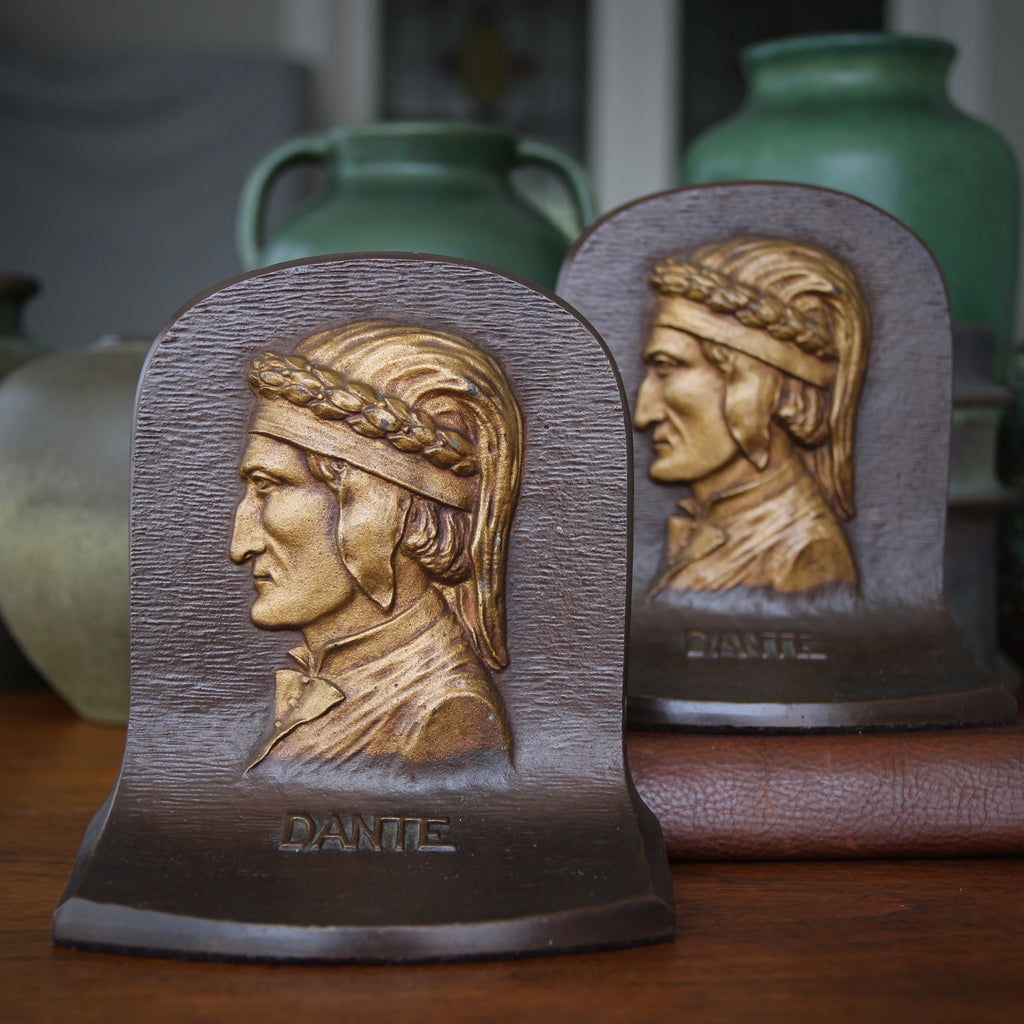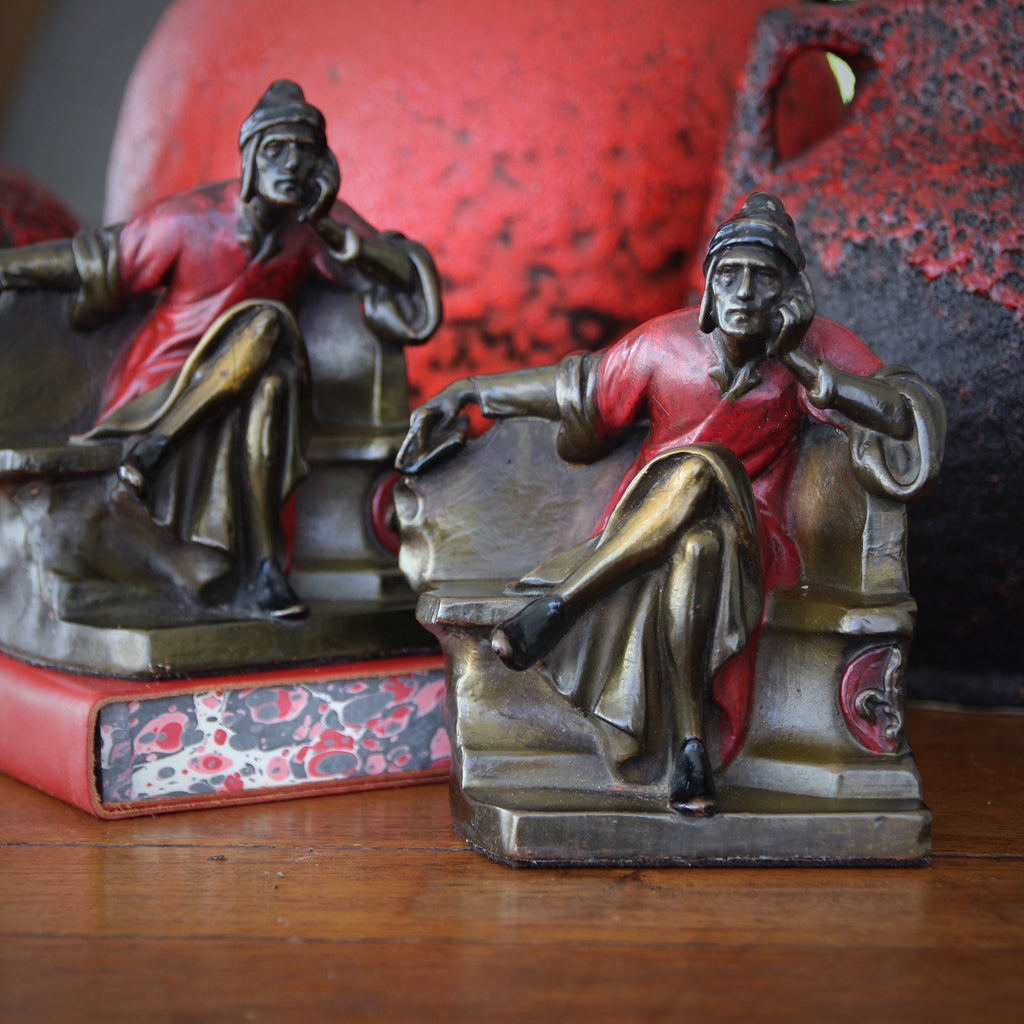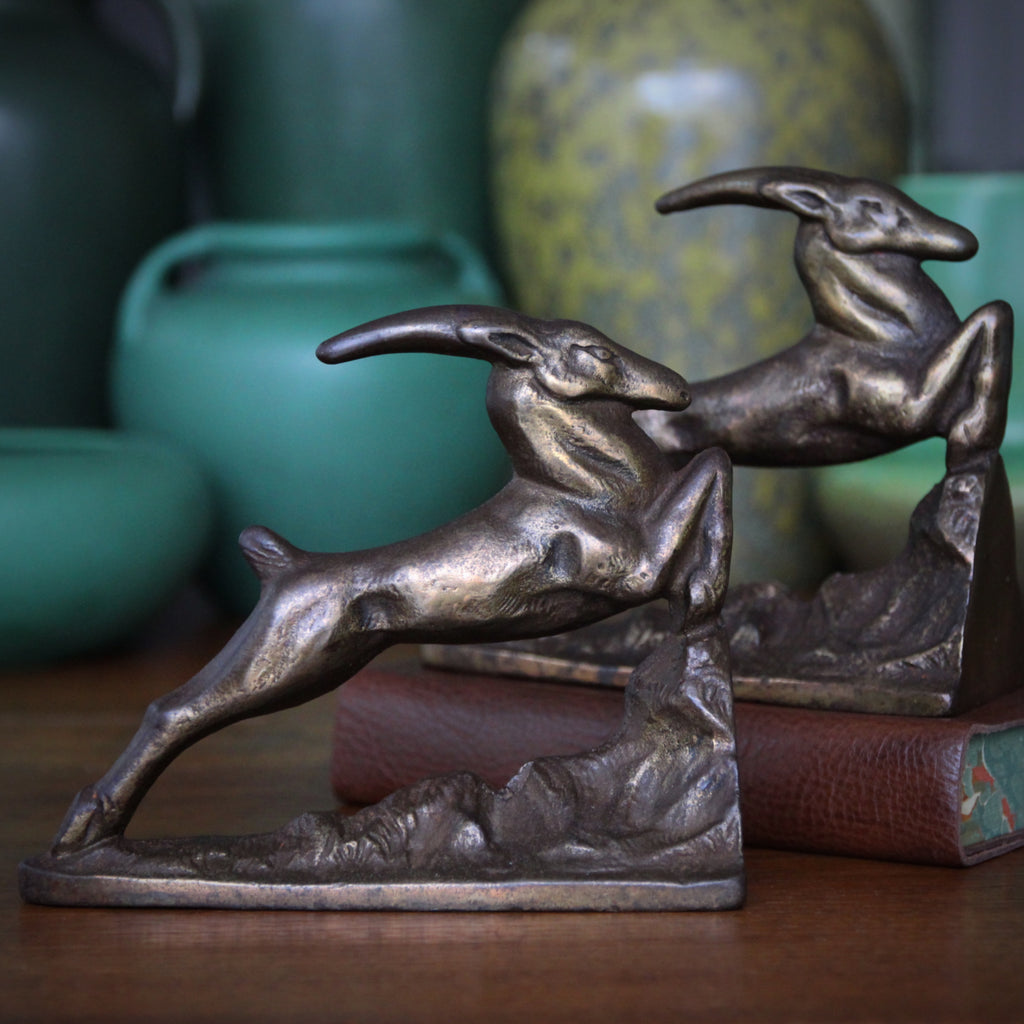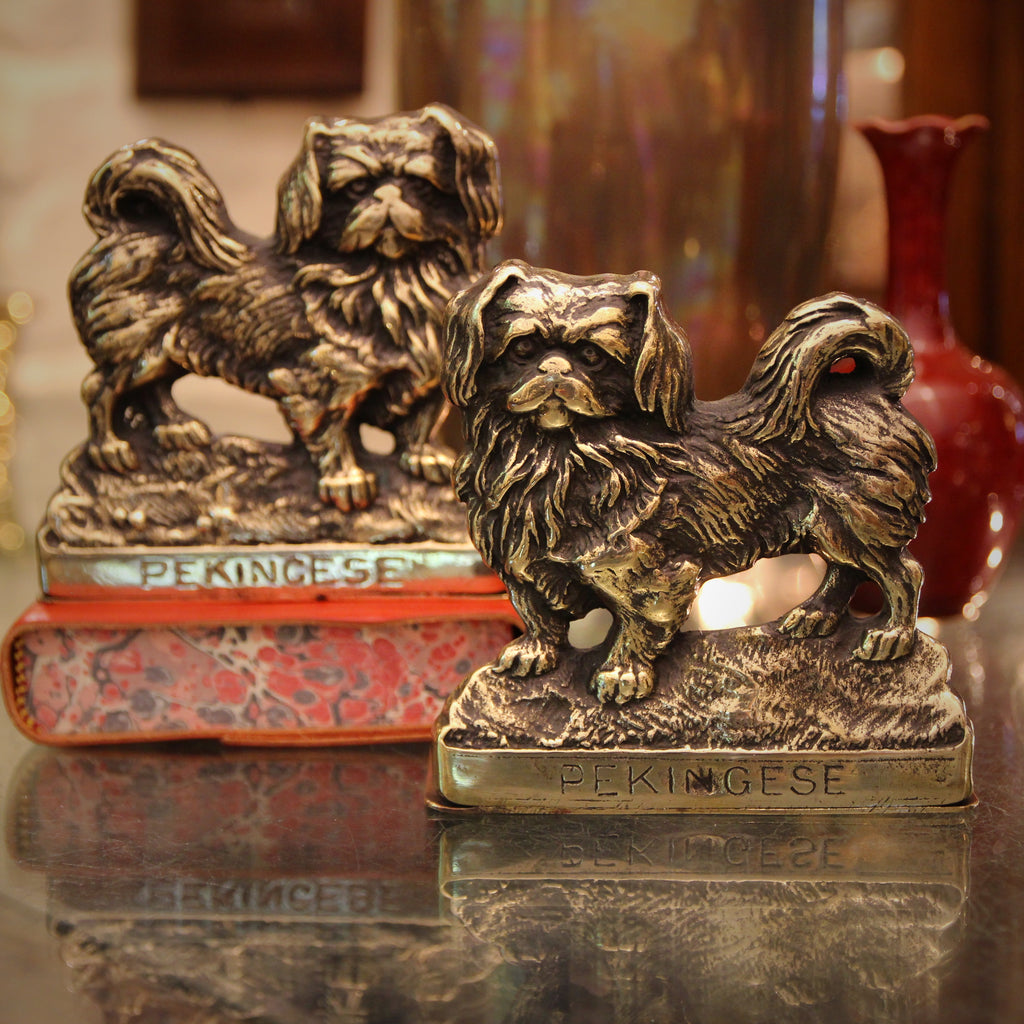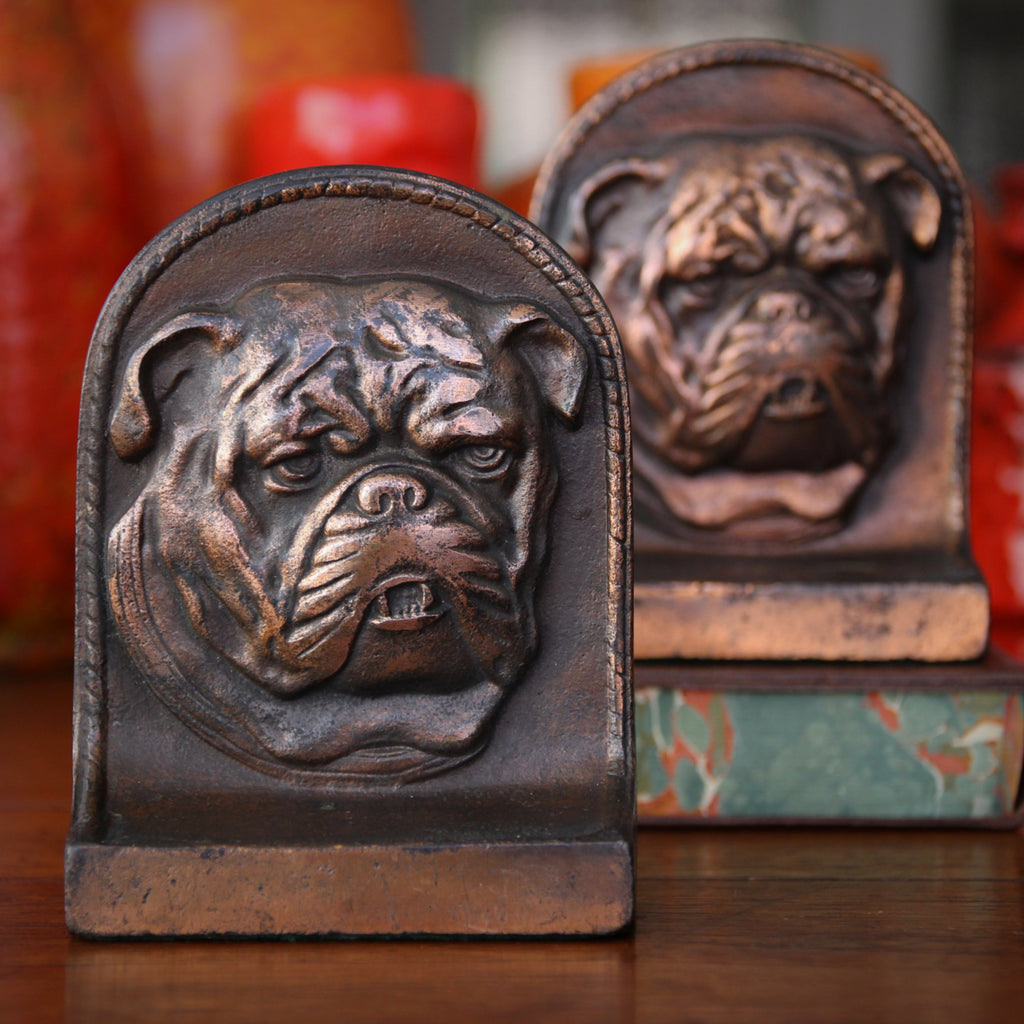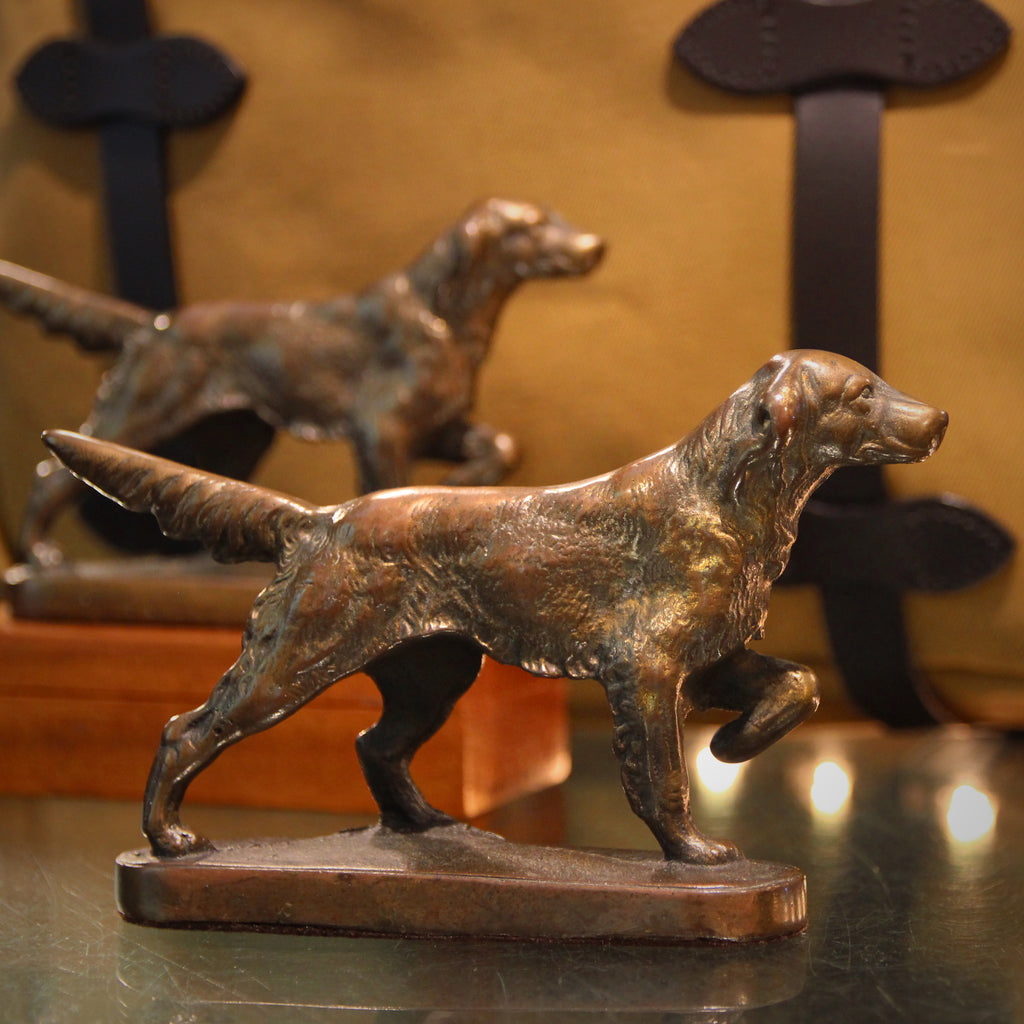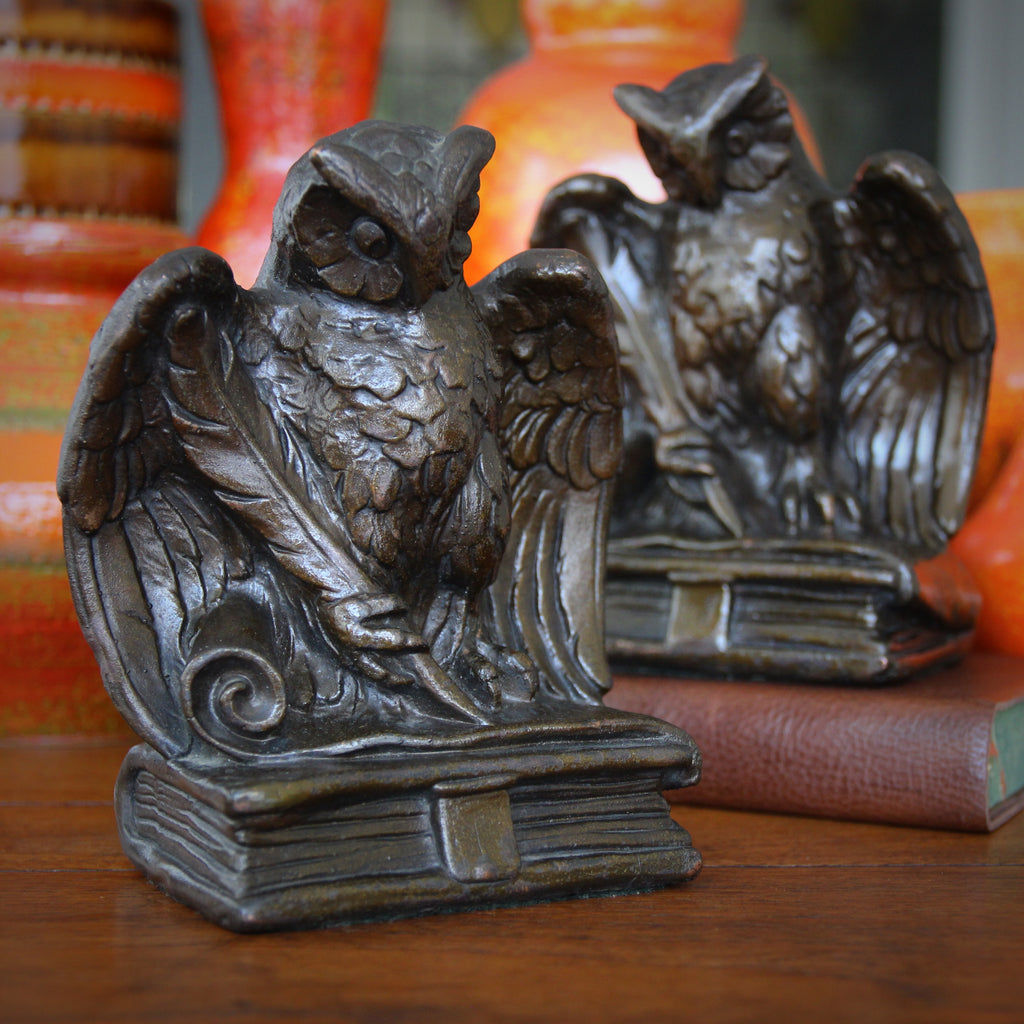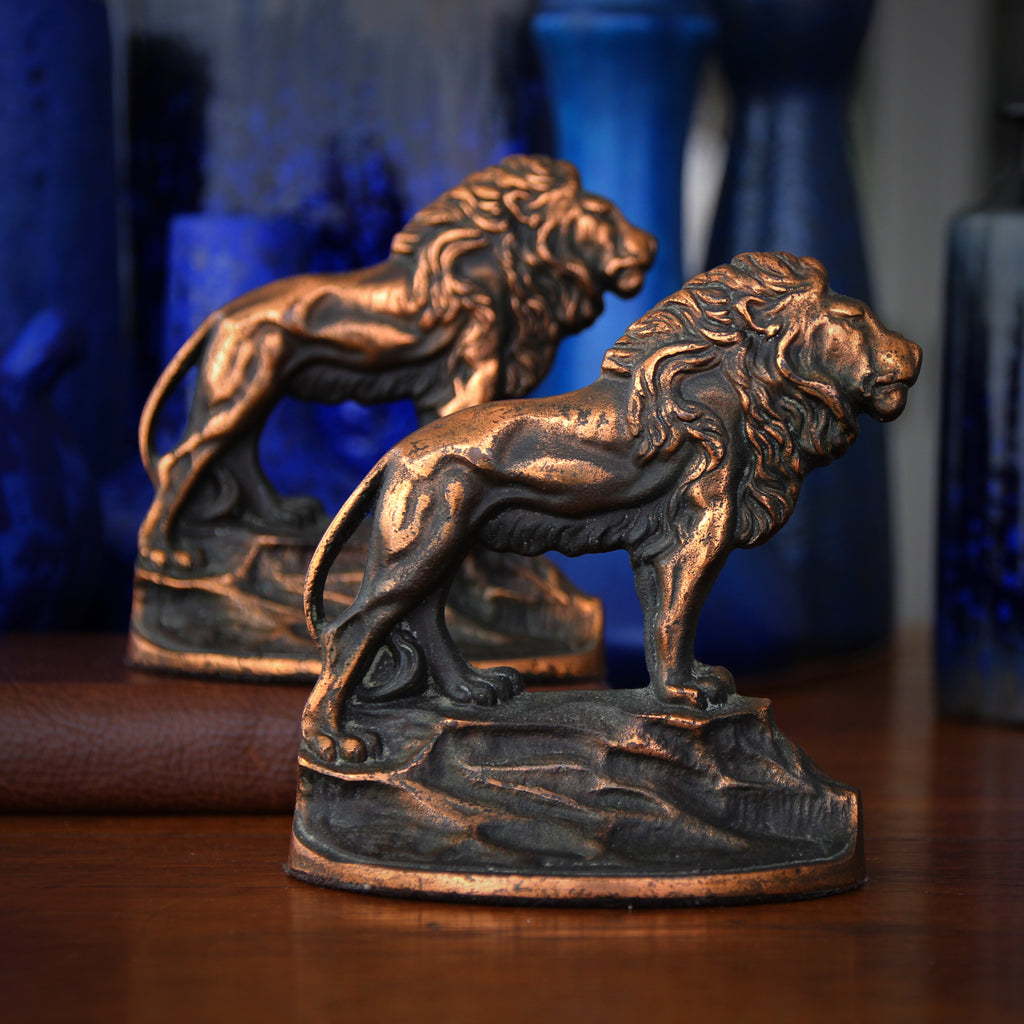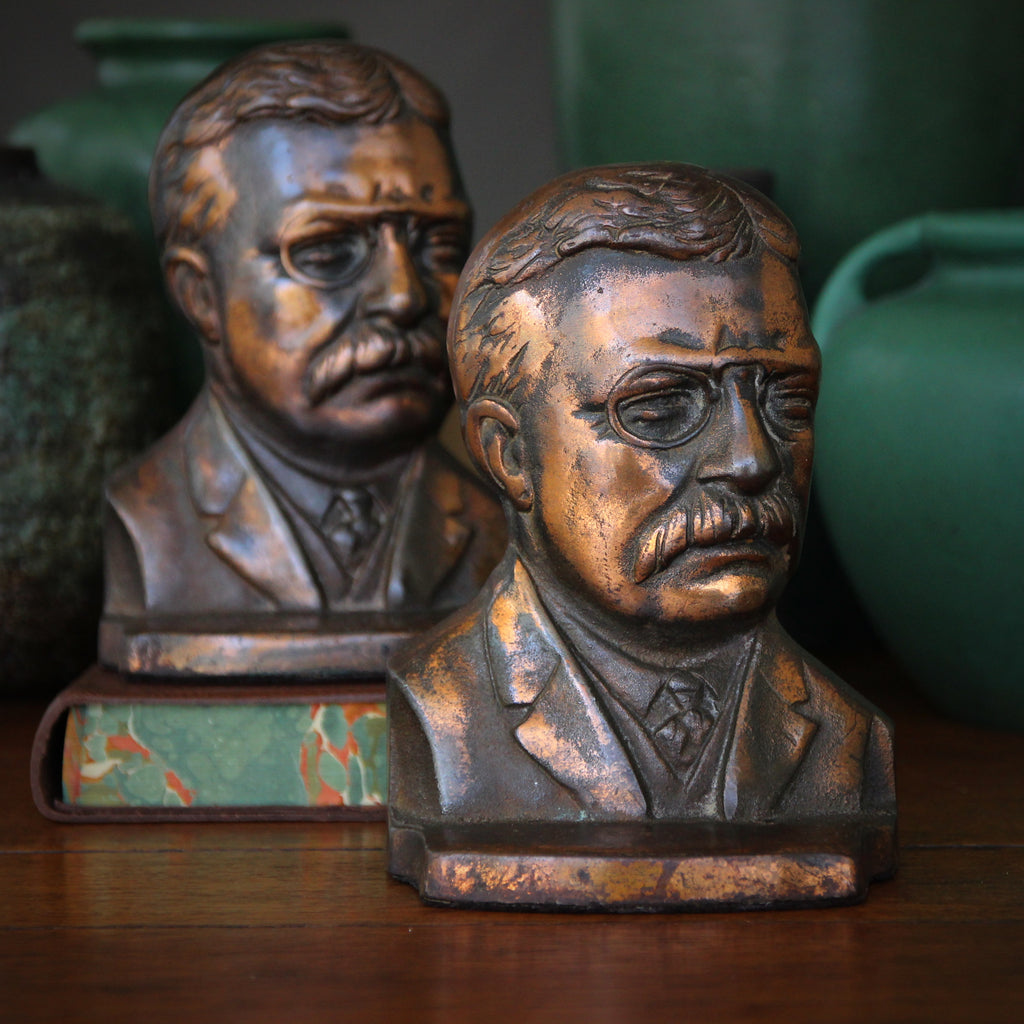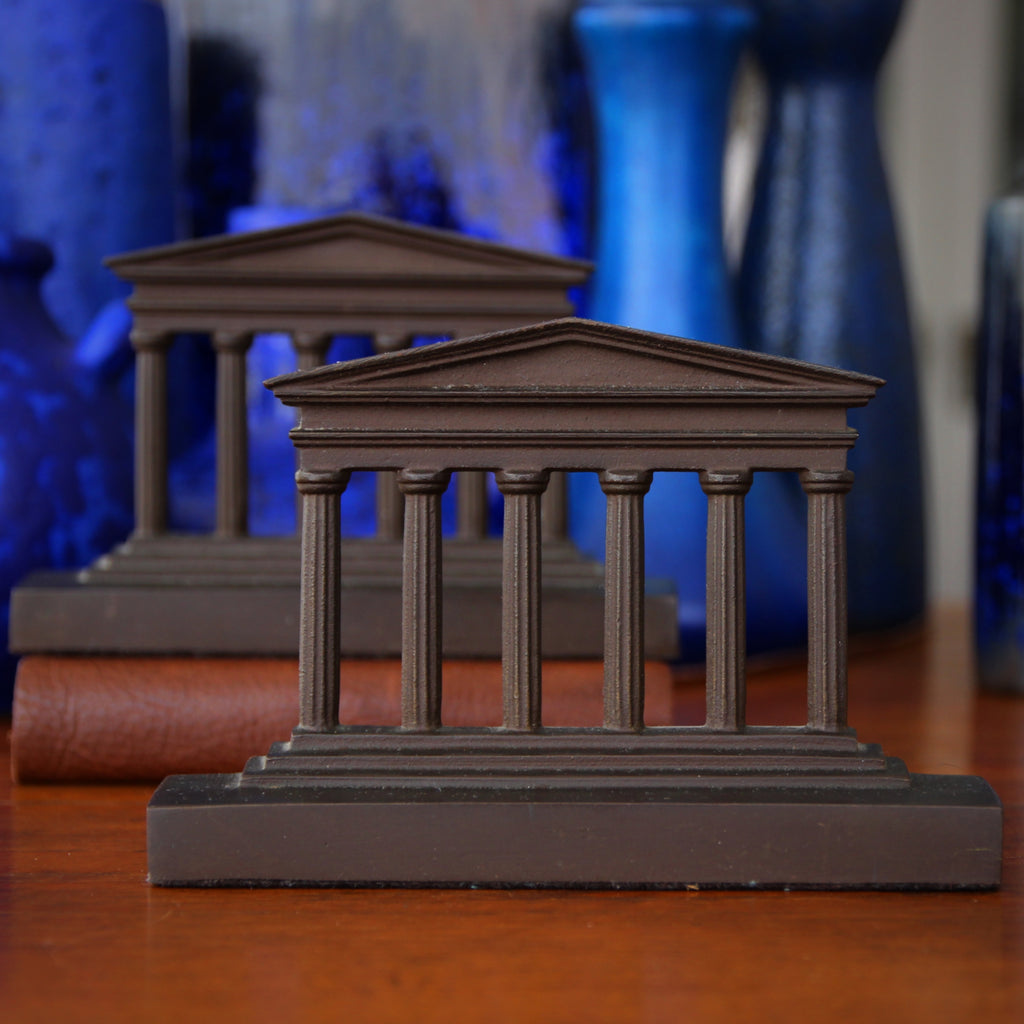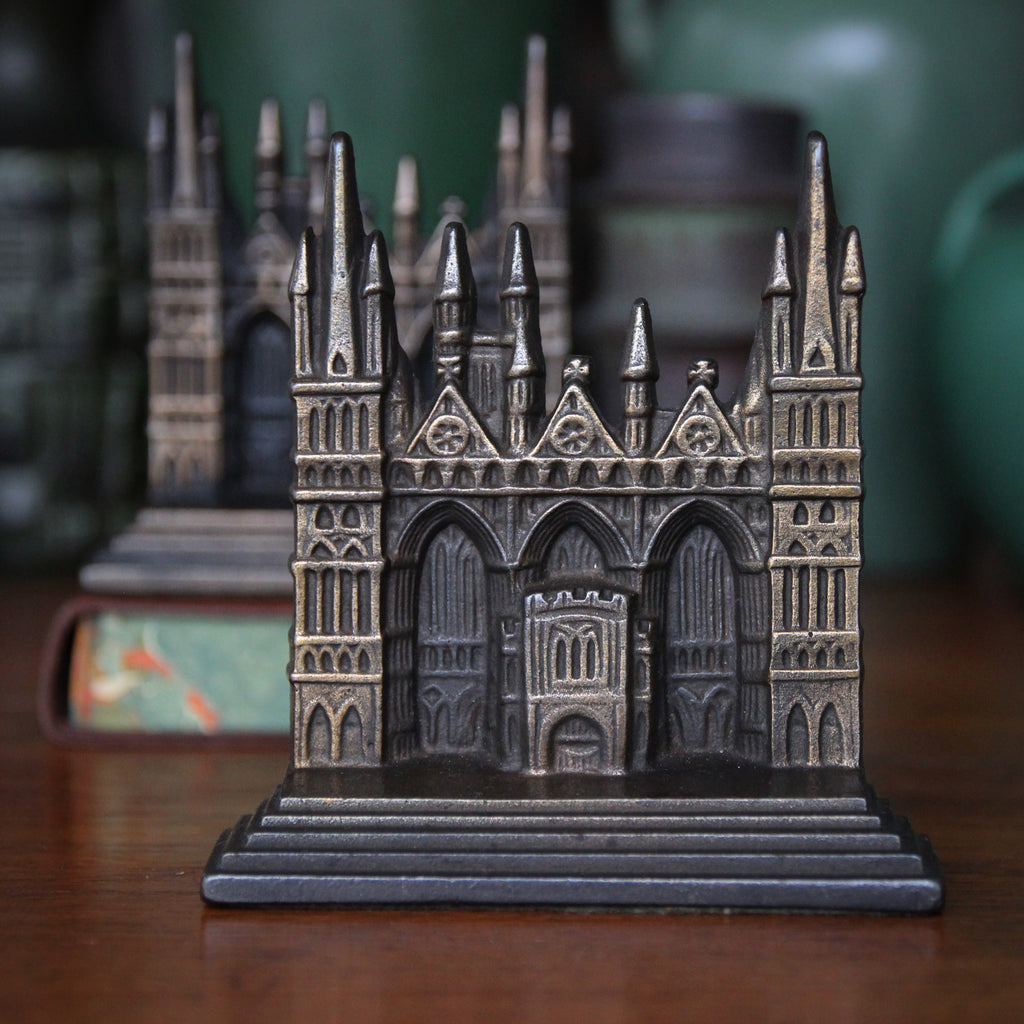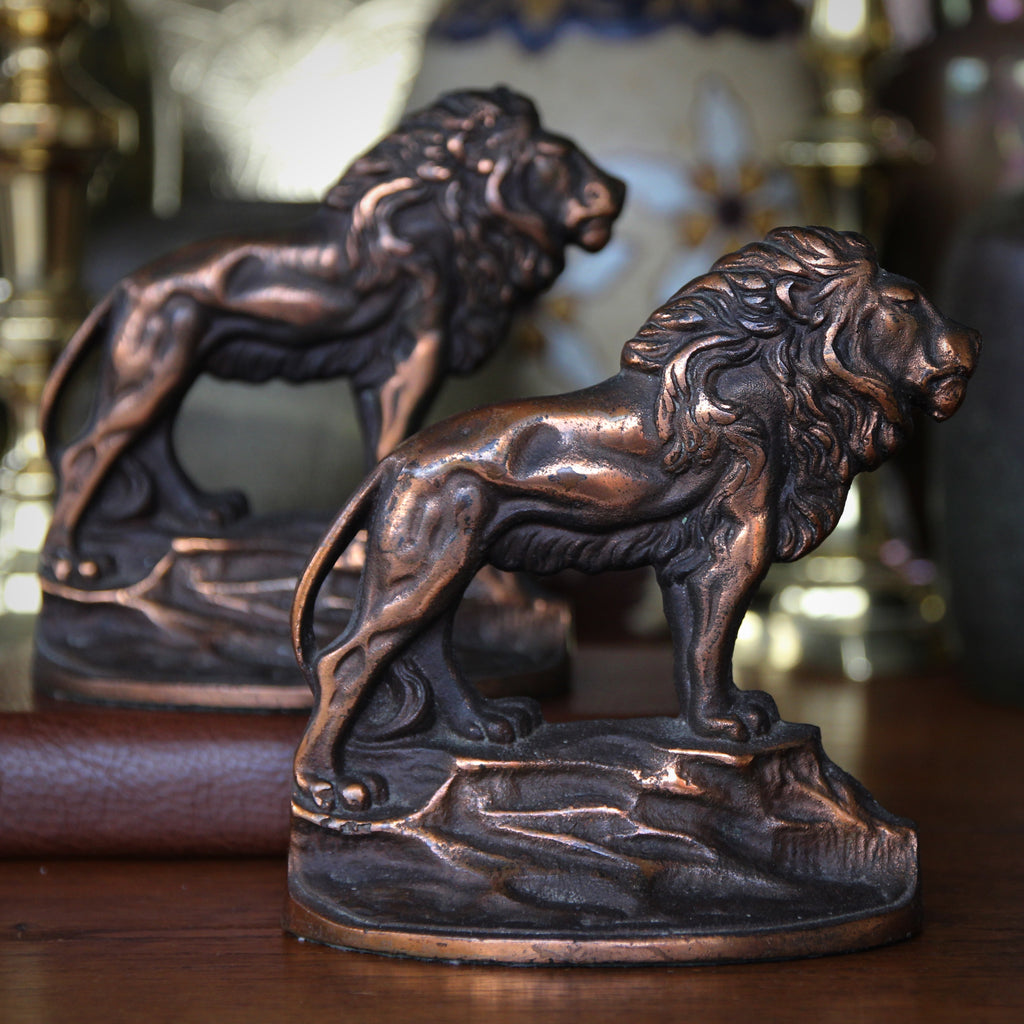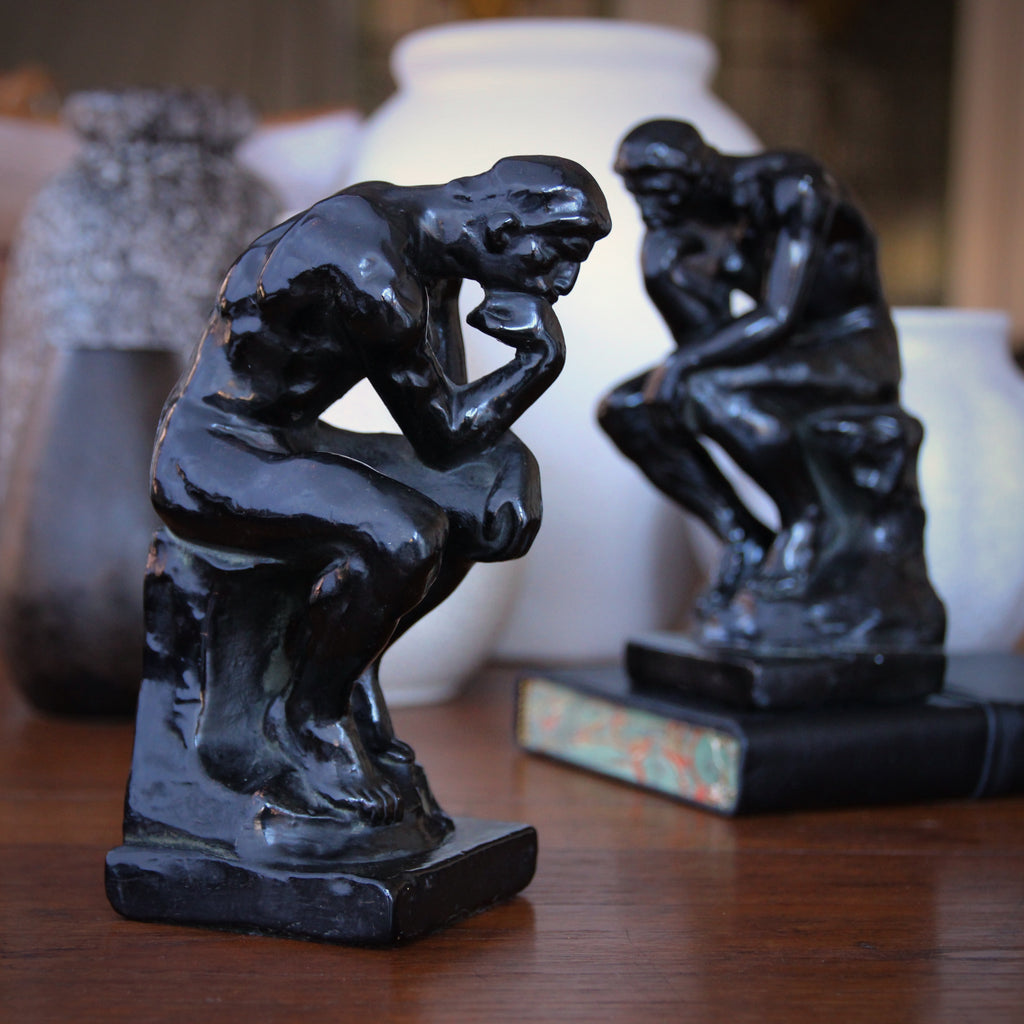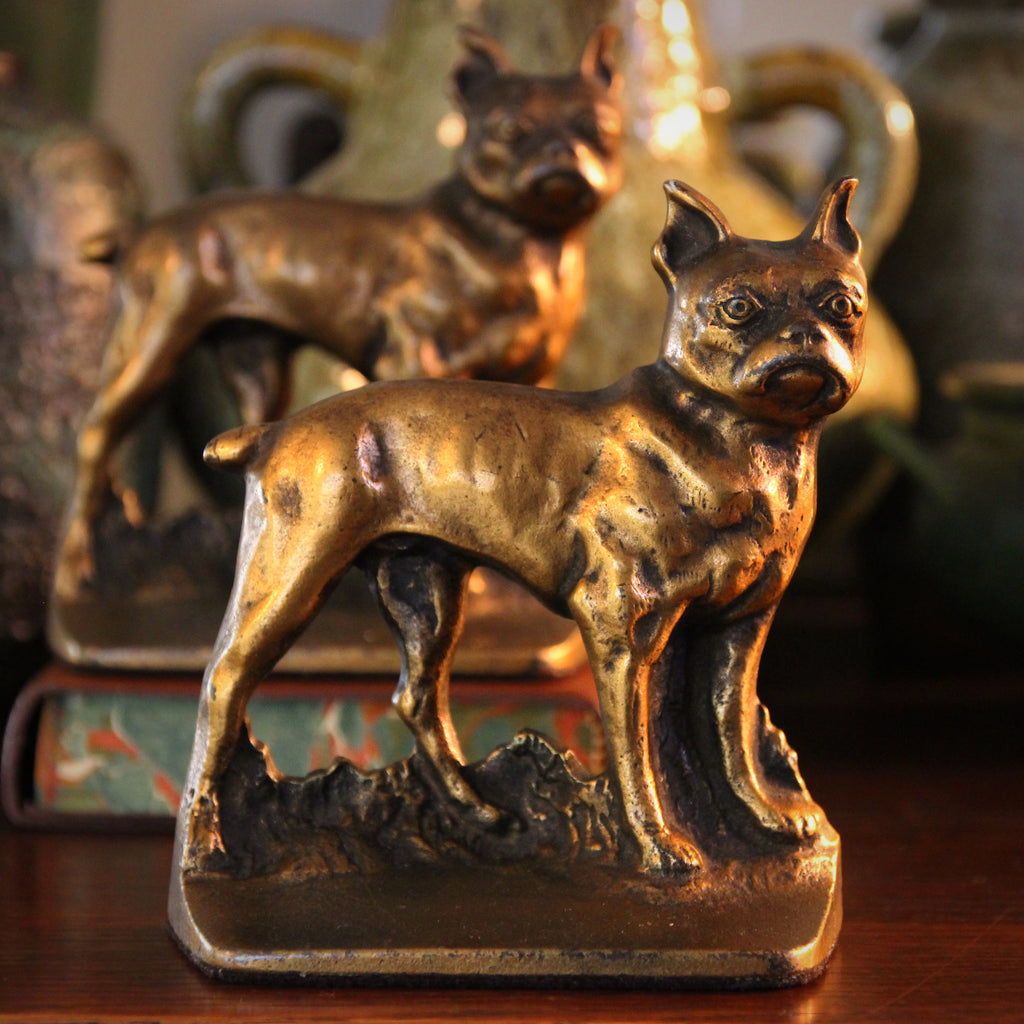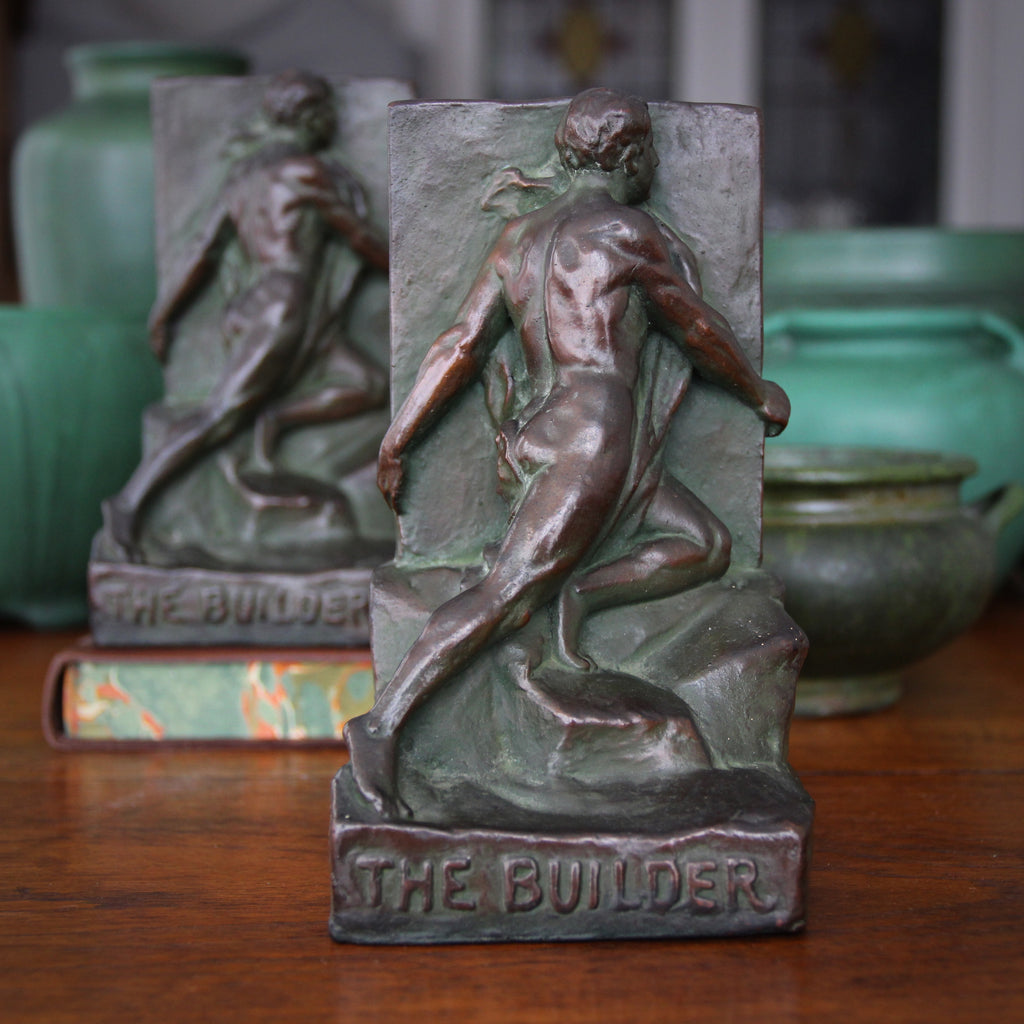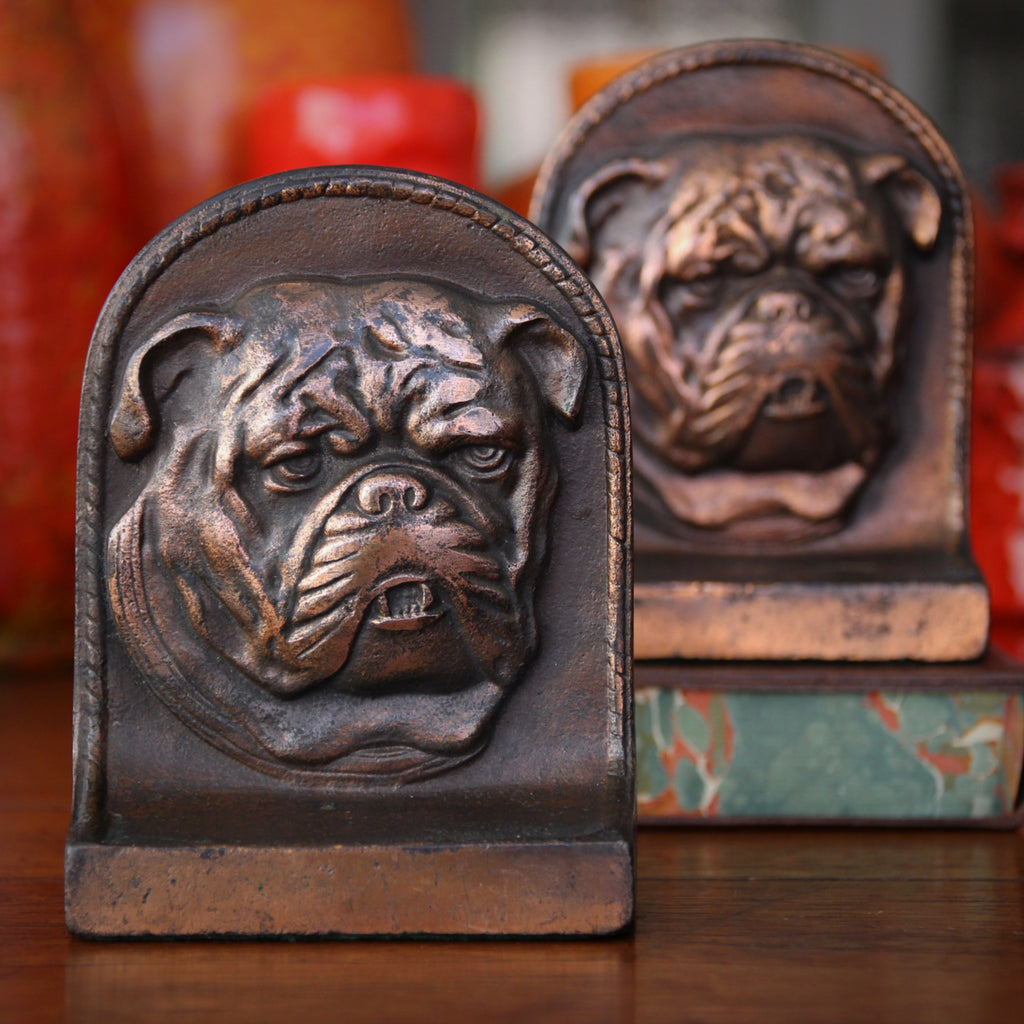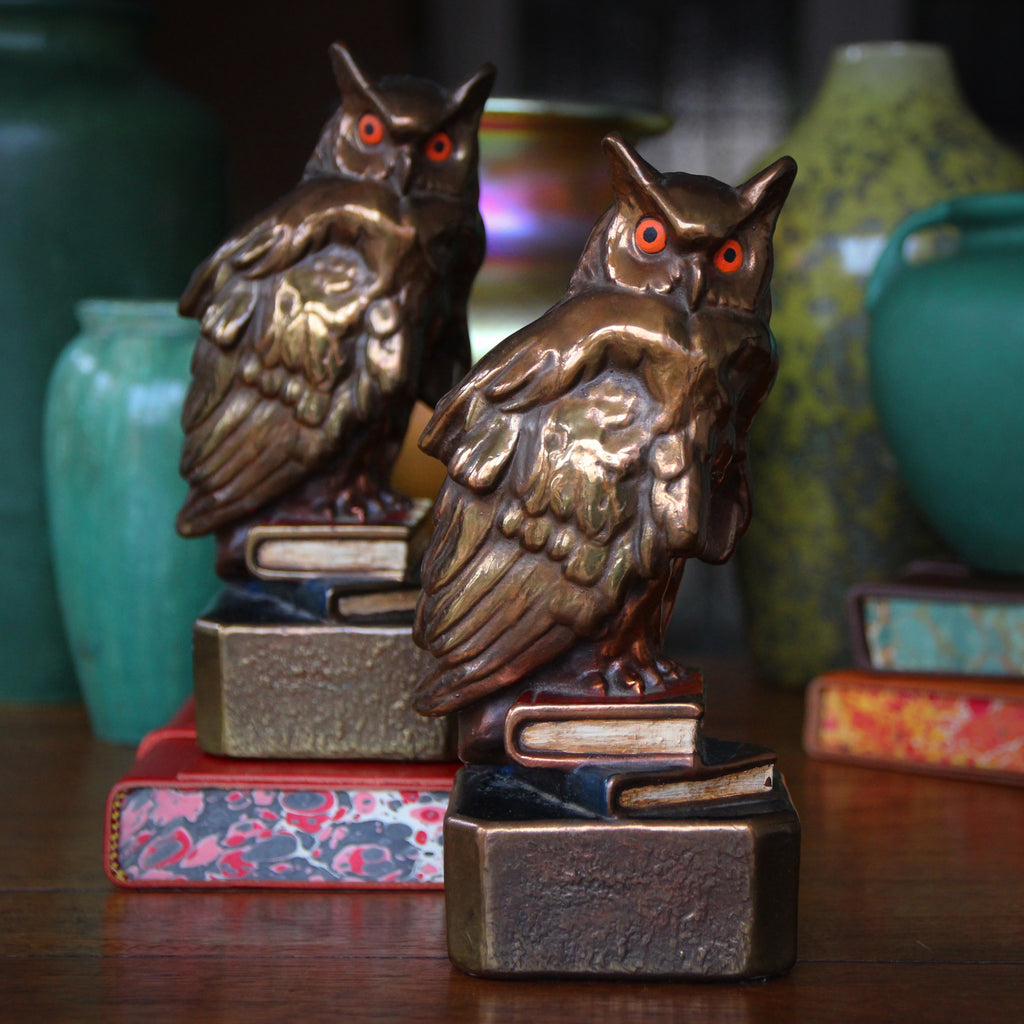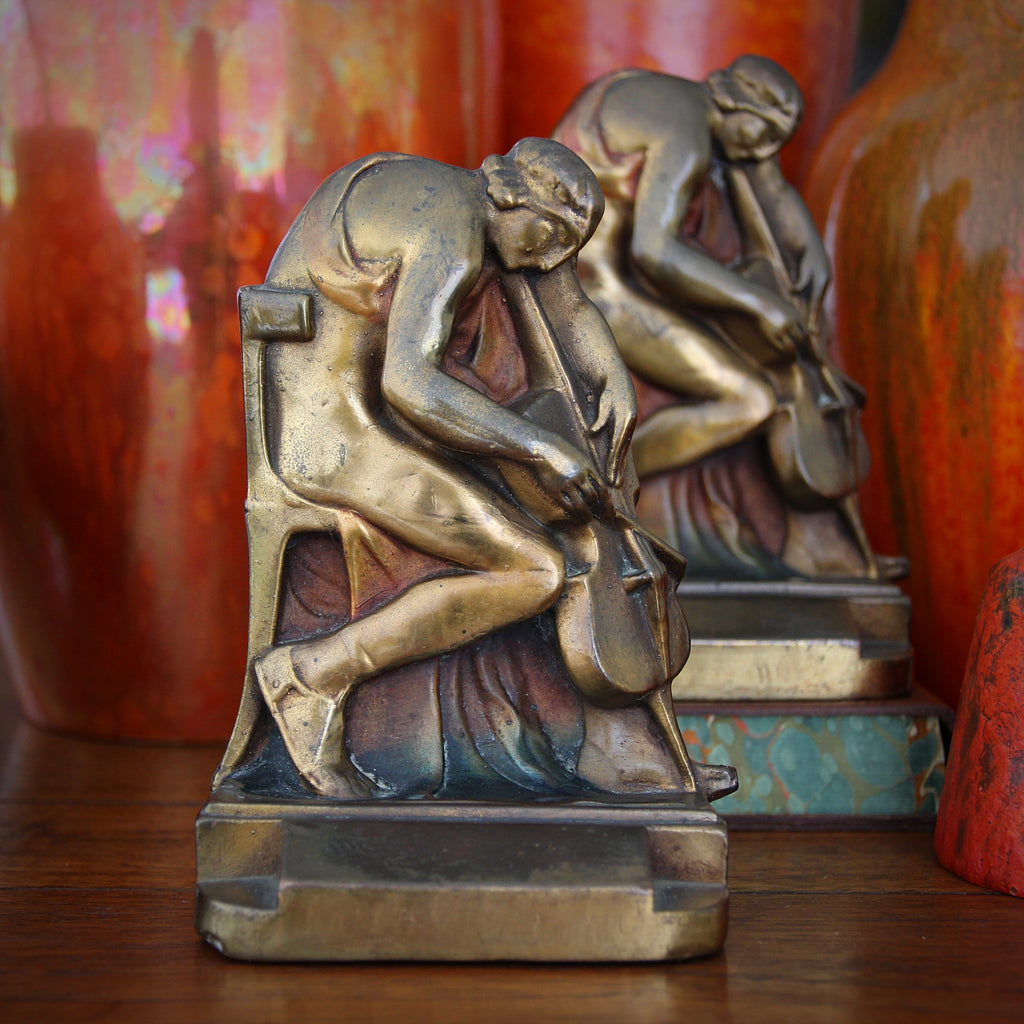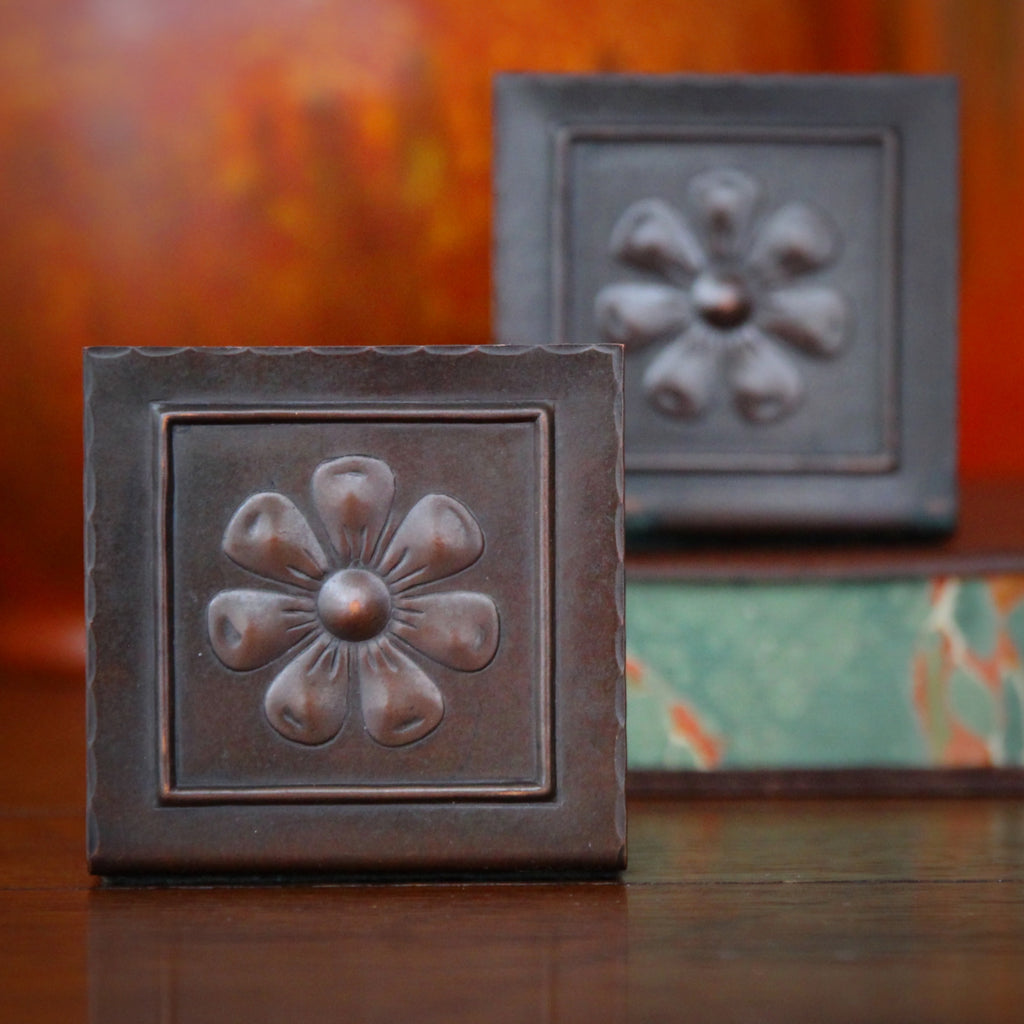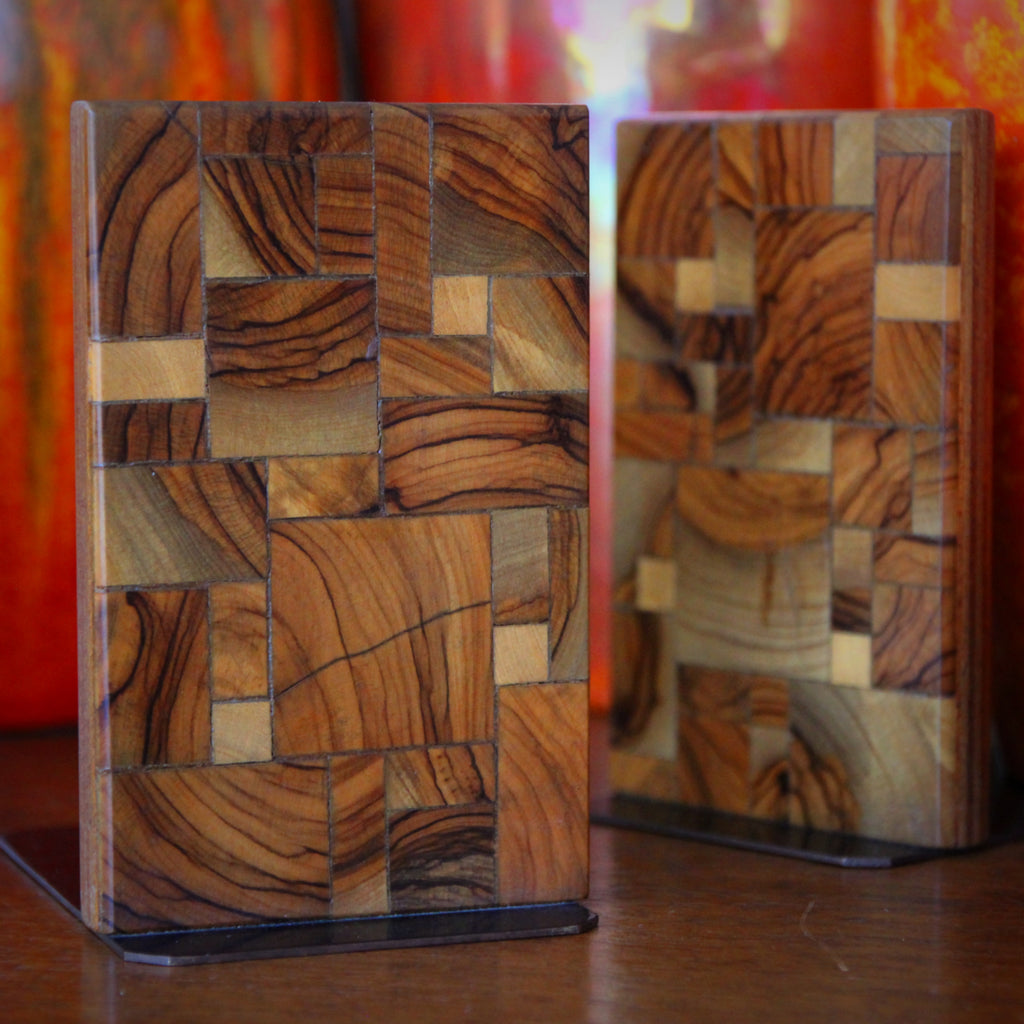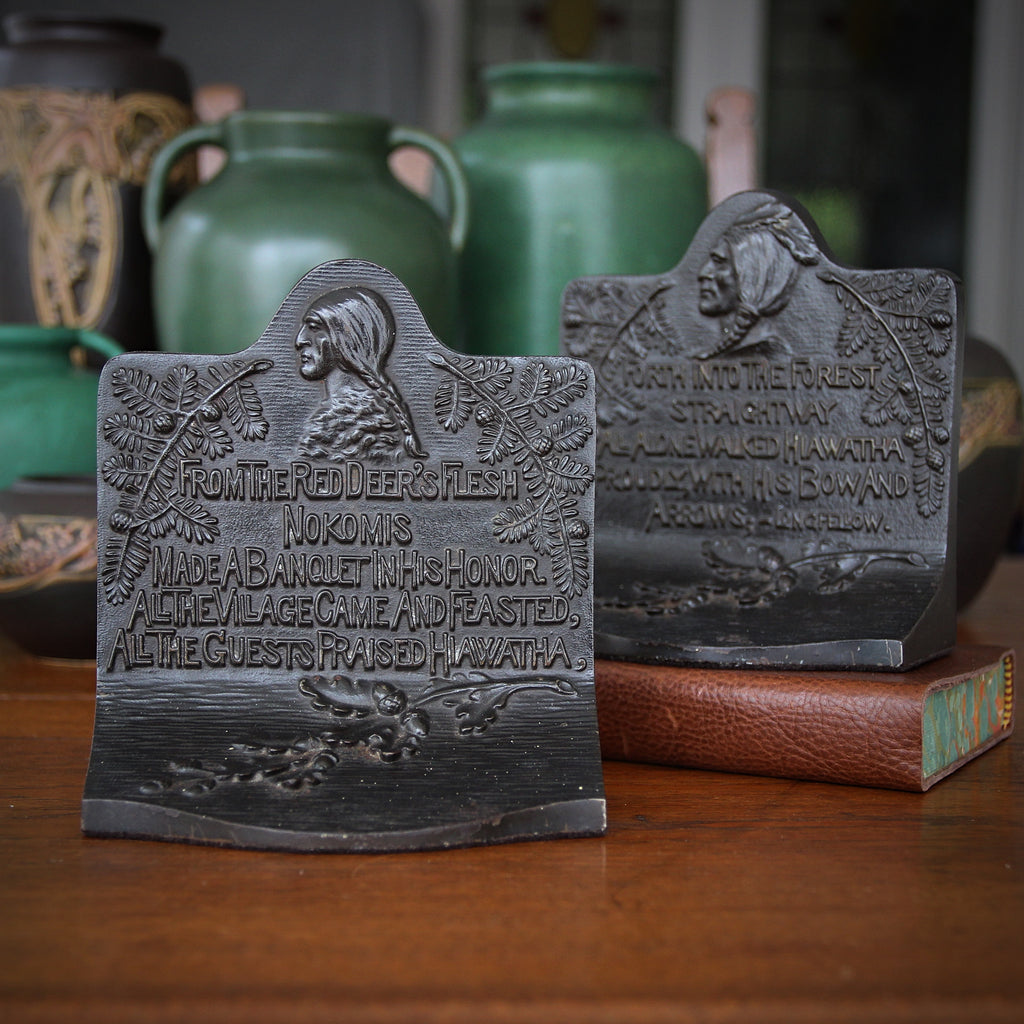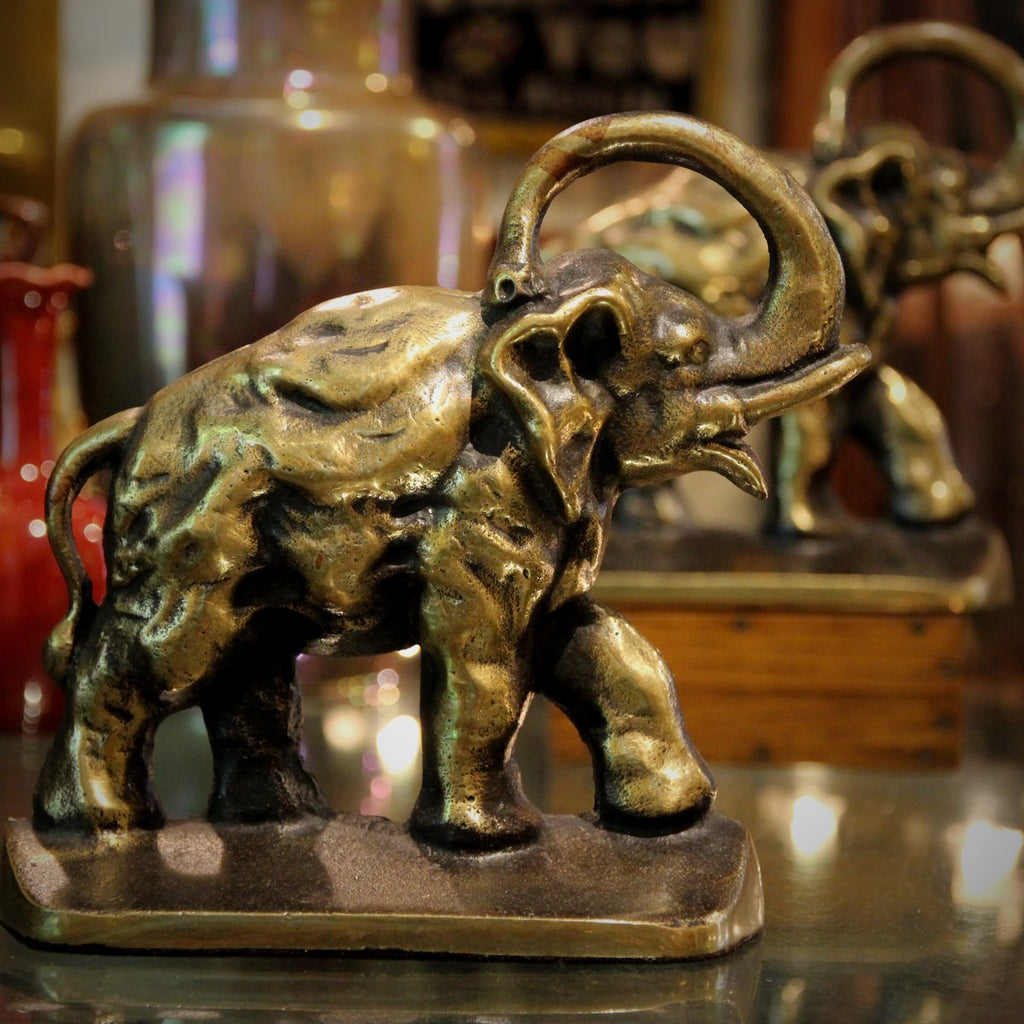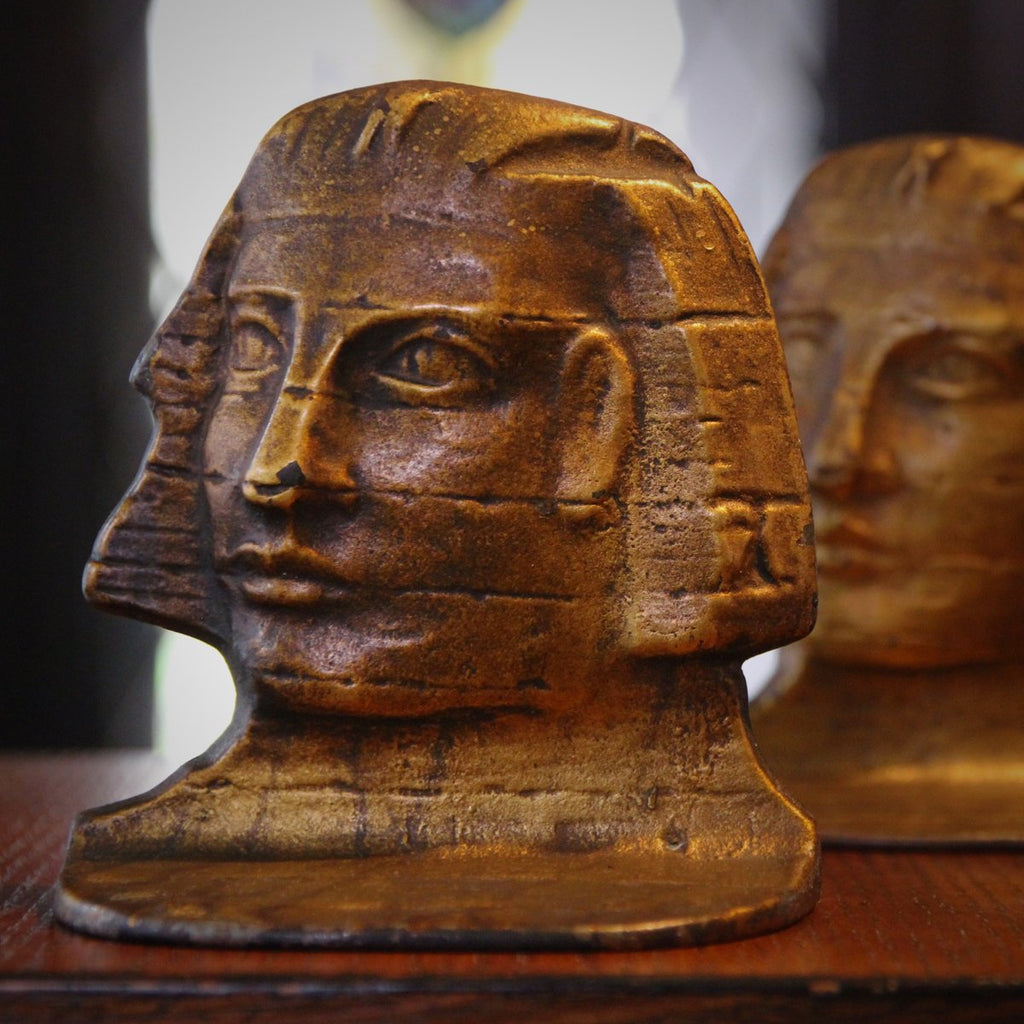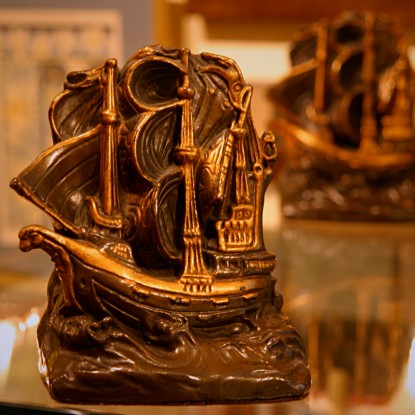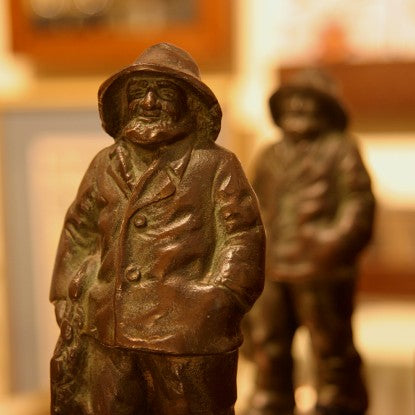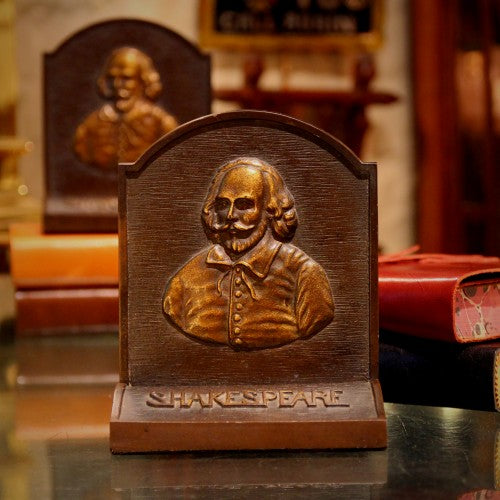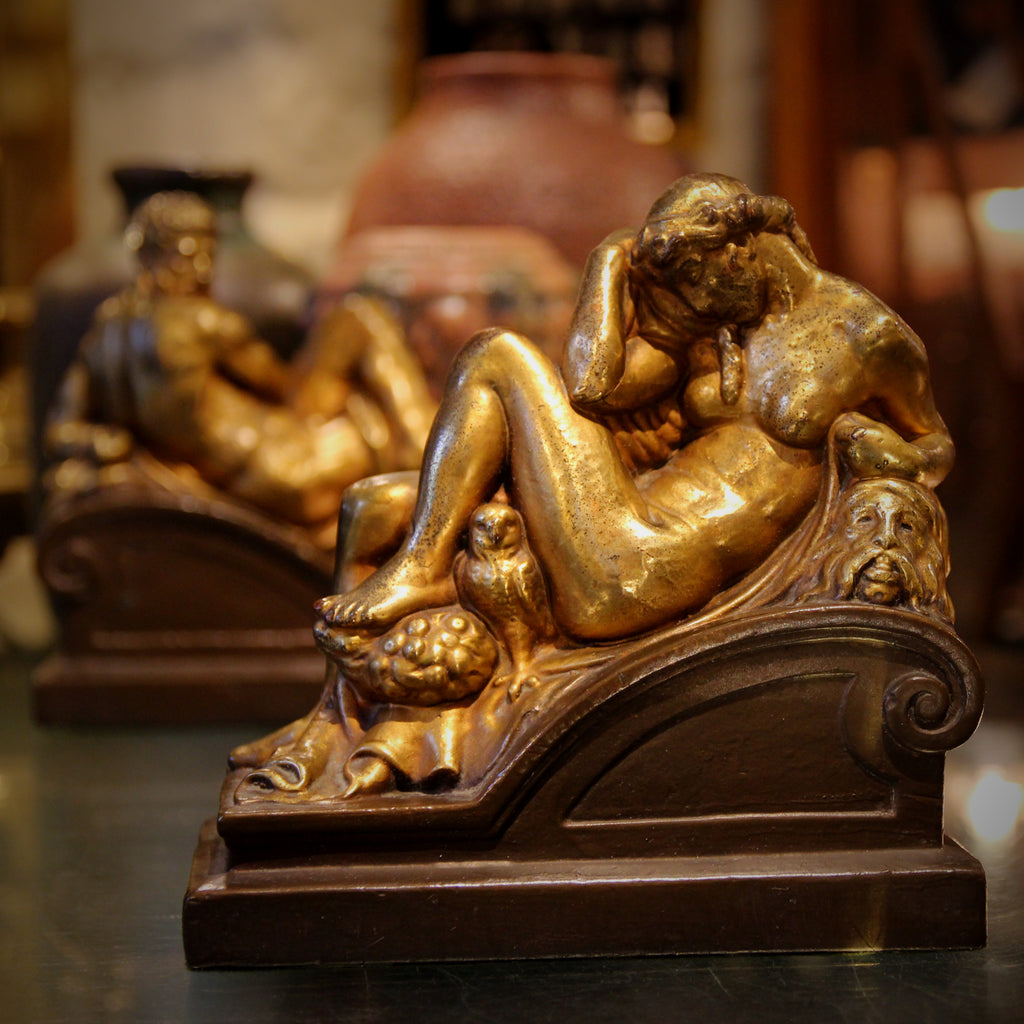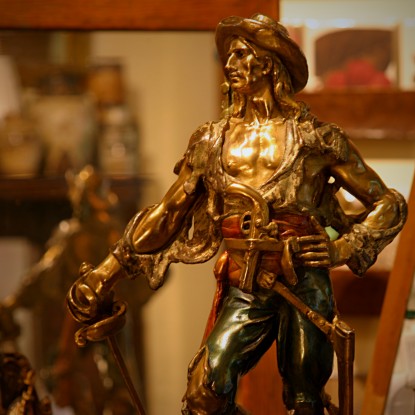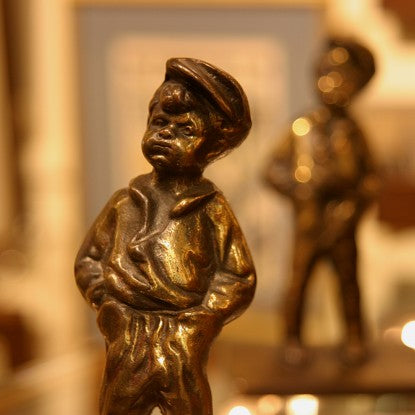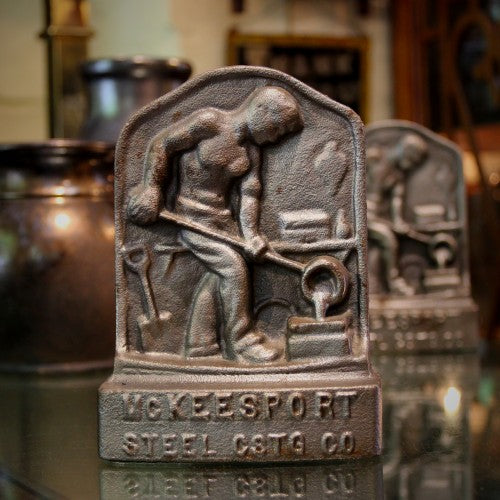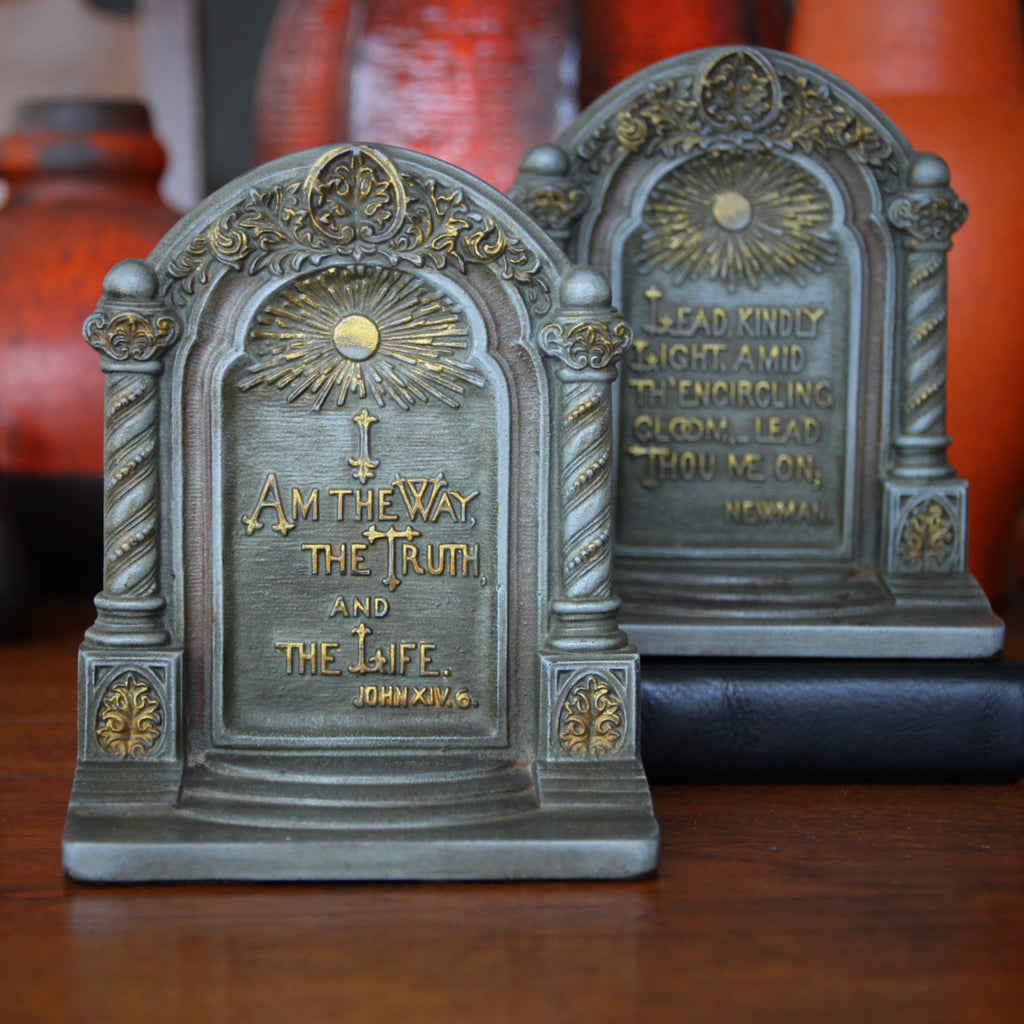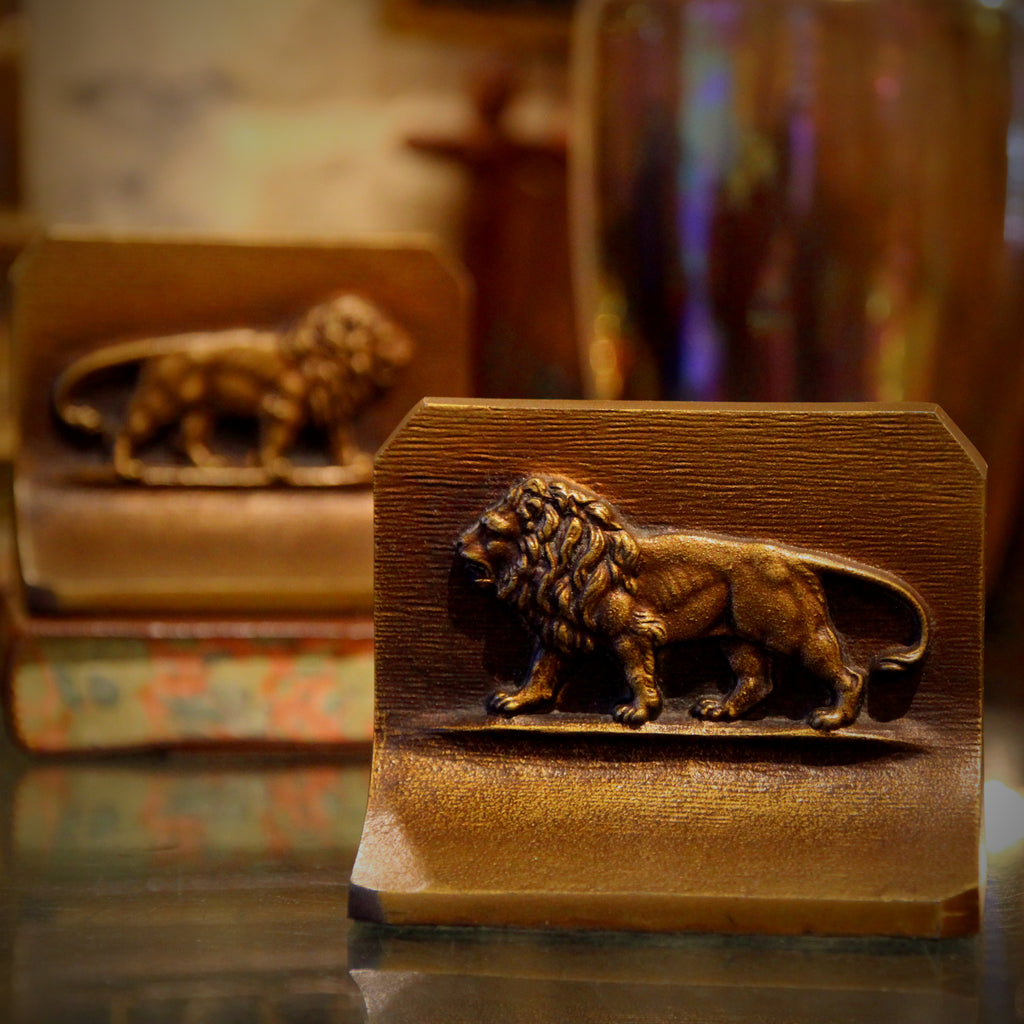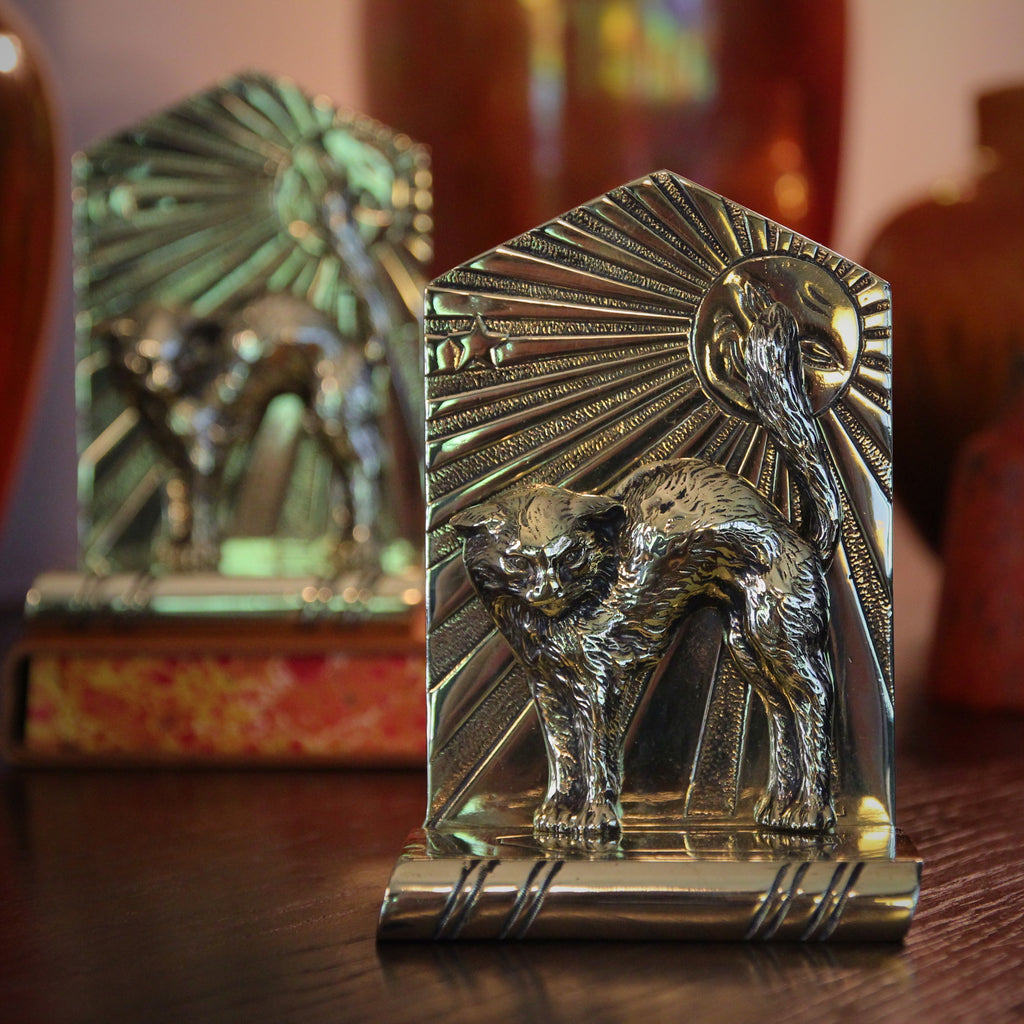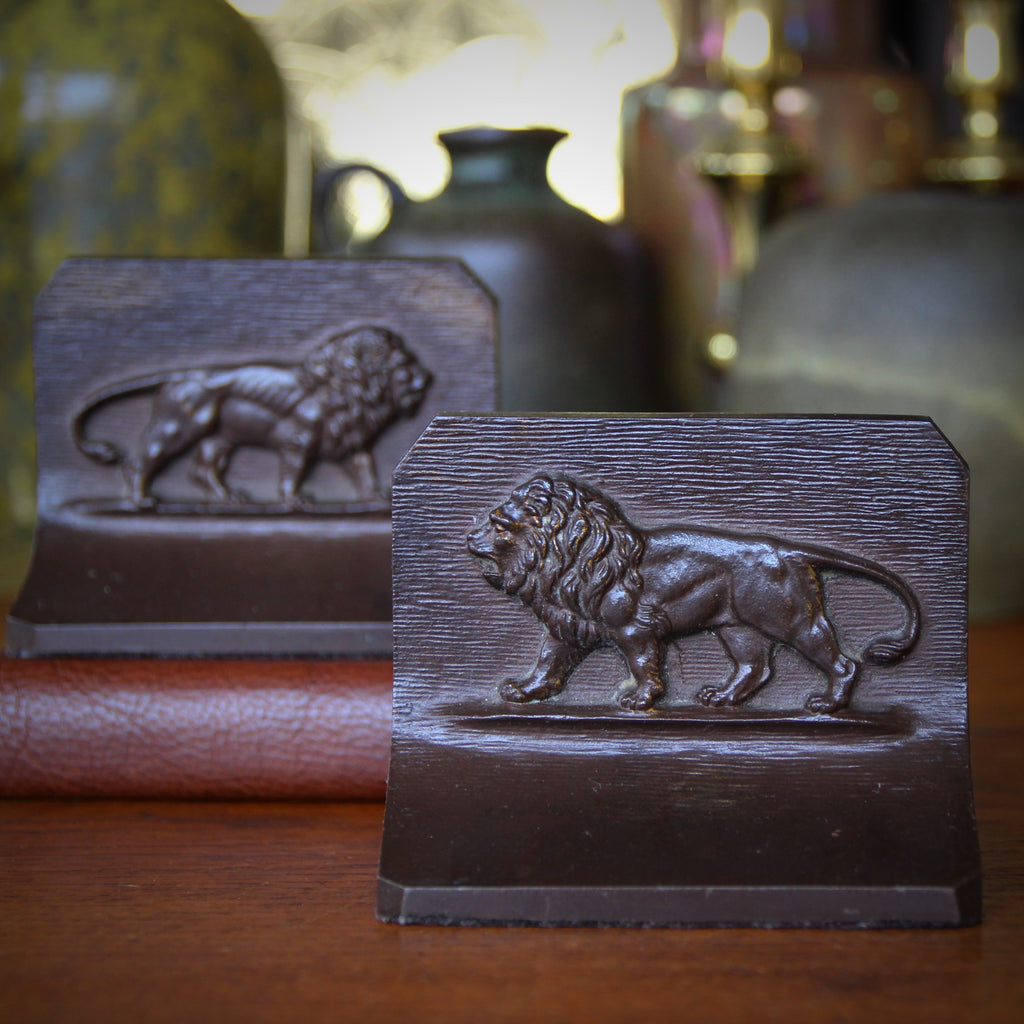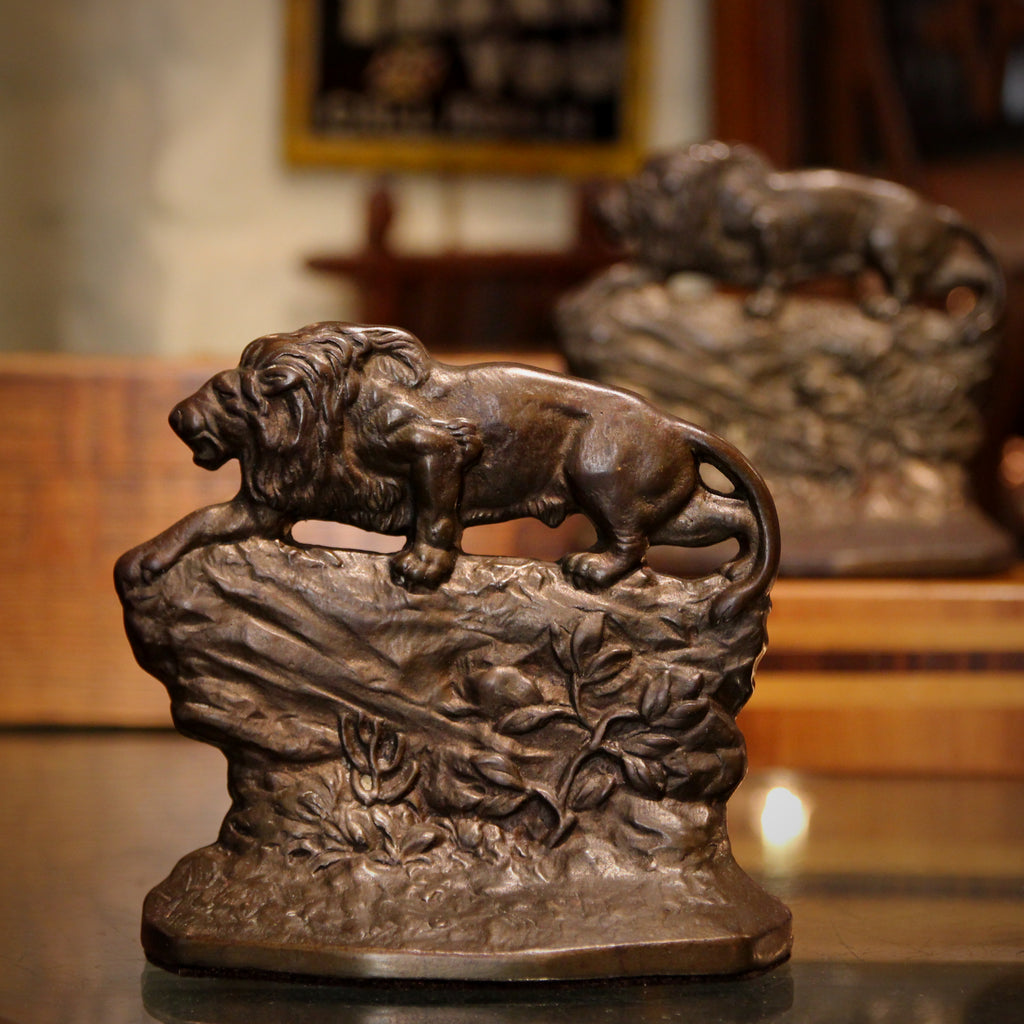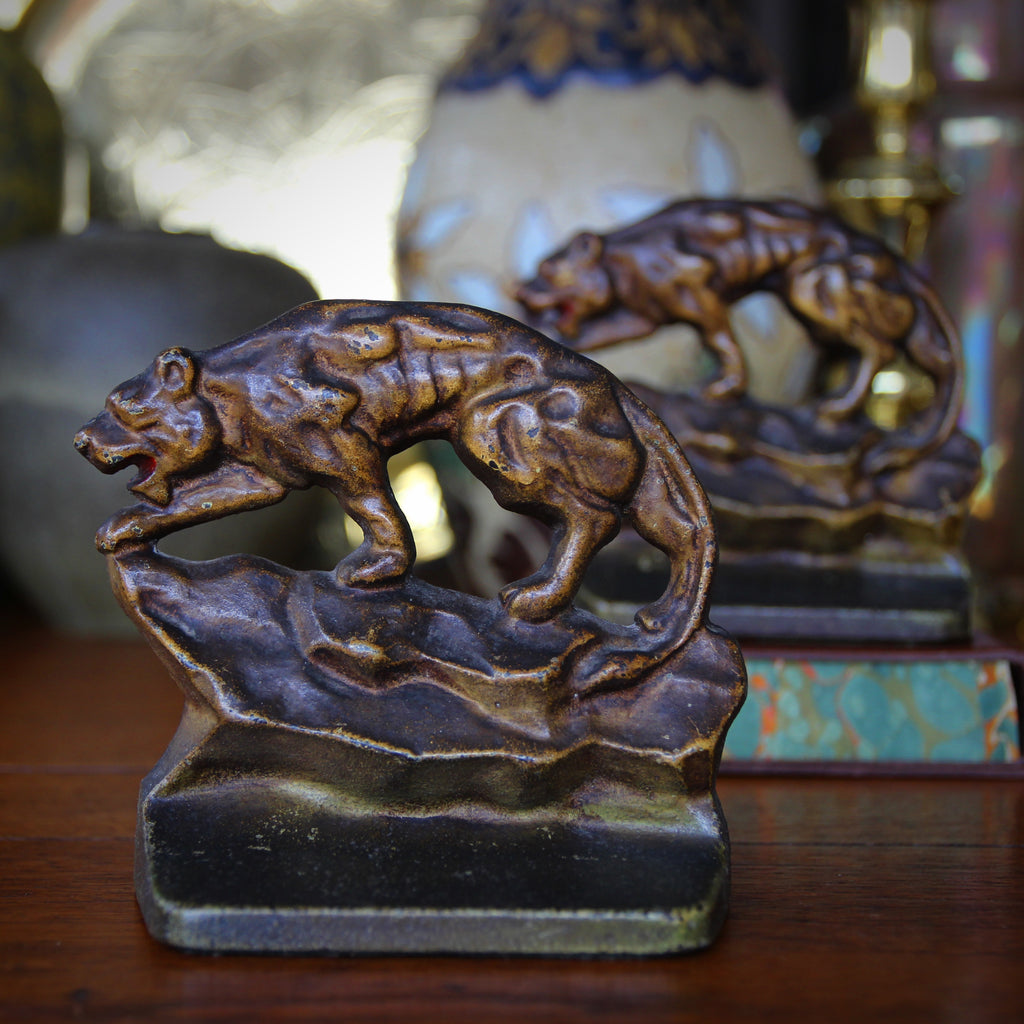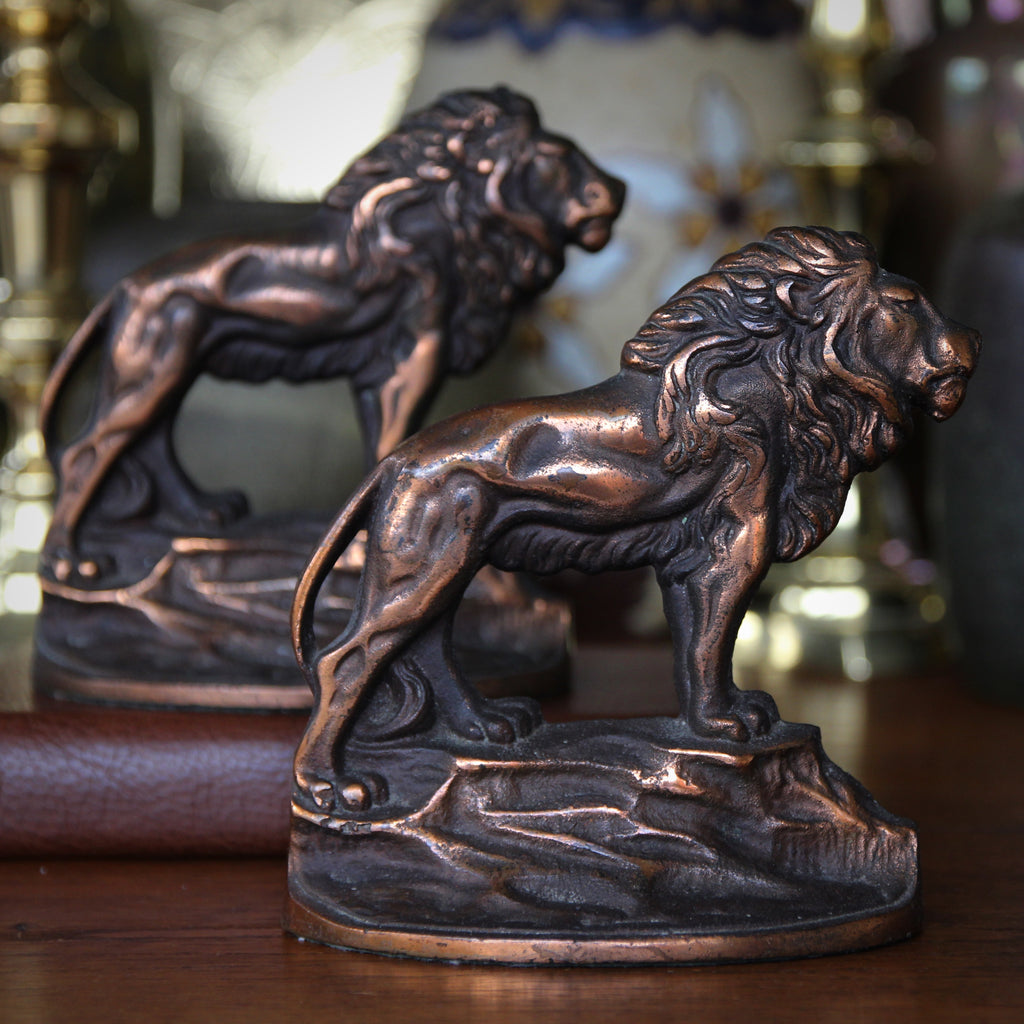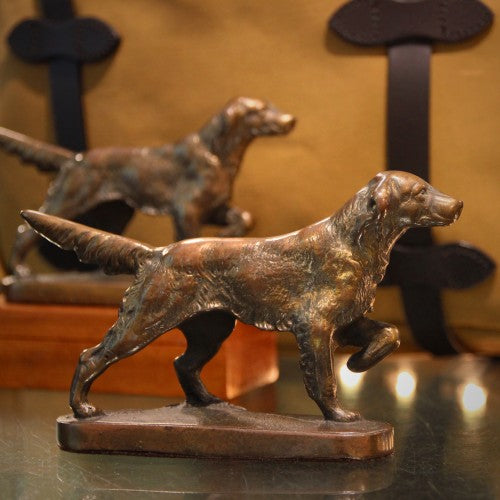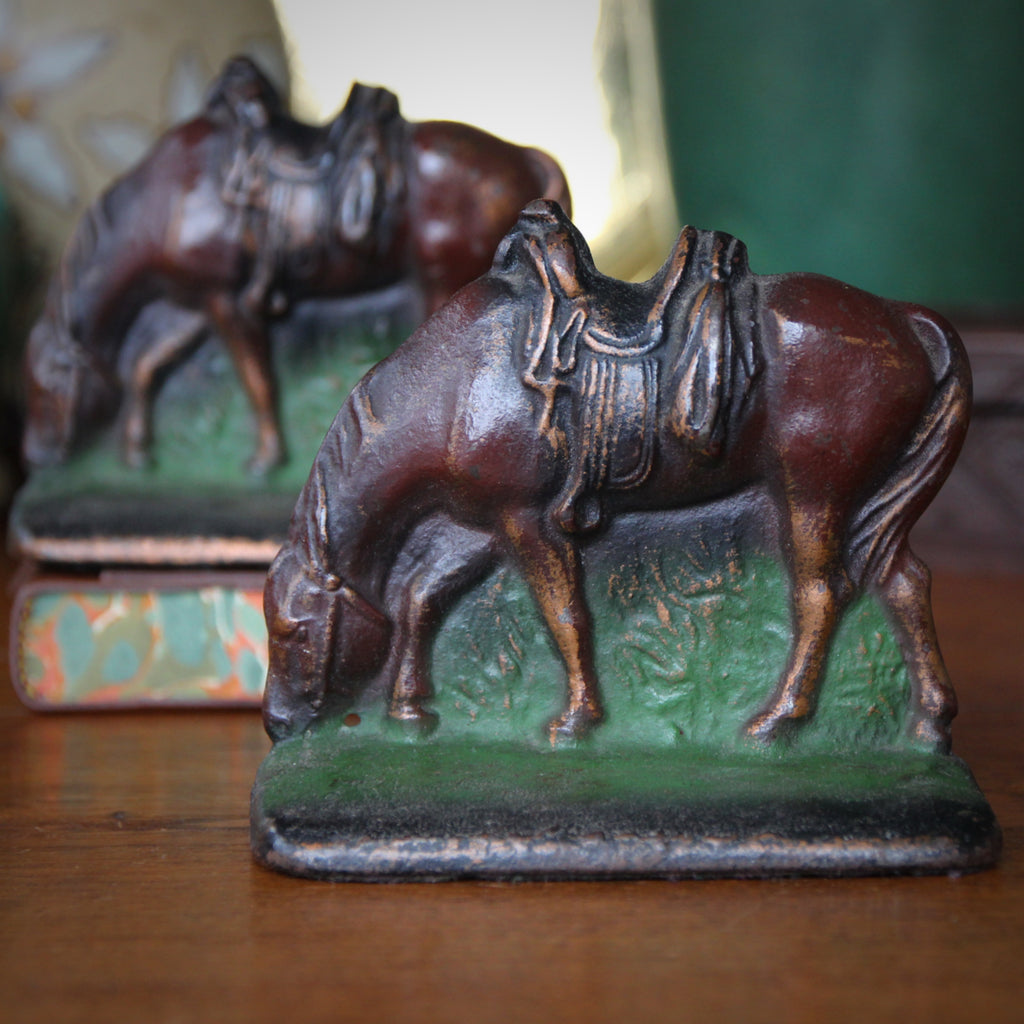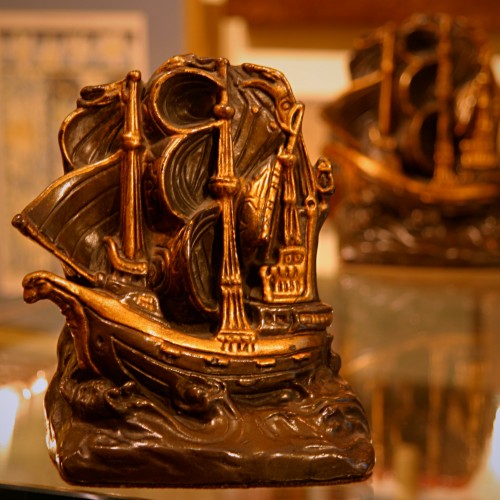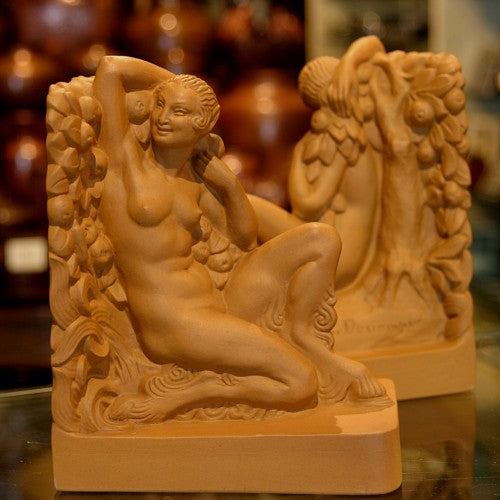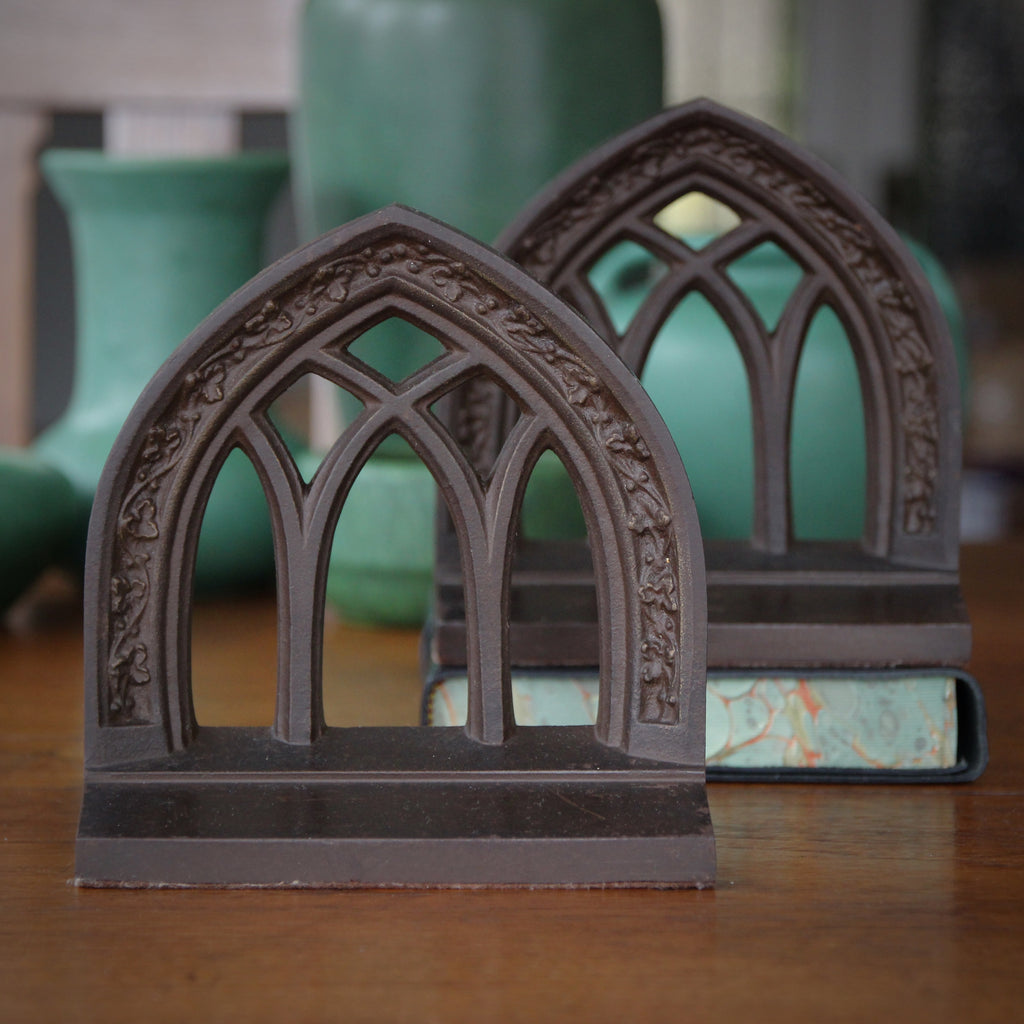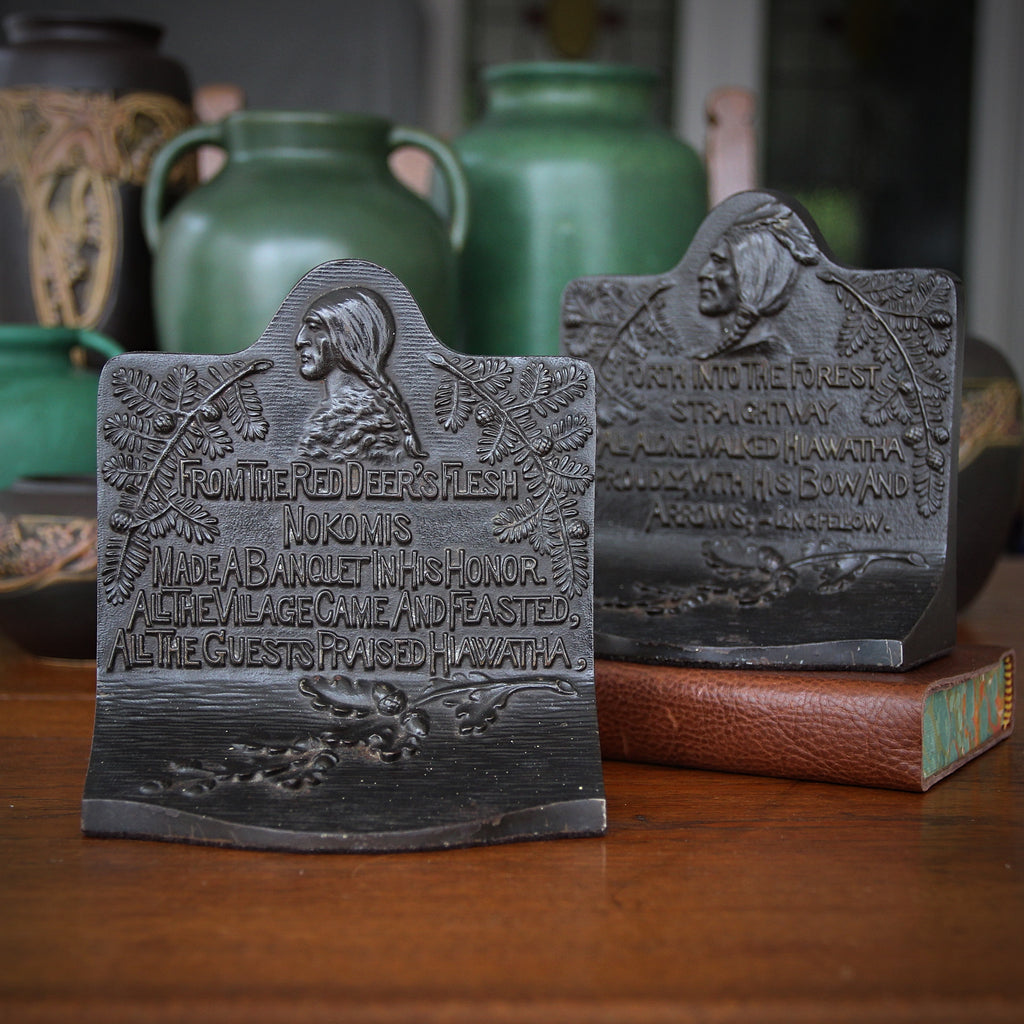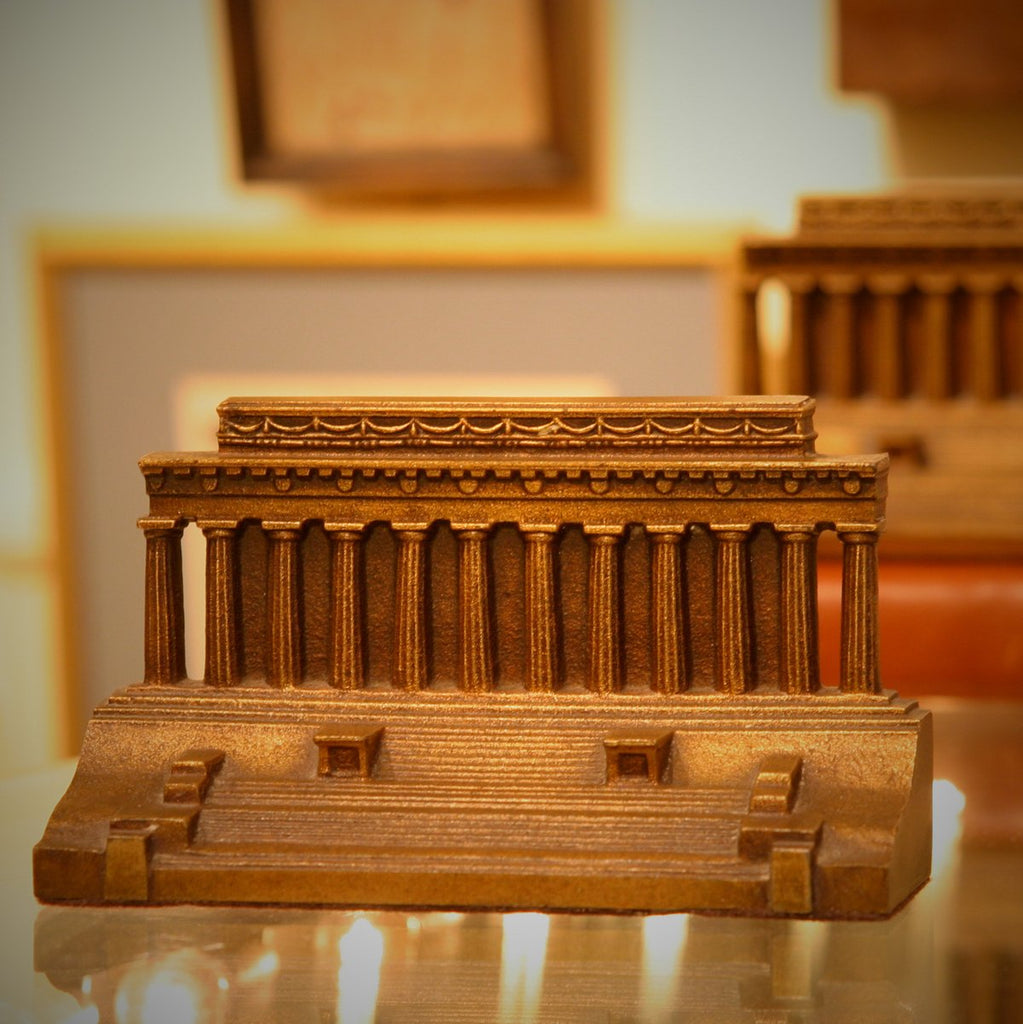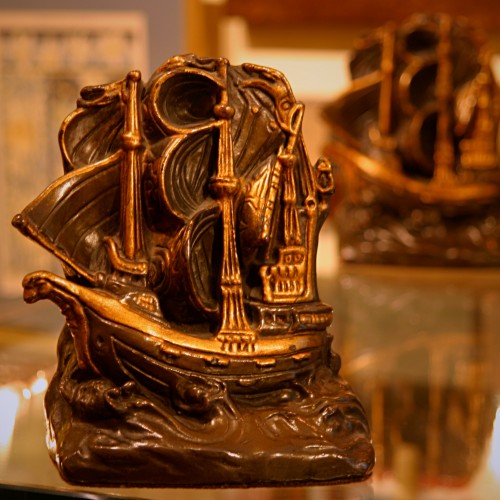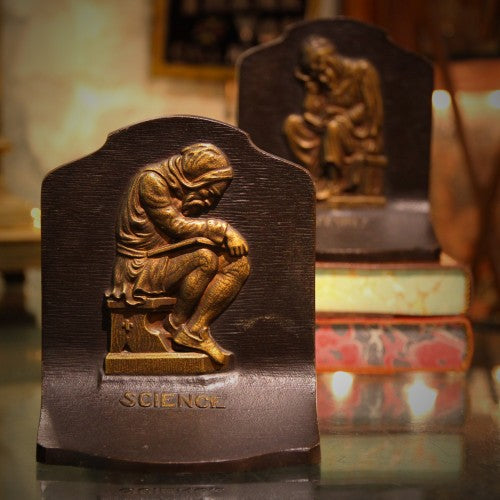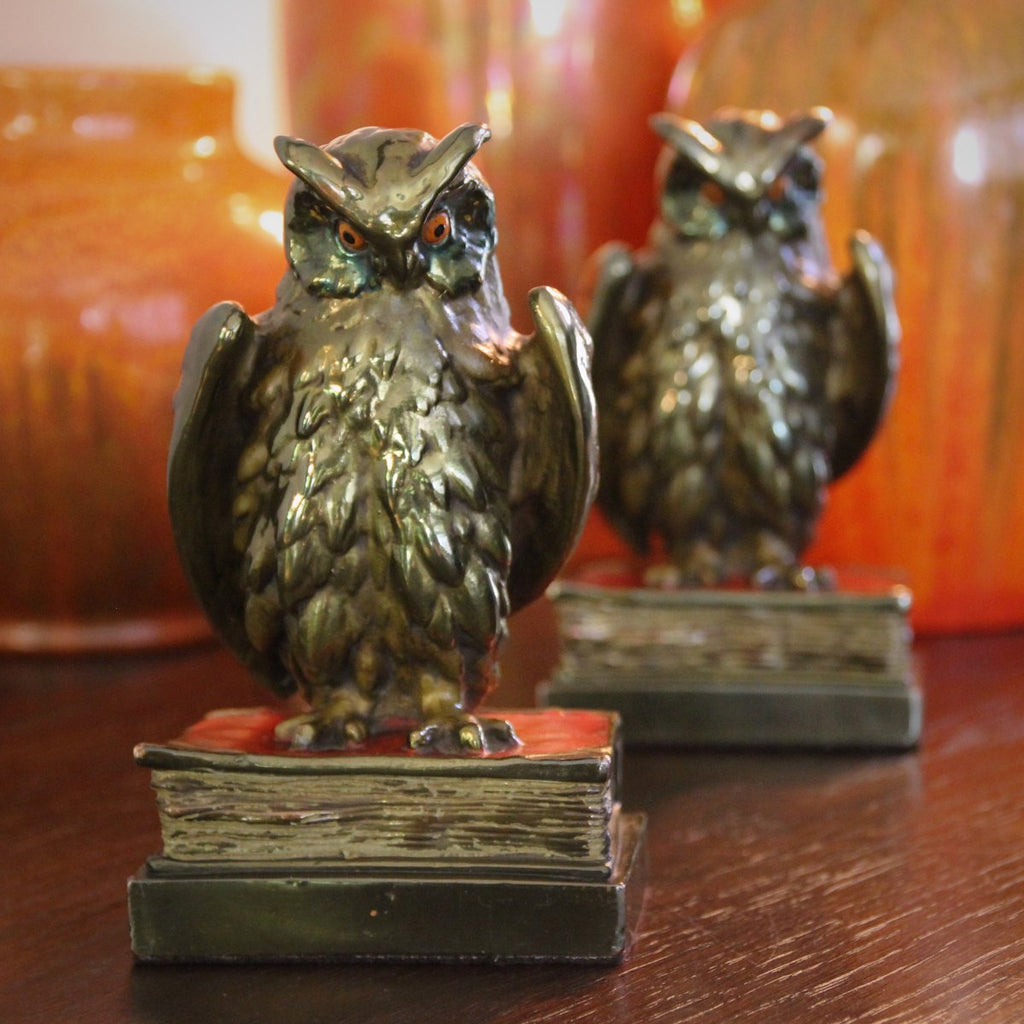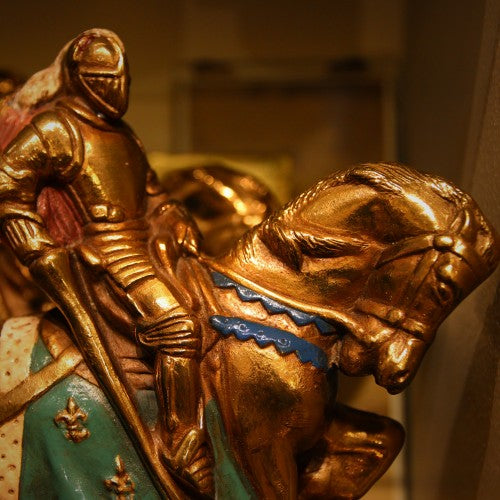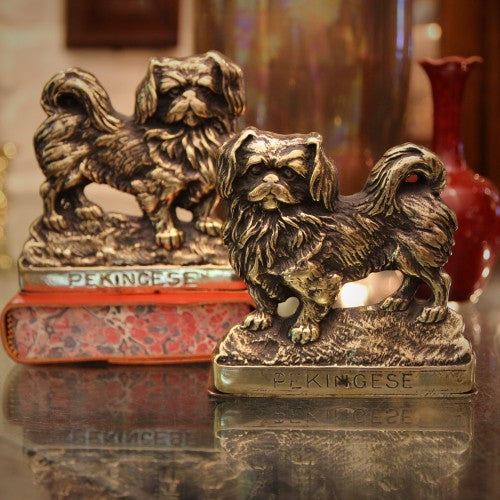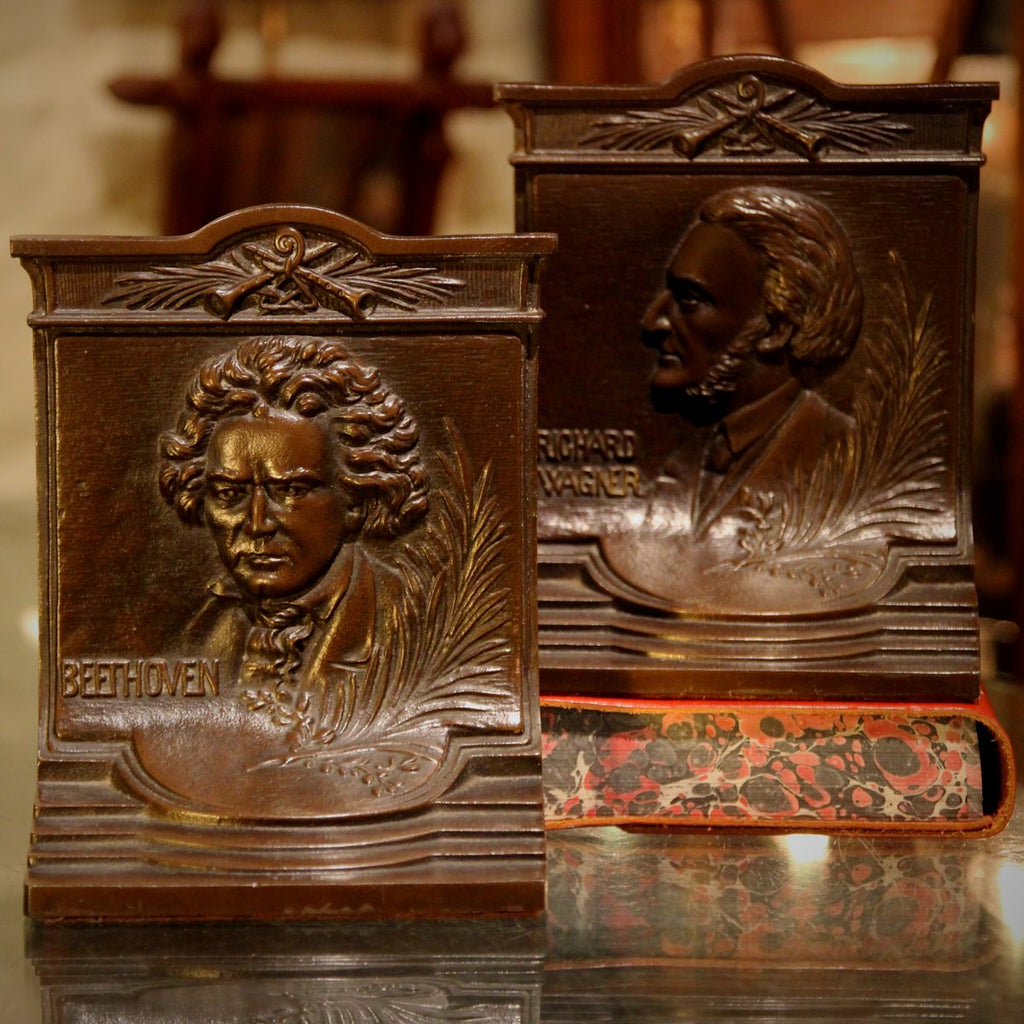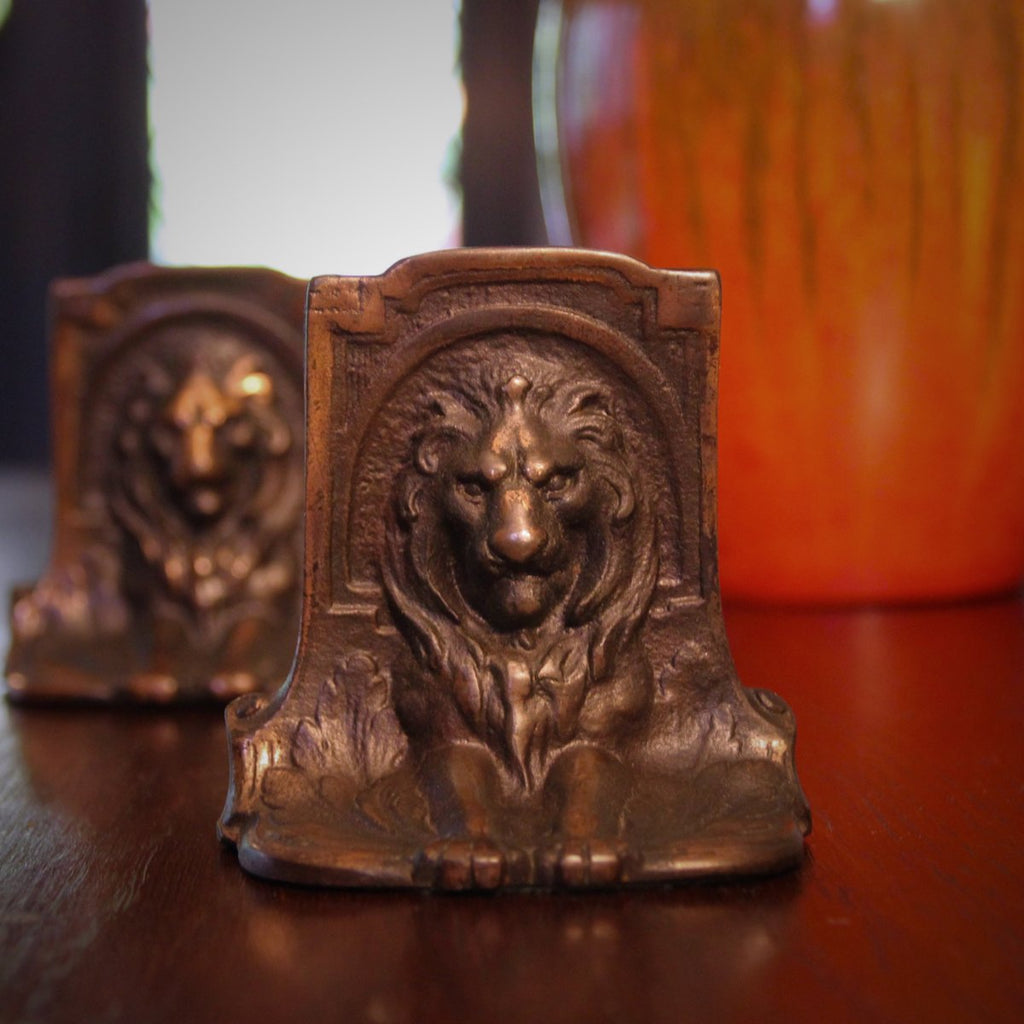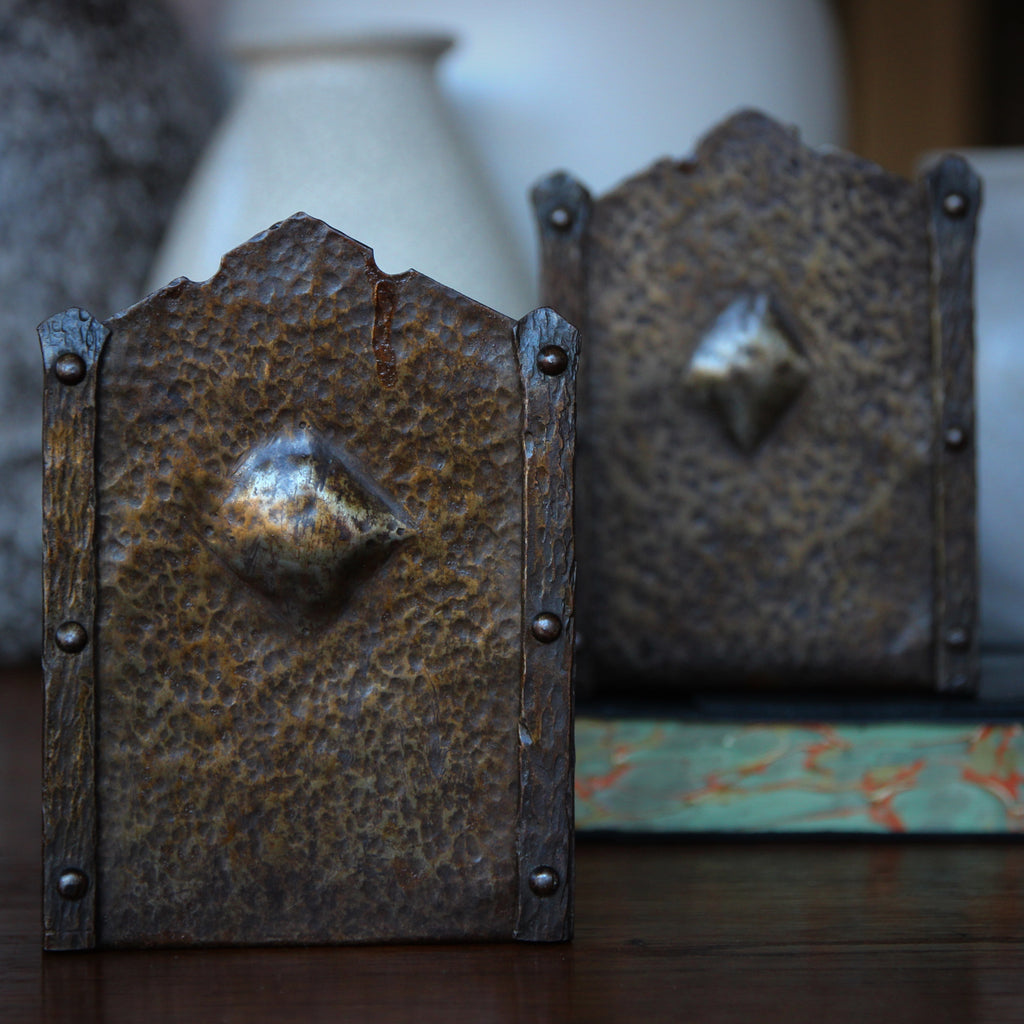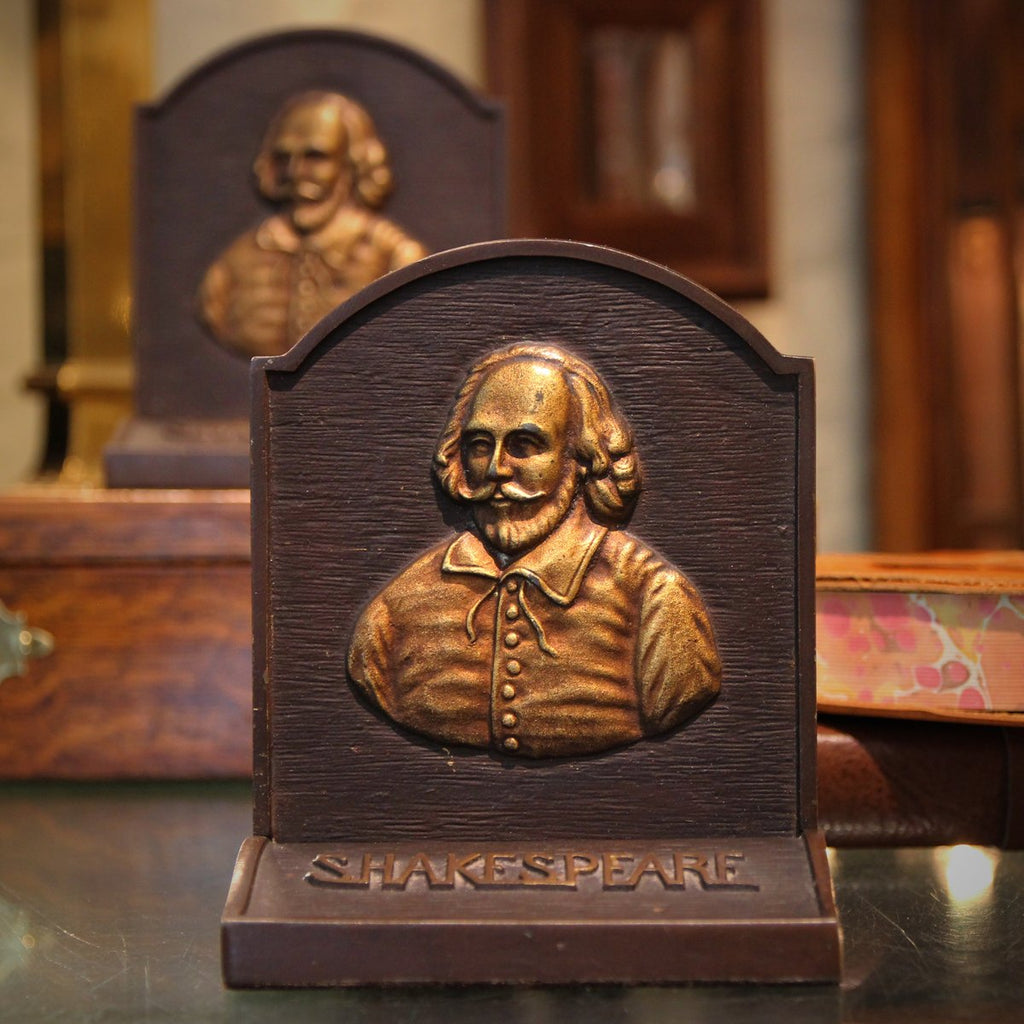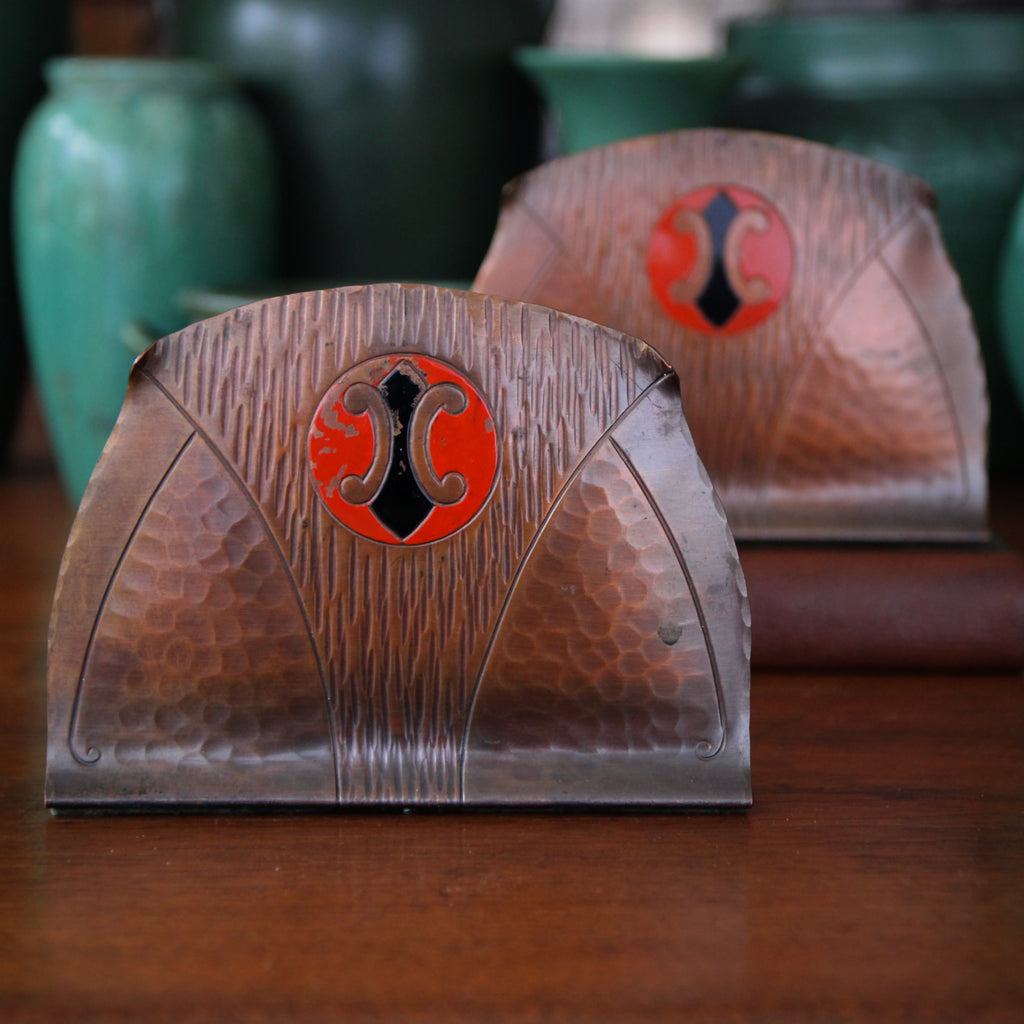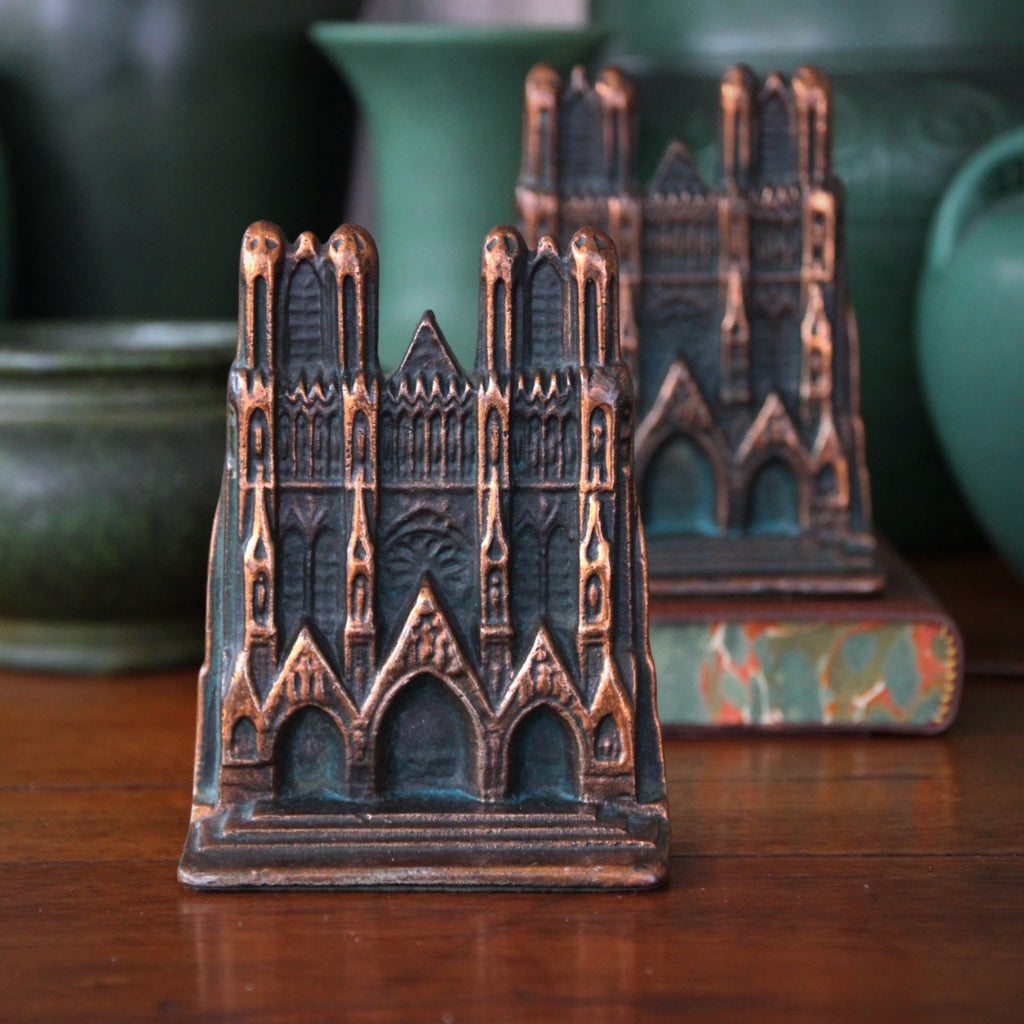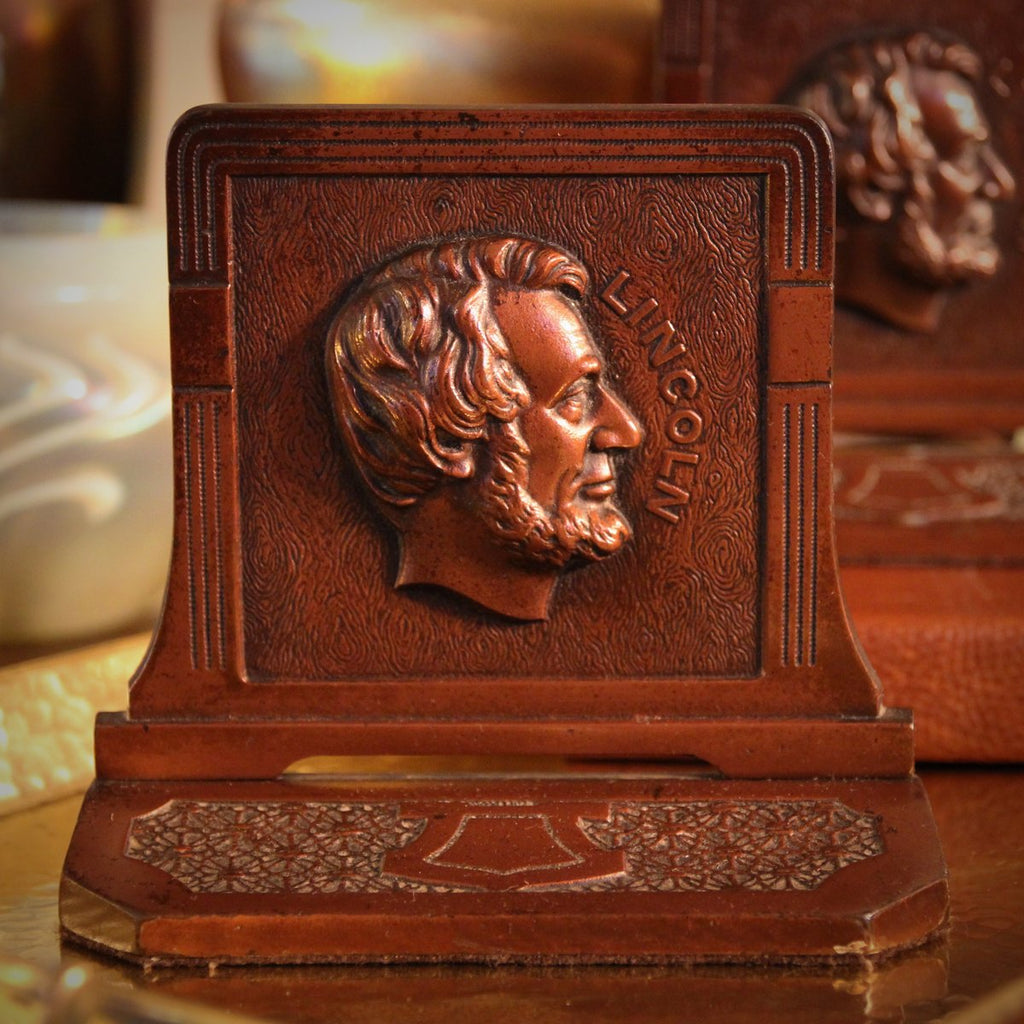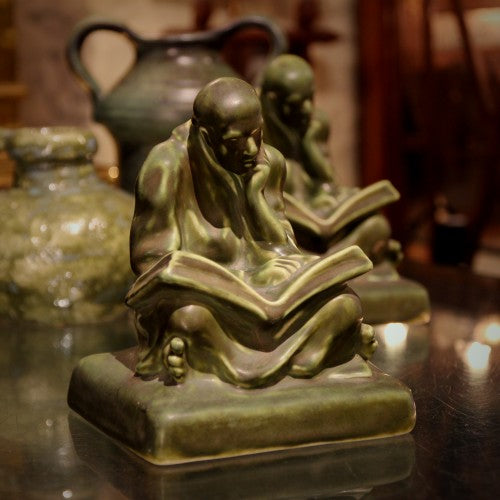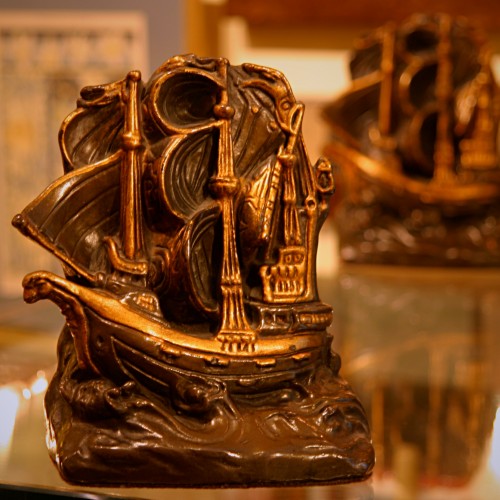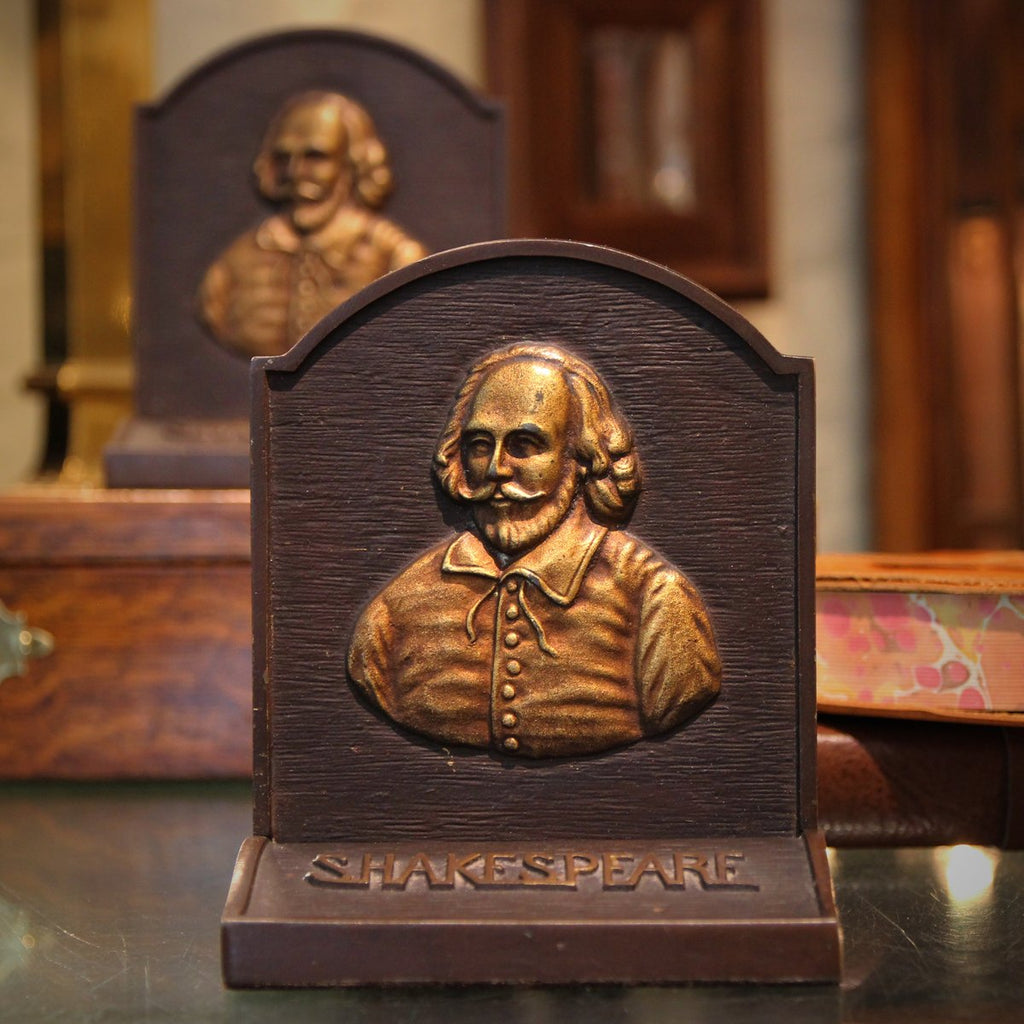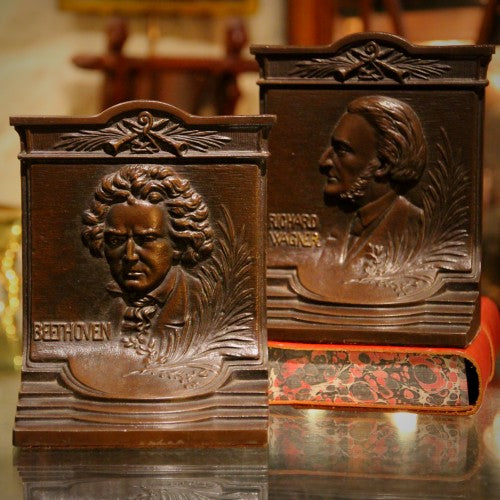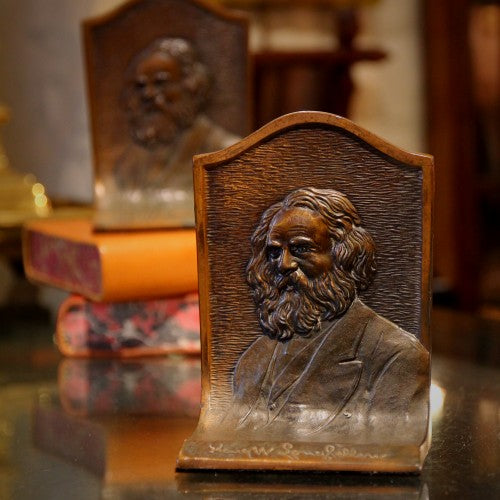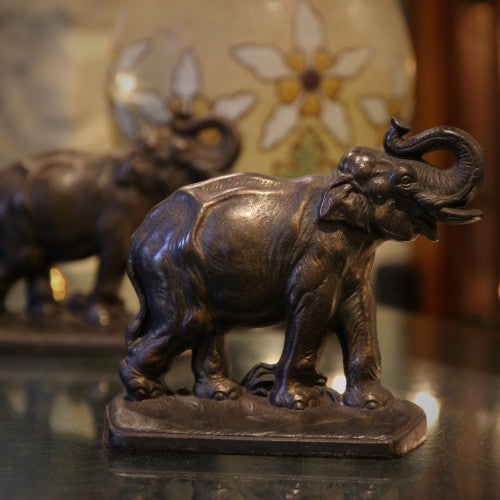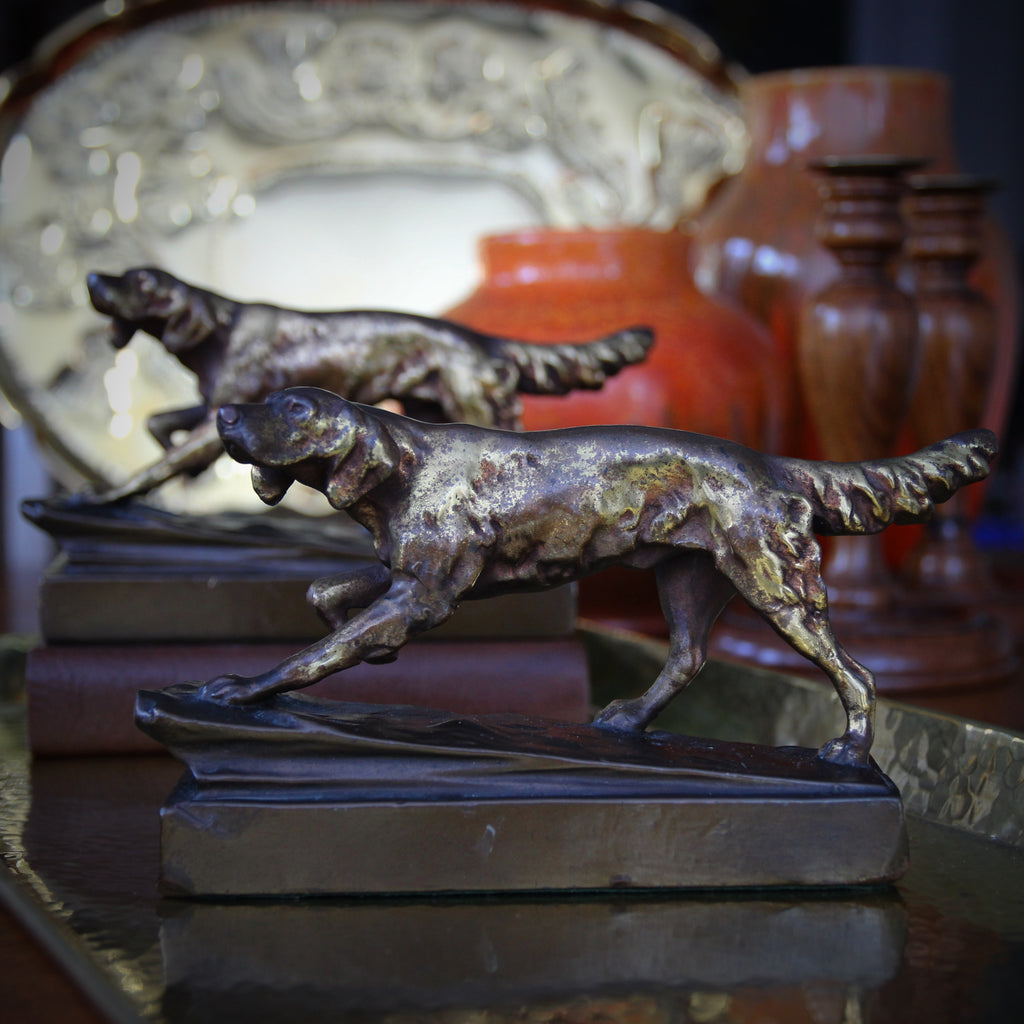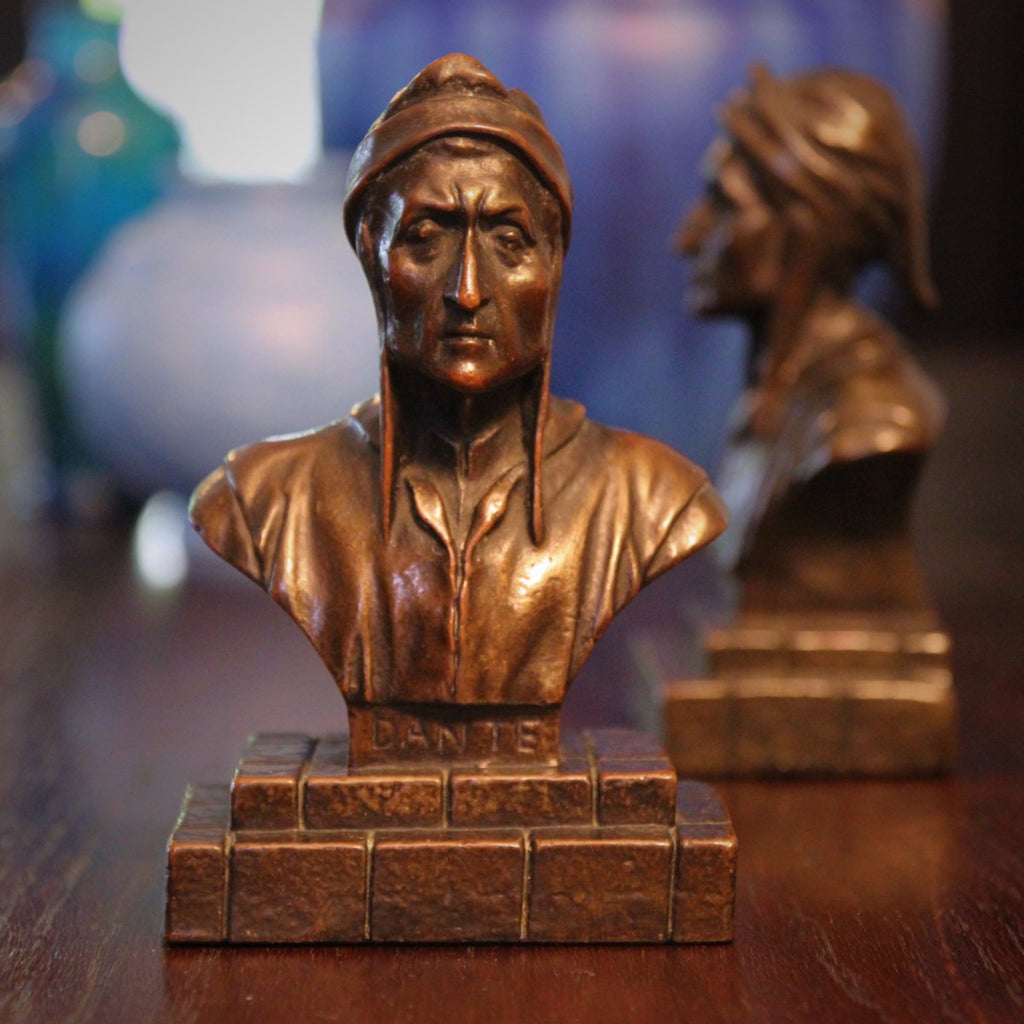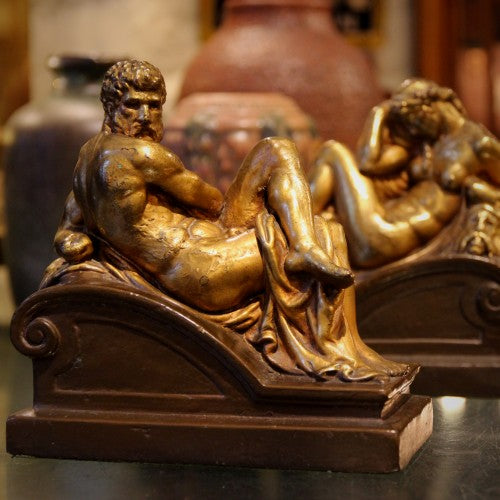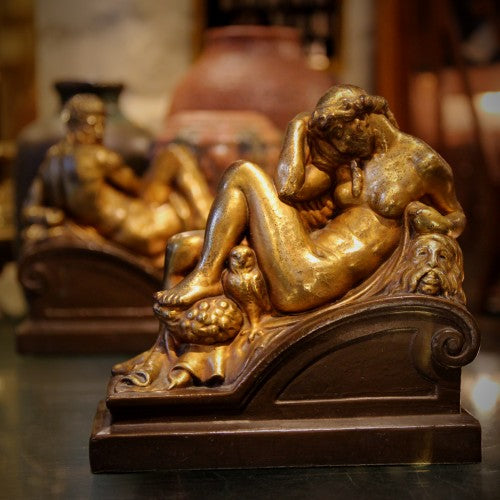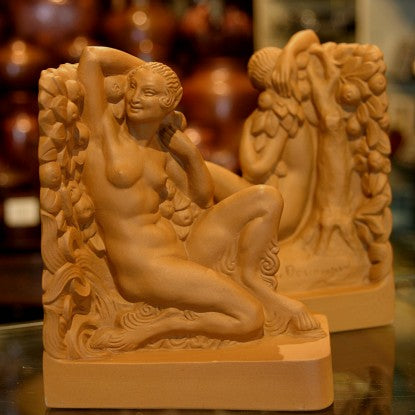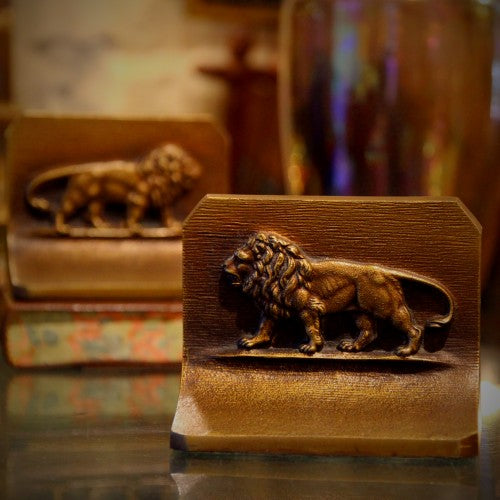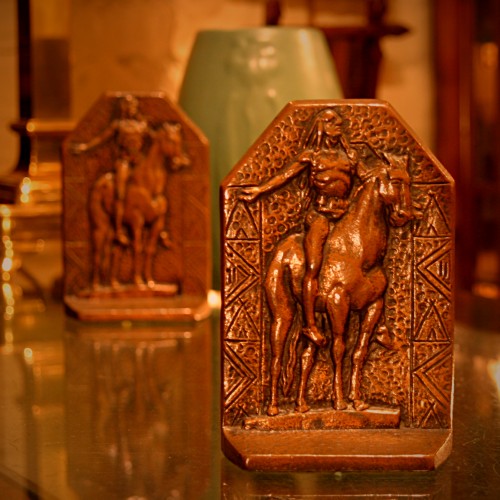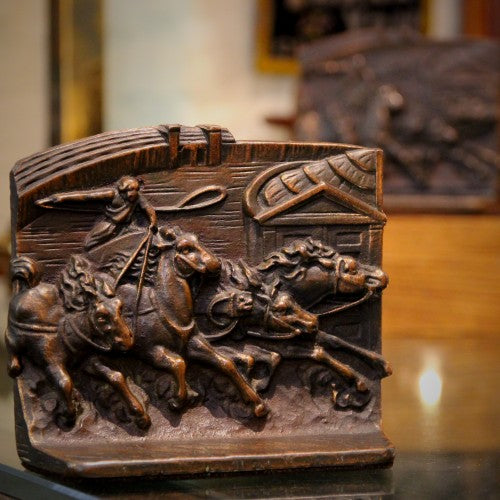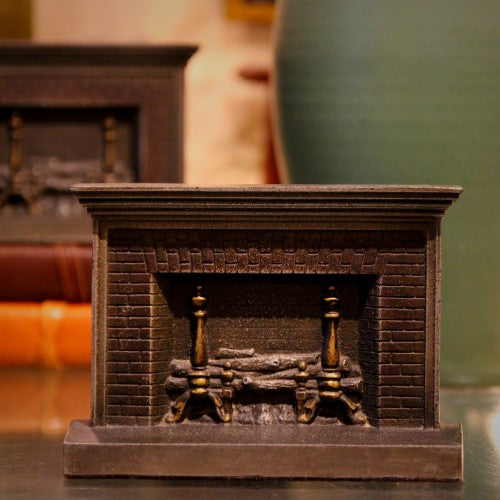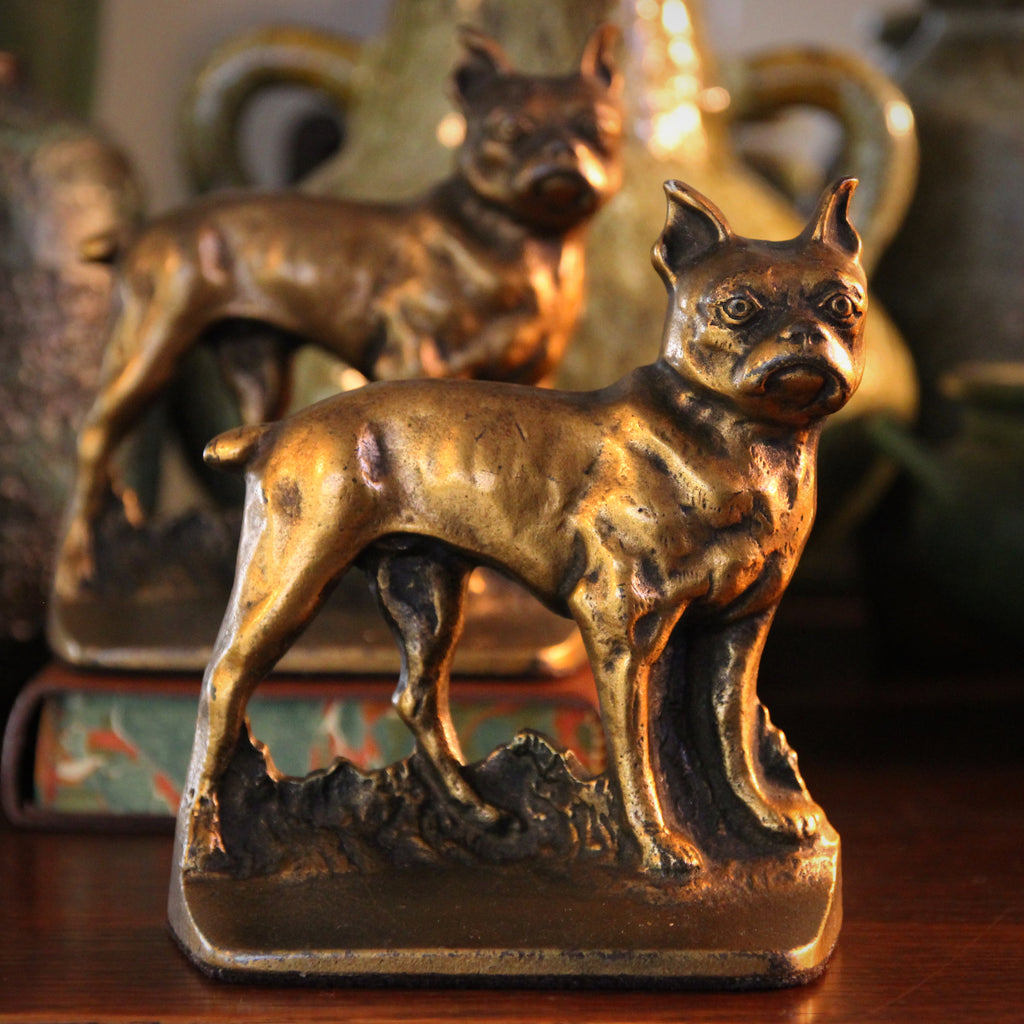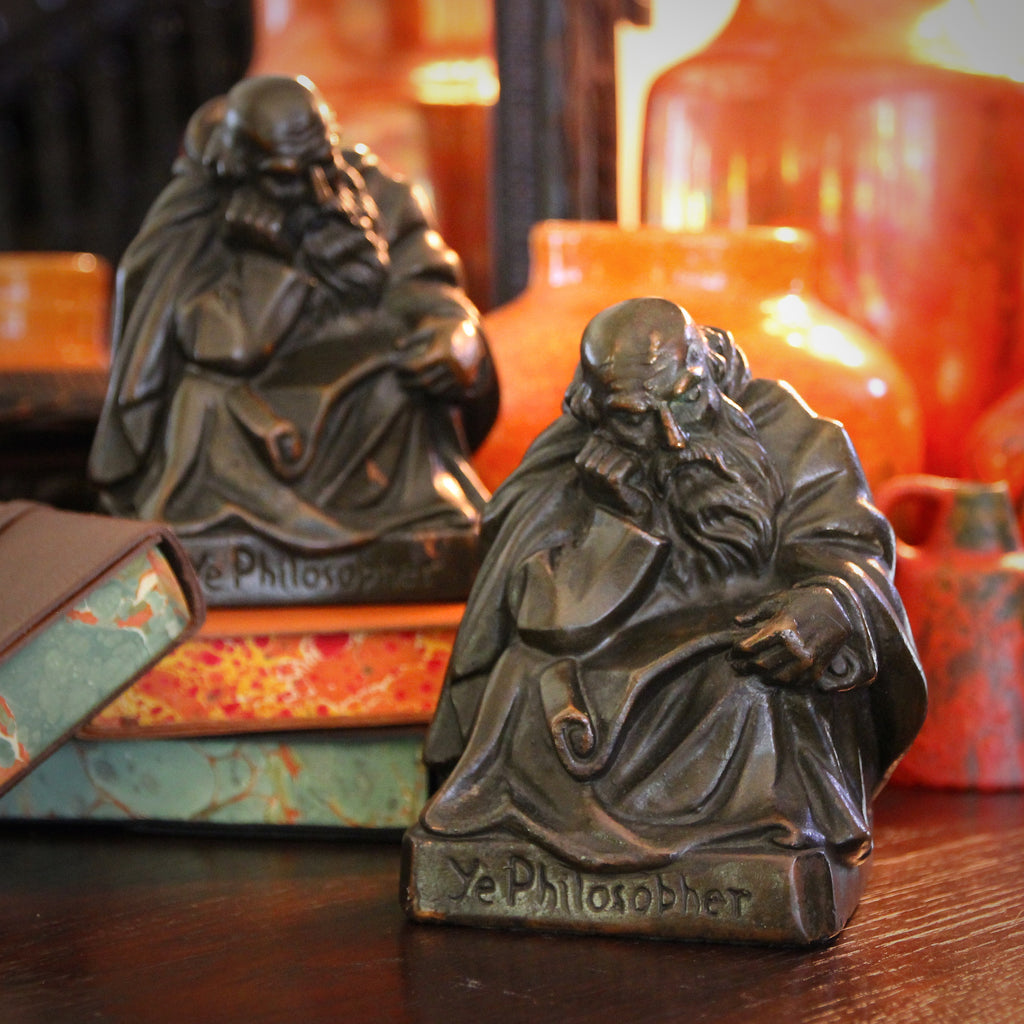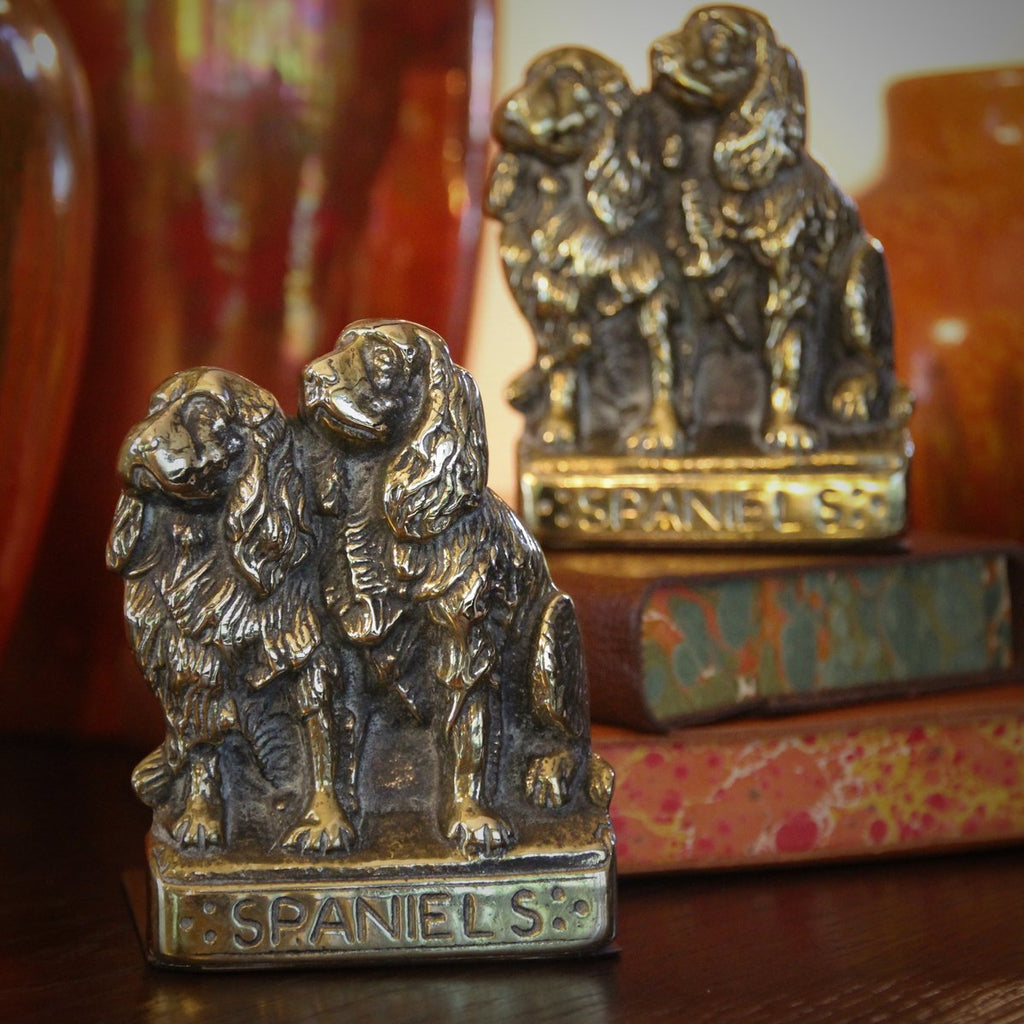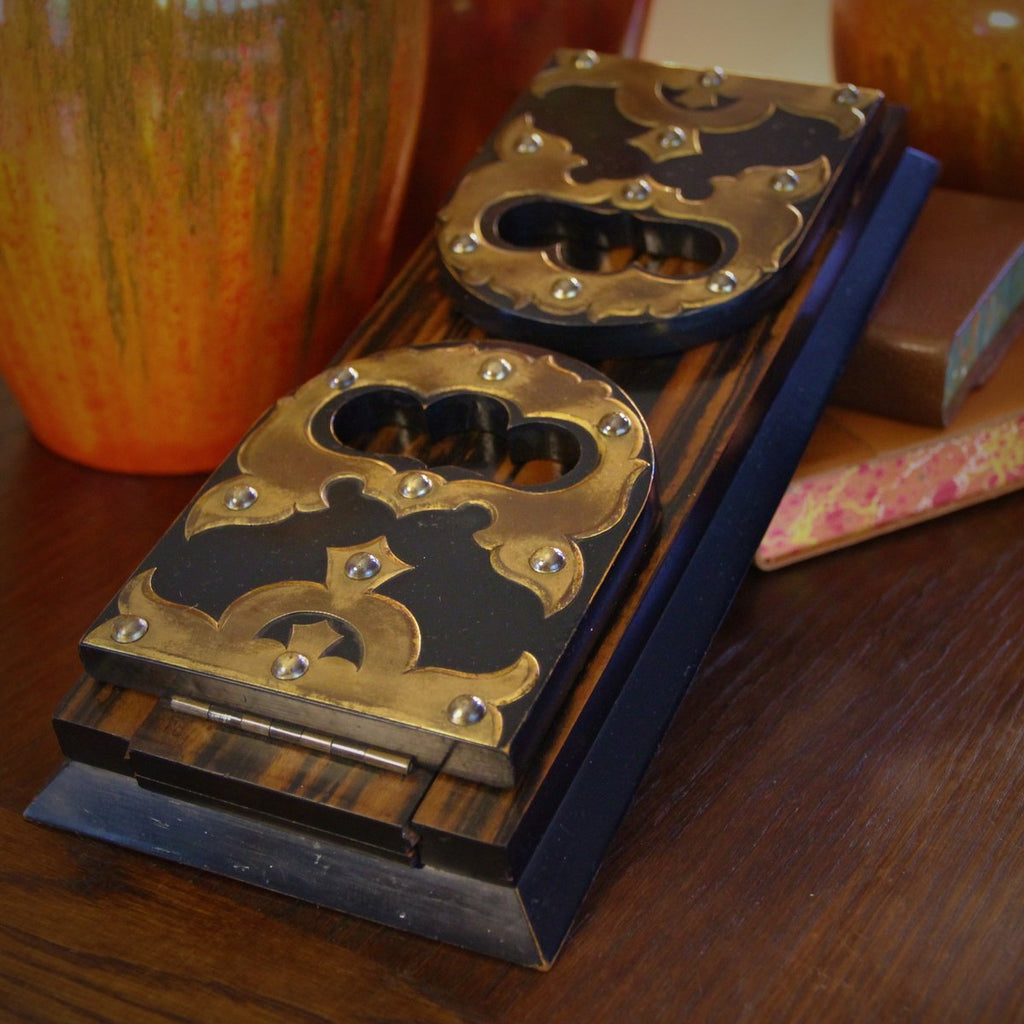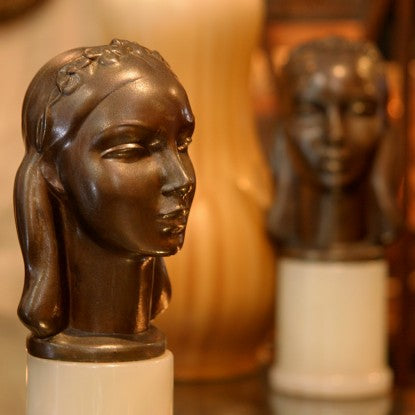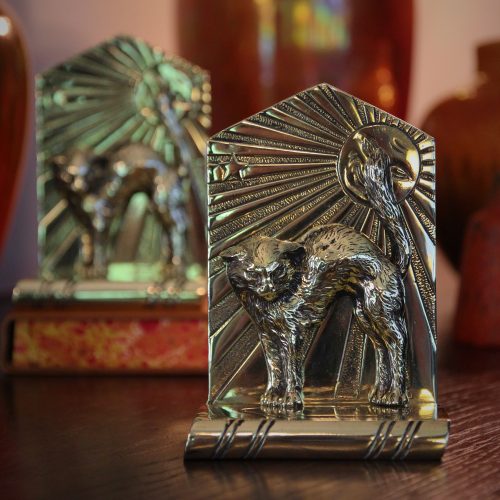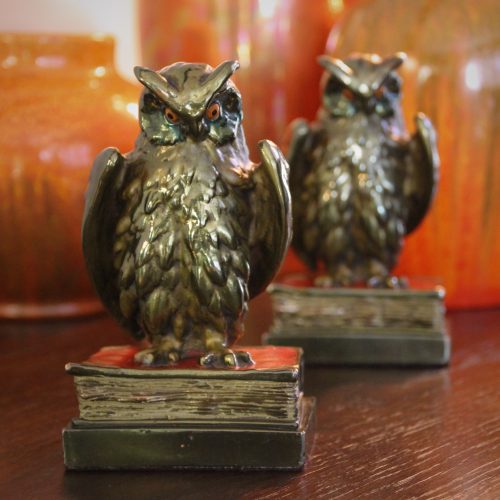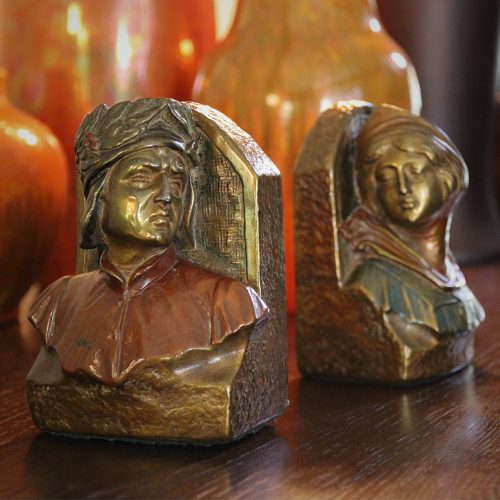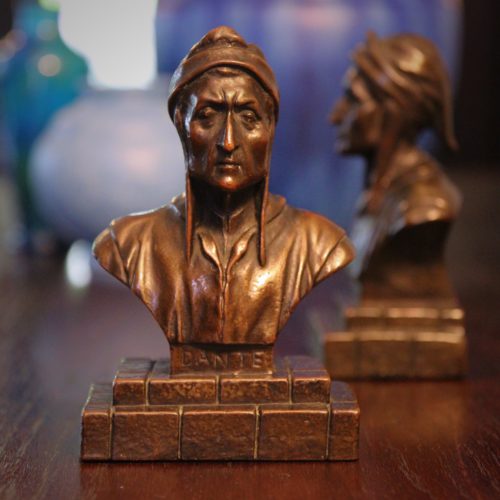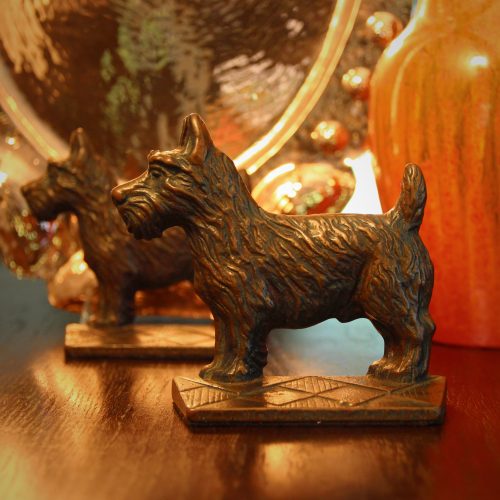JOURNAL — Bookends RSS
On this day in 1321 (or was it yesterday?), Italy's greatest writer, Dante Alighieri, died in-exile in Ravenna, Italy. Dante, born in Florence, found himself on the losing side of a political battle, after which he was banished from his beloved hometown on pain of death. He settled in Ravenna, some 65 miles away. It was here that he wrote his greatest work, the Divine Comedy. Ravenna, at first glance, is a somewhat modest town. But the city's plain appearance belies the glorious Early Christian (5th & 6th Century) mosaics which encrust the interiors of many churches and tombs. I sometimes imagine Dante standing before (or under) them—they were already 800 years old when Dante lived in Ravenna—gaining inspiration for his...
Ready for the Bell - part 5
Two British poets—a Scotsman and an Englishman—will bookend the growing library of your favorite British Literature scholar. Made by Bradley & Hubbard in the 1930's, they celebrate words, wisdom and knowledge. Please click on the photo above to learn more about them.
Though our Greenwich Village store is now permanently closed, LEO Design is still alive and well! Please visit our on-line store where we continue to sell Handsome Gifts (www.LEOdesignNYC.com).
We also can be found in Pittsburgh's historic "Strip District" at Mahla & Co. Antiques (www.mahlaantiques.com) or in Canonsburg, Pennsylvania at The Antique Center of Strabane (www.antiquecenterofstrabane.com).
Or call to arrange to visit our Pittsburgh showroom (by private appointment only). 917-446-4248
Ready for the Bell - part 3
What to give that Italian Classics major? She'd love this pair of stately bookends from the Twenties! Dante Alighieri, seated upon his chair of knowledge, leans forward, eager to hear every word. They are bronze-clad, patinated with an aged brass finish, and hand-painted in sections to give them a handsome "pop." And, while they will certainly supply inspiration during the school years, they will be a welcomed companion for decades to come—holding-up books and lending a classic air to any office, library or bookshelf. Click on the photo above to learn more about them. Though our Greenwich Village store is now permanently closed, LEO Design is still alive and well! Please visit our on-line store where we continue to sell...
Two Lords A'Leaping
Not really "Lords A'Leaping." Not Donner or Blitzen, either. But we are four months from Christmas Day! A good time to start shopping! Perhaps these Art Deco cast iron "Leaping Gazelle" bookends will do the trick. They're handsome, useful and very stylish—not to mention the ultimate "green gift." Please click on the photo above to learn more about them. Though our Greenwich Village store is now permanently closed, LEO Design is still alive and well! Please visit our on-line store where we continue to sell Handsome Gifts (www.LEOdesignNYC.com). We also can be found in Pittsburgh's historic "Strip District" at Mahla & Co. Antiques (www.mahlaantiques.com) or in Canonsburg, Pennsylvania at The Antique Center of Strabane (www.antiquecenterofstrabane.com). Or call to arrange to visit our Pittsburgh showroom (by...
Dog Days of Summer - part V
While we sweat through The Dog Days of Summer, let's not forget: the Fall will be upon us shortly. Here are a few handsome canines—now in-stock at LEO Design—which will bring a little cool for the next few weeks. This pampered pooch is rendered beautifully in cast brass, made in England in the 1920's or 1930's. He'd make a perfect gift for the Pekingese lover in your life—and bring a little touch of Imperial Grandeur to your office, den or bookshelf. Please click on the photo above to learn more about them. More "Dogs of Summer" tomorrow. Though our Greenwich Village store is now permanently closed, LEO Design is still alive and well! Please visit our on-line store where we...
Dog Days of Summer - part III
While we sweat through The Dog Days of Summer, let's not forget: the Fall will be upon us shortly. Here are a few handsome canines—now in-stock at LEO Design—which will bring a little cool for the next few weeks. American Bulldogs are a popular breed—as they were in the 1920's, when these bookends were crafted. Why, then, are Bulldog items so difficult to find? Perhaps bulldog lovers are loathe to give-up their treasured Bulldog accoutrements? In 25 years, I've found precious few Bulldog bookends, like the pair shown above. Click on the photo above to learn more about them. More "Dogs of Summer" tomorrow. Though our Greenwich Village store is now permanently closed, LEO Design is still alive and well!...
Dog Days of Summer - part I
While we sweat through The Dog Days of Summer, let's not forget: the Fall will be upon us shortly. Here are a few handsome canines—now in-stock at LEO Design—which will bring a little cool for the next few weeks. Bring a little touch of shooting party "Downton Chic" to your office, mantelpiece or bookshelf—while sparing the birds. This pair of "Hunting Bird Dogs" bookends, made in the 1920's, will hold-up your books loyally. Click on the photo above to learn more about them. More "Dogs of Summer" tomorrow. Though our Greenwich Village store is now permanently closed, LEO Design is still alive and well! Please visit our on-line store where we continue to sell Handsome Gifts (www.LEOdesignNYC.com). We also can be...
Born To Sculpt
John Ruhl (1873-1940) always knew he wanted to be an artist. His hardworking German father—who ran a shoe shop—discouraged his son's dream at every turn. Instead, 14 year old John was compelled to take a clerkship in an insurance office. The next year, John began taking art classes at the Metropolitan Museum where he entered an art competition (unbeknownst to his parents). When John's sculpture won, his father was impressed with seeing his son's name in the newspaper as well as the $100 prize—more than a month's earnings in his shoe shop. Ruhl was allowed to quit his job at the insurance company and apprentice himself to a prominent NY sculptor. He later joined the Piccirilli Brothers—one of the foremost...
Welcome Back, LEO!
It's 23 July—the first day of the sunsign LEO! It was during this month (24 years ago) that LEO Design first opened shop on Bleecker Street. What a time it's been! Although we've moved three times (eventually to Pennsylvania), we have not stopped buying and selling "Handsome Gifts" and home furnishings. Take this handsome pair of lions, perched on rocks, surveying their domain. They are bookends and are dated 1926—which makes them 93 years old. When I opened my store in 1995, they were only 69 years old! That's the nice thing about antiques: they just keep getting older and older. Click on the photo above to learn more about them. Though our Greenwich Village store is now permanently...
Always Popular
Why are Teddy Roosevelt Bookends so difficult to find? While Lincoln bookends are somewhat commonplace, TR bookends are quite scarce—and, therefore, costly. I have a few ideas of why this might be. First of all, factory-produced bookends are an early Twentieth Century phenomenon—and really reached their production zenith during the 1920's and 1930's. Before the Twentieth Century, few people who could afford to assemble large collections of books (only the wealthy). Working people (who made up the bulk of the 19th Century US population) might own a small handful of books—a Bible, perhaps a cookbook and a few books of poetry—thus, mass-produced bookends were not really needed. Wealthy collectors had rooms, shelved libraries, to protect, organize and store their tomes. Roosevelt's...
Fit for a Scholar
It's the Graduating Season and sometimes an uplifting gift is in-order. Amongst the world's best writers—and, certainly, Italy's greatest writer—is Dante Alighieri, scholar, poet and author of The Divine Comedy. In the Late Middle Ages, when Dante was writing, it was customary for serious literature to be written in Latin. Dante ignored this convention, writing in the Italian language (and, what's more, in the Tuscan dialect of his beloved Florence). Since his death in 1321, Dante has influenced numerous writers, right up to the current age. Dante's relevance to the modern age is not confined to his writing—but concerns his politics. It seems he found himself supporting the losing side of a political scrum in his home city of Florence. Alas,...
Bronze-Clad Beauties
These tenacious tuskers will really put their heads into keeping your books upright. Nicely modeled elephants are clad in a skin of bronze and finished with an antique patina—resulting in a handsome pair of bookends from the 1920's. They'd be right at home on your bookshelf, mantelpiece or holding-up reference tomes on your desk. Please click on the photo above to learn more about them. Though our Greenwich Village store is now permanently closed, LEO Design is still alive and well! Please visit our on-line store where we continue to sell Handsome Gifts (www.LEOdesignNYC.com). We also can be found in Pittsburgh's historic "Strip District" at Mahla & Co. Antiques (www.mahlaantiques.com) or in Canonsburg, Pennsylvania at The Antique Center of Strabane (www.antiquecenterofstrabane.com). Or call to arrange...
Out, Out Brief Candle!
On this day in 1616—precisely four hundred and three years ago—the world’s greatest poet and playwright died in his home town of Stratford-on-Avon, England. While there is some mystery surrounding Shakespeare’s death, we do know (or think we know) a few things. He had returned to Stratford (and his family) after 20 years of working in London. His day of death may have also been his 53rd birthday (though we don’t know his precise birthdate, only the day of his baptism). And he was buried in the chancel of the Holy Trinity Church, whose then vicar, John Ward, was a fan of The Bard. The cause of Shakespeare’s death has been debated. The Reverend Ward wrote in his diary: “Shakespeare, Drayton and...
Good Friday
Today is the most solemn day on the Christian calendar—the day when Jesus endured His Passion, was crucified and laid into the tomb. Coming after Lent, a long period of atonement and reflection, this darkest of days will soon be followed by the most joyous of Christian events—Easter and the Resurrection. Though our Greenwich Village store is now permanently closed, LEO Design is still alive and well! Please visit our on-line store where we continue to sell Handsome Gifts (www.LEOdesignNYC.com). We also can be found in Pittsburgh's historic "Strip District" at Mahla & Co. Antiques (www.mahlaantiques.com) or in Canonsburg, Pennsylvania at The Antique Center of Strabane (www.antiquecenterofstrabane.com). Or call to arrange to visit our Pittsburgh showroom (by private appointment only). 917-446-4248 Follow us on Instagram:...
Architects Attempt Sculpture
Though clearly Art Deco—in period and style—these 1930's bookends foreshadow the "Brutalist" aesthetic to come two decades later. Brutalism was a design ethic which swept worldwide architecture in the third-quarter of the Twentieth Century. Coming on the heels of the Second World War, it sought to overturn the (so-called) "frivolous" aesthetic of previous human generations, and, perhaps, to shock the world with its defiant rejection of grace. Brutalism is known for its brazen angularity and a lack of any concern for "fitting-in" to the existing community of buildings. Though it is often described as the expression of "function over form," it is more often perceived as an insolent disregard for traditional conventions of beauty. The new, post-War generation of designers...
The Temple of Concordia
The Tempio della Concordia in Agrigento, Sicily, is the best preserved Doric Order temple in the world (alongside the Parthenon in Athens). It was built around 440-430 BC when the pre-Italian island was an important part of the Greek world. It was later named after the Roman goddess of harmony. It is surrounded by 20 foot tall fluted columns—six along each short side and 13 along each long side—topped, naturally, with Doric capitals. Each column tapers subtly near the top and swells gently in the middle which gives the column a dynamic tension—as though the column were straining to bear the weight of the roof. The temple was converted to a Christian Basilica (of Saints Peter & Paul) in the...
The Horse Tamers
In the Art Deco period, "heroic" human figures—like this "Trojan Horseman"—would be used as decorative elements in the architecture of the day. Usually, the sculpture was designed to represent some intangible element of a robust society: commerce, labor, agriculture. A walk through central Washington, DC will present many such examples—on Thirties buildings which manage and guide the various important agencies for the nation. The theme of "Horse Tamers" in artwork is one that goes back to Rome with the monumental sculptures of Castor & Pollux (and their horses) standing near the Baths of Constantine on Quirinal Hill. A pair of sculpted Horse Tamers by Baron Peter Clodt von Jurgensburg (plus two more by a different artist) grace the Anichkov Bridge...
Peterborough Cathedral
Some 85 miles north of London stands Peterborough Cathedral, one of the great churches of Britain. Principally built between 1118 and 1237, this English Gothic masterpiece stands on the site of an earlier church, founded in 655. Saints Peter, Paul and Andrew look down from the three central gables, appropriate as the cathedral's official name is the Cathedral Church of Saint Peter, Saint Paul and Saint Andrew. The church was originally a Catholic house of worship. When Henry VIII "dissolved the monasteries"—thus stripping the churches of their precious objects and banning Catholic worship—it was converted to an Anglican cathedral. But Henry's first wife, Catherine of Aragon, had already been buried in the church—and remains there to this day. Later, the Scottish...
Gifts for Smart People - part VII
Let's end our little parade of bookends in feline style: with this pair of antique cast iron bookends from the Twenties. A pair of proud lions survey their domain from atop this craggy mountaintop. Beautifully modeled, nicely cast and finished with an (aged) copper wash, they would make a handsome addition to any office, den or bookshelf—and make any good LEO happy. Please click on the photo above to learn more about them.
LEO Design's Greenwich Village store is now permanently closed. While we contemplate our next shop location, please visit our on-line store which continues to operate (www.LEOdesignNYC.com).
Follow us on Instagram: "leodesignhandsomegifts"
Follow us on Facebook: "LEO Design - Handsome Gifts"
Gifts for Smart People - part VI
Which pair of bookends could be more-appropriate for a smart person than those called "The Thinker"? Rodin first created "Le Penseur" in 1880 as part of a larger sculpted grouping called "The Gates of Hell," based on Dante's The Divine Comedy. The first large stand-alone "Thinker" was cast in 1904 and the public was intrigued by a work which perfectly suited the times. Psychology increasingly was viewed as a legitimate science and the public was fascinated with the human mind and the theories of Sigmund Freud. "The Thinker" became an icon of the Turn-of-the-Century zeitgeist. The bookends shown above were made in the 1920's—when "The Thinker" was still a relatively recent novelty. First, the bookend maker needed to sculpt an artful and accurate model...
Gifts for Smart People - part V
The Boston Terrier was actually first "created" in Liverpool, England. It was a terrible time for dogs and other animals—the mid Nineteenth Century—as "bloodsports" were a popular pastime, pitting dogs against other animals (including dogs) in fights-to-the-death. Attempting to create a novel "pit dog," a Bulldog was crossed with an English White Terrier (now extinct). This dog, named "Judge," was purchased by a Bostonian who brought him back to the States and bred him to develop and establish the breed. Today the breed is known for its curious and sprightly nature, its sharp "tuxedo" coat and its gentlemanly behavior. These bookends, from the 1920's, were made when Boston Terriers were even more popular than they are today. In the Teens,...
Gifts for Smart People - part IV
I like to visit beautiful cemeteries—especially those with strong Nineteenth and early Twentieth Century monuments. Highgate in London, Père Lachaise in Paris. A quiet afternoon here is an afternoon well-spent. Cemeteries are quiet, verdant, and usually well-appointed with beautiful sculpture and architecture. So, when I found myself with a little extra time in Budapest, I made my way to the Kerepesi Cemetery—at the end of the Metro line, in what was once "just outside" of the old city. Here I spent a wonderful couple of hours, meandering amongst the graves and admiring the handsome sculpture-rich monuments erected by loving survivors. The bronze-clad bookends above were modeled by sculptor Julio Kilenyi in the 1910's or 1920's. Kilenyi was born in Arad...
Gifts for Smart People - part III
I like people who love dogs. And people who love books. That said, these bookends really hit the mark! They were made of cast iron and finished with a copper wash in the 1920's or 1930's—a time when bulldogs were amongst the most popular of pet dog breeds. Though the breed diminished in popularity over the ensuing decades, bulldogs did have one high-profile moment during World War Two when they became forever linked with the resolve, tenacity and (well) doggedness of British Prime Minister Winston Churchill. Please click on the photo above to learn more about them. More handsome bookends tomorrow. LEO Design's Greenwich Village store is now permanently closed. While we contemplate our next shop location, please visit our on-line...
Gifts for Smart People - part II
Does anyone dislike Gothic architecture? To me, the Gothic (and Gothic Revival) marks the high-water mark of human architectural achievement. And though you may not live in a Gothic Castle (or Cathedral), you could have a handsome (and heavy) pair of Gothic Arch bookends. Made by Bradley & Hubbard (Meriden, CT) in the 1920's or 1930's, these bookends will bring a handsome touch of Gothic architectural interest to your (non-Gothic) home or office. They would also make a great gift for a smart person in your life. Please click on the photo above to learn more about them. More handsome bookends tomorrow. LEO Design's Greenwich Village store is now permanently closed. While we contemplate our next shop location, please...
Gifts for Smart People - part I
Owls have long represented Wisdom—since the days of Athena, Goddess of Wisdom and Athens's namesake. More recently, bookends have become the perfect gift for smart people. Why? Well, first of all, one only needs bookends if one has books. And one only has books if one loves wisdom, learning and knowledge. Add to this the fact that a handsome pair of bookends are practical and aesthetically pleasing—like the pair of bronze-clad bookends, shown above. Made in the 1920's, these nicely-modeled bookends were electroplated in bronze, then patinated and punctuated with hand-painting. They'll bring style—and a certain sense of erudition—to your desk, bookshelf or office. Learn more about them by clicking on the photo above. More handsome bookends tomorrow. LEO...
O Solo Mio...
This handsome pair of Art Deco bookends, made in the 1920's, portray a pensive cellist—tortured, talented, tenacious. Artfully sculpted and clad in electroplated bronze, they still retain much of their original polychrome painting. A wonderful gift for a cellist, musician or music-lover. Learn more about them by clicking on the photo above.
LEO Design's Greenwich Village store is now permanently closed. While we contemplate our next shop location, please visit our on-line store which continues to operate (www.LEOdesignNYC.com).
Follow us on Instagram: "leodesignhandsomegifts"
Follow us on Facebook: "LEO Design - Handsome Gifts"
Little Journeys
Elbert Hubbard, founder of the Roycroft community in East Aurora, New York, modeled his campus on the progressive—and reformist—arts colonies in turn-of-the-century England. Besides metal working, furniture making and lamp crafting, the printing of books, cards and posters was needed to bring education and culture to the eager minds of the day. Hubbard created his "Little Journeys" series: a monthly subscription of books which detailed the lives of the artistic, important and influential. Each year, a new topic would be introduced, whether musicians, orators, scientists or men of letters. The bookends above, made by Roycroft, were intended to hold up one's collection of Little Journeys booklets. You will learn more about them by clicking on the photo above. LEO Design's Greenwich Village...
Oh, Jerusalem!
For much of the world's population, religiously speaking, Jerusalem stands at the center of the world. I have visited this singular city and was amazed at how so many different people live so tightly together. Occasional tensions flare—sometimes very seriously. But, after thousands of years, the people mostly exist side-by-side, tolerantly and compatibly. Perhaps these Modernist olive parquet bookends, made in Jerusalem, can help illustrate the city's character: discrete, unique and separate individuals, though cobbled together, can maintain their identity while creating a greater (and beautiful) assemblage. Click on the photo above to learn more about them. LEO Design's Greenwich Village store is now permanently closed. While we contemplate our next shop location, please visit our on-line store which continues...
The Song of Hiawatha
On 10 November 1855, the long-form poem “Song of Hiawatha” by Henry Wadsworth Longfellow was published. It proved popular, selling 50,000 copies within the next two years. While the poem is considered a masterpiece of American Romantic literature, it is not necessarily an accurate, historical rendering of Native American people and their lives. Nevertheless, the […]
Thomas Nast and his Elephant
Thomas Nast was the popular and powerful cartoonist, lecturer, and political thinker of the American 19th century. He did much of his work for Harper’s Weekly in New York City. On this day in 1874, Nast introduced the Elephant as the symbol for the Republican party—a mascot which survives to this day. Nast has been […]
A King is Discovered
On this day in 1922, British archeologist Howard Carter uncovered the tomb of King Tutankhamun. Not only did this discovery set the scientific, historical, and archeological worlds ablaze, but it sparked a revival of “Egyptian Mania” in the decorative arts. “King Tut” took the throne at the age of 9 or 10 and held it […]
The Battle of Trafalgar
On this day in 1805, England savored one its greatest military wins in history—defeating the combined navies of France and Spain. In the Battle of Trafalgar, led on the British side by Admiral Horatio Lord Nelson, the French and Spanish lost 22 ships; England lost none. The win was so decisive, it changed the trajectory […]
Call Me Ishmael . . .
“Call me Ishmael,” is perhaps the most famous opening line of any American Novel yet written. On this day in 1851, The Whale, by Herman Melville, was published by Richard Bentley in London. A few weeks later, it was published in New York under the name Moby Dick; or, The Whale. Although it was met with lukewarm […]
And a Literary Genius, Too
And speaking of artistic geniuses, let’s not forget “The Bard,” William Shakespeare (1564 – 1616). Perhaps the world’s greatest playwright—of all time—his plays have influenced many other written works, have been adapted into musicals and operas, and have made a profound contribution to the spoken English language. The bookends above, made by Bradley & Hubbard […]
Greatest. Artist. Ever.
The World is full of wonderful art—of varying (and disparate) eras, materials and aesthetics. How can one possibly identify an all time favorite artist—especially if he loves so much art? Well, for me it's easy. My all-time favorite artist jumps right out: Michelangelo Buonarotti of Renaissance Florence. He was a true Artistic Genius. Michelangelo lived in a place and era of artistic upheaval, dominated by artistic titans. And Michelangelo was the best! He painted (the ceiling of the Sistine Chapel), he sculpted (David, for starters) and he designed landmarks (like the dome of Saint Peter's Basilica). Popes and princes sought Michelangelo's labors—perhaps realizing that his divine artistry may provide them with a bit of earthly eternity. The bronze-clad bookends, shown above, are modeled after...
Talk Like a Pirate!
Two friends, Mark Summers and John Bauer, were playing a friendly game of racquetball. “Ahrrrrrr!” one cried as the ball hit him. And, thus, was born “International Talk Like a Pirate Day!” In truth, the founding incident took place on 6 June 1995—commemorated as D-Day—but out of respect for that historical milestone, they decided to […]
“Extra! Extra!”
Today is National Paperboys’ Day. On this day in 1833, ten year old Barney Flaherty was hired to deliver the New York Sun. Little Barney—responding to a classified ad seeking “a number of steady men”—was the first of countless boys who made money delivering newspapers door-to-door or on the streets. Despite the romanticized, iconic image […]
In Recognition of Labor
Today let us salute—and thank—all those who contribute to our country by the sweat of their brows and the brawn of their biceps. For all those strong legs, straight backs, and enduring wills, let’s be grateful. The iron man, depicted on the cast iron bookends above, represents the hundreds of thousands of iron mill workers […]
The Tail End of Summer's Dog Days
The Summer doldrums—sometimes called the Dog Days—will soon be behind us. Sweaters will come-out and the school bell will ring. This pair of bronze bookends capture a finely-cast terrier—alert and tense with energy. He'll happily round-up and supervise your book collection on desk, bookshelf or credenza. Click on the photo above to learn more about it.
LEO Design's Greenwich Village store is now permanently closed. While we contemplate our next shop location, please visit our on-line store which continues to operate (www.LEOdesignNYC.com).
Follow us on Instagram: "leodesignhandsomegifts"
Follow us on Facebook: "LEO Design - Handsome Gifts"
Rectory Chic
Do you ever feel like exiting the rat race? Leaving the city? Joining a nice, simple, cloistered monastery? Perhaps that fleeting feeling is best contemplated during less-stressful moments. In the meantime, a touch of Rectory Chic might give you just enough of a momentary retreat to get you through the rest of the day. Made in the […]
Lots of LEOs - XV
The only thing better than a LEO is—two LEOs! This pair of bookends, made by Bradley & Hubbard (Meriden, CT) in the 1930's, are crafted of cast iron and finished with a golden wash. They are inspired by the Nineteenth Century work of French anamalier Antoine-Louis Barye. Because they are "mirrored"—that is, one faces left while the other faces right—two moulds were required (and twice as much work). It also means that both of your lions will be facing forward on your bookshelf. Please click on the photo above to learn more about them. Another LEO tomorrow. LEO Design's Greenwich Village store is now permanently closed. While we contemplate our next shop location, please visit our on-line store which...
Lots of LEOs - XI
Not every LEO lives in the savannah. These fierce little lions prowl a British backyard. Crafted in England in the 1930's, these cast brass bookends have an "illustrated storybook" sensibility— and were designed and made at a time when children's books did not shy from the spooky, the dark or the moral-laden. Learn more about them by clicking on the photo above.
Another LEO tomorrow.
LEO Design's Greenwich Village store is now permanently closed. While we contemplate our next shop location, please visit our on-line store which continues to operate (www.LEOdesignNYC.com).
Follow us on Instagram: "leodesignhandsomegifts"
Follow us on Facebook: "LEO Design - Handsome Gifts"
Lots of LEOs - VIII
Antoine-Louis Bayre (1795-1875) was the premier Parisian Anamalier of the Nineteenth Century. Even today, he remains amongst the best sculptors of animals in history. His works displayed classic, active and highly naturalistic poses—capturing the energy, beauty and dignity of his wild animal subjects. Bayre was well-known in his lifetime and many of his works were cast in various sizes which allowed his work to find homes in museums, grand palaces or upper middle class homes. This pair of bookends, made by Bradley & Hubbard (Connecticut) in the 1920's or 1930's, are inspired by the French master's work. Please click on the photo above to learn more about them. Another LEO tomorrow. LEO Design's Greenwich Village store is now permanently...
Lots of LEOs - VII
Rippling with tension and anticipation, this regal lion stalks its prey from atop a rocky cliff. The sculptor really captured the energy and attitude of this feline predator—a pair of bookends from the 1920's or 1930's. They are a gift sure to inspire any hardworking LEO seeking to succeed in today's jungle. Please click on the photo above to learn more about this gift.
Another LEO tomorrow.
LEO Design's Greenwich Village store is now permanently closed. While we contemplate our next shop location, please visit our on-line store which continues to operate (www.LEOdesignNYC.com).
Follow us on Instagram: "leodesignhandsomegifts"
Follow us on Facebook: "LEO Design - Handsome Gifts"
Lots of LEOs - V
A (hungry-looking) mountain lion stalks its prey on this pair of cast iron bookends from the 1920's. Beautifully sculpted, it crackles with tension—and still has small remnants of its original (90 year old) paint. Please click on the photo above to learn more about it.
Another LEO tomorrow.
LEO Design's Greenwich Village store is now permanently closed. While we contemplate our next shop location, please visit our on-line store which continues to operate (www.LEOdesignNYC.com).
Follow us on Instagram: "leodesignhandsomegifts"
Follow us on Facebook: "LEO Design - Handsome Gifts"
Lots of LEOs - I
Welcome, LEO! It was 28 years ago, this month, when we first opened our doors on Bleecker Street. Boy, how things have changed! One thing that has not changed is the enormous pride LEOs take in their sun sign, the lion. Therefore, indulge us why we share a "parade" of lion items over the next several days. Shown above, a pair of cast iron "Proud Lion" bookends from the 1920's. They have been cast in fine detail and finished with a copper patina. Made in the 1920's, they will be warmly-received by any self-respecting LEO. Please click on the photo above to learn more about these bookends. And, by the way, LEO extends from 23 July to 22 August. Another LEO...
The Dog Days of Summer
It’s already happening—the Dog Days of Summer have arrived. Hot. Smelly. The crosswalk seemingly sinking beneath our feet. But where does the term originate? It began in ancient Rome. Astronomers noticed that during the period when Sirius (also called the “Dog Star”—and the brightest star in the sky) rose and set alongside the sun, the […]
Saddle Up!
Saddled-up! Ready-to-go! But first: a little snack! This pair of cast iron bookends, made in the 1920's, still retain much of their original paint. They are certain to please your pickiest equestrian. Please click on the photo above to learn more about them.
LEO Design's Greenwich Village store is now permanently closed. While we contemplate our next shop location, please visit our on-line store which continues to operate (www.LEOdesignNYC.com).
Follow us on Instagram: "leodesignhandsomegifts"
Follow us on Facebook: "LEO Design - Handsome Gifts"
Boa Sorte! Boa Viagem!
Vasco da Gama was born to a Portuguese noble family in the 1460’s. On this day in 1497, da Gama set-out from Lisbon with 170 men in four ships—seeking an all-water route to Asia. Prior to this, no European seamen had navigated successfully the treacherous waters of South Africa’s “Cape of Good Hope.” An all-water […]
Stage Beauties of 1907
On this evening in 1907, master showman, Florenz Ziegfeld, Jr., staged his first-ever Ziegfeld Follies production atop the roof of the New York Theatre, 46 Bowery, on New York’s Lower East Side. Dressed in elaborate costumes and standing upon fantastical stage settings, Ziegfeld’s hand-picked beauties would sing and dance to the music of American composers […]
Padre and Poet
Perhaps literature strikes your father's fancy. Or—wow!—poetry. Here's a pair of bookends which celebrates two writers of note. Alexander Pope and Andrew Young were both British poets—the former an Englishman, the latter a Scotsman—and both men were influential in their times. Pope (1688 – 1744) had a difficult early life. As a Catholic, he was not allowed to go to school (due to the English “Test Acts” which banned Catholics from teaching, attending college, holding public office, or going to Catholic grade school). Alexander was homeschooled, for a time, and later attended an illegal, underground school. When a law was passed disallowing Catholics from living within 10 miles of London, his family moved to the country and the young man’s...
Gothic Arches
If you ask me, The Gothic remains the highpoint of all architectural design—followed closely by the Gothic Revival. I love the soaring look, the interplay of heavy and light, and (especially) the handcraft which adorns all Gothic structures. Add to that the fact that some Gothic structures are approaching their one thousandth birthday! These bookends—two arched windows, each one trimmed with a bit of trailing ivy—were made in the 1920's and provide a light touch of Gothic genius. They are heavy and handsome—and would look great on your bookshelf, desk or mantelpiece. Please click on the photo above to learn more about them. More Father's Day gift ideas tomorrow. LEO Design's Greenwich Village store is now permanently closed. While we...
"Song of Hiawatha"
"The Song of Hiawatha" is an epic poem by Henry Wadsworth Longfellow, published in 1855. It follows a number of American Indian characters—notably the warrior Hiawatha and his lover Minnehaha—along the southern shore of Lake Superior. It was an immediate success, selling over 50,000 copies in its first two years, and it created an indelible impression of Indian life and people in the popular imagination. Critics view the poem as the romantic creation of a non-native writer and Longfellow's source materials and understanding of real Native American culture have been called into question. Nevertheless, it is a monumental work of American Romantic literature and it played an important role in Nineteenth Century popular culture. The bookends, above, present quotes from the...
The Lincoln Memorial
On this day in 1922, the Lincoln Memorial was dedicated and opened to the public on the National Mall in Washington D.C. In attendance was the 16th President’s only surviving child, 79 year-old Robert Todd Lincoln. Begun in 1914, with funds approved by Congress, the Beaux-Arts, Greek Doric Temple was designed by architect Henry Bacon […]
The Armada Sails
On this day in 1588, Spain’s Grande y Felicísima Armada—the “Great and Most Fortunate Navy,” the “Invincible Armada”—set sail from the port of Lisbon, en route to The English Channel and the (planned) overthrow of the British monarchy. The Armada was so large (130 ships, 30,000 men) that it took three days for the entire […]
Science and Study
It's graduation time! And—whether you're leaving high school, college or medical school—it's nice to commemorate the achievement. How about a pair of bookends? Handsome and practical, they will remind you of this special milestone—not to mention, the generous person who presented them to you. This pair of heavy cast-iron bookends were made in the 1920’s by Bradley & Hubbard (Meriden, Connecticut). Despite their drowsy appearance, these monks are fully able to hold up the heaviest of text books—while continuing their science and study. Please click on the photo to learn more about them.
Wisdom
Owls have long been associated with wisdom, knowledge, vision and judgement. The ancient Greek goddess of wisdom, Athena (after whom Athens is named), often was depicted with a little owl. The same is true of Minerva, Athena’s Roman version. And, in ancient times, an owl spotted during a time of crises was considered a very […]
To the Joust!
Noble steeds strain against the bit—eager for the tournament to begin. Atop them, mounted knights gird themselves for the battle, lances in-hand. Let this pair of bronze-clad bookends add a bit of majesty (or at least a little pomp) to your desk, den or library. Made in the 1920’s, they still retain an impressive portion […]
Precious Pups
In the late Nineteenth and early Twentieth Centuries, England was crazy for all themes Asian—tea, ceramics, wallpaper, even light opera. Apparently the infatuation continued through the Twenties and Thirties, as evidenced by these English cast brass Pekingese bookends. Crisply cast—from two separate “mirrored” molds—the sculptor artfully conveyed the “entitled personalities” of these precious pups. Please […]
The World’s Greatest Music. Ever.
On this evening in 1824, with his musical score positioned before him, composer Ludwig van Beethoven stood at the edge of the stage of the jam-packed Theatre am Kärntnertor in Vienna, Austria. The audience was abuzz and the largest orchestra ever assembled for the composer was at-the-ready, prepared to debut Beethoven’s newest (and final) work, […]
Holding Court
A regal lion holds court from this handsome pair of cast iron bookends, made in the 1920’s. Newly in-store, they’d be a great gift idea for your favorite Leo (which begins less than three months from now)—or person of any sun sign. Please click on the photo to learn more about them or come into […]
Steeling the Past
The worldwide Arts & Crafts movement—Art Nouveau, Jugendstil, Secessionist, Mission—shared many similarities, including the revival of earlier historical or aesthetic elements. One of the classic touchstones is The Gothic.
This pair of German Jugendstil bookends are made of hand-hammered steel, punctuated with riveted steel edging. Their thin profile makes them well-suited to a book collection with limited space for a thicker, heavier bookend. Please click on the photo above to learn more about them.
LEO Design's Greenwich Village store is now permanently closed. While we contemplate our next shop location, please visit our on-line store which continues to operate (www.LEOdesignNYC.com).
Follow us on Instagram: "leodesignhandsomegifts"
Follow us on Facebook: "LEO Design - Handsome Gifts"
Mucha in America
Alfons Maria Mucha (1860-1939) was born in Moravia, today a part of the Czech Republic. He went to high school at the "Gymnázium Brno" while he pursued his passion for drawing. He made money by singing in the Cathedral of Saints Peter and Paul (in Brno) where he was artistically inspired by the church's Baroque interiors and he befriended the great (future) Czech composer, Leoš Janáček. He took jobs as a decorative painter, mostly painting theatrical scenery. Eventually he was hired-away to paint stage scenery in Vienna—the cultural center of the Austro-Hungarian Empire. Mucha studied in Munich and Paris—where he stumbled upon a lucky break. While visiting a Paris print shop in 1894, he learned that the play Gismonda, staring...
Shakespeare’s Death
On this day in 1616, William Shakespeare, perhaps the world’s greatest-ever writer, died at 52 years of age. It was one month after signing his will—which began with a convincing proclamation of his vigorous health. While we don’t know how or why he died, one written account (half a century later) describes a night […]
Craftsman Copper
I really love hand-hammered copper—and this pair of American Arts & Crafts bookends really scratches that itch. Made around 1910, they boast varying hand-tooling techniques and are finished with a hand-painted emblem. Signed "Craftsman." See them in our on-line store by clicking on the photo above.
LEO Design's Greenwich Village store is now permanently closed. While we contemplate our next shop location, please visit our on-line store which continues to operate (www.LEOdesignNYC.com).
Follow us on Instagram: "leodesignhandsomegifts"
Follow us on Facebook: "LEO Design - Handsome Gifts"
Where the Buffalo Roam...
A pair of dramatically-sculpted bison will stampede across your bookshelf in this handsome pair of bronze-clad bookends, made in the 1920's. Enormous herds of bison roamed the American grasslands until the Nineteenth Century, when they were hunted to near-extinction. Today, small herds have made a comeback—mostly in National parks. Weighing upwards of 2,200 pounds, the animal is the largest "bovid" in the world and the largest wild land animal in the Americas. Please click upon the photo above to learn more about these bookends. LEO Design's Greenwich Village store is now permanently closed. While we contemplate our next shop location, please visit our on-line store which continues to operate (www.LEOdesignNYC.com). Follow us on Instagram: "leodesignhandsomegifts" Follow us on Facebook:...
Notre Dame de Paris
Notre Dame de Paris is one of the World's great cathedrals. The name means "Our Lady of Paris" and refers to the Blessed Virgin Mary. Construction was begun in 1163 and continued for the next 182 years. It was built in the "new" French Gothic style on the Île de la Cité—a natural island floating within the Seine—which was the defensible center of Medieval Paris. The building, including its many gargoyles and chimera, was originally colored though (after 800 years) the paint has mostly worn off. And the structure is the first building in the world to employ "flying buttresses"—the arched ribs which hold-up the cathedral's walls. Two bell towers stand at the front of the church. In the Southern...
Lincoln’s Last Night
On this day in 1865—at 10:15 pm—beloved president Abraham Lincoln was fatally shot by actor, racist and Confederate patriot John Wilkes Booth. Lincoln died the next morning at 7:22. Five days earlier, Confederate general Robert E. Lee had surrendered to Union general Ulysses S. Grant, thus ending the Civil War. Booth was bitter over the […]
Thinking about Spring
Rodin first created "Le Penseur" in 1880 as part of a larger sculpted grouping called "The Gates of Hell." The work was based on Dante's The Divine Comedy. It wasn't until 1904 that the first large stand-alone casting was made—and the broad public got its first exposure to a work which perfectly suited the times. Psychology increasingly was viewed as a legitimate science and the public was intrigued with the human mind and the theories of Sigmund Freud. "The Thinker" became an icon of the Turn-of-the-Century zeitgeist. The bookends shown above were made in the 1920's—when "The Thinker" was still a relatively recent novelty. First, an artful and accurate model—which captured the spirit and energy of Rodin's original—had to be sculpted. From this...
A Monk Reading
Reginald Guy Cowan was born in 1884 in East Liverpool, Ohio—at the time an important center of American ceramics production. His father worked as a pottery designer. While Cowan was still a boy, his family moved to Syracuse, another pottery-producing center. Cowan was trained at the New York State School of Clayworking and Ceramics, a […]
International Children’s Book Day
Today is Hans Christian Andersen’s birthday—as well as International Children’s Book Day. Begun in 1967, the day is dedicated to promoting books and reading amongst young people. Each year a different country is asked to “host” the celebration; that country picks a theme, organizes events, and selects a local author and illustrator (who designs that […]
World Theatre Day
Today is World Theatre Day, celebrated each 27 March. Each year, an internationally-recognized theatre luminary is selected to compose and circulate an International Message, reflecting on the importance of theatre to the world and human culture. This year’s Message is written by Polish stage director Krzysztof Warlikowski. As theatre luminaries go, who could top The […]
Farewell, Beethoven
Ludwig von Beethoven—perhaps the world’s greatest composer—was born to a family of musicians in Bonn, Germany in 1770. Both his father and grandfather were singers and musicians. Ludwig’s father, Johann, was his first piano teacher and, by all accounts, a strict one. Johann recognized his son’s performing genius and attempted to exploit his talent as […]
Listen, my Children, and You Shall Hear. . .
Henry Wadsworth Longfellow was born on 27 February 1807 in Portland, Maine. An industrious and able student, with a love of books and a talent for writing, he mastered Latin while still a young boy. At 15, he started at Bowdoin College where he befriended Nathaniel Hawthorne, who was to become a lifelong friend. While in […]
Trumpeting His Arrival!
With a trumpet blast, this handsome tusker makes his recent arrival known! Though going-on ninety, he’s no worse for wear—in fact, he’s developed the wonderful patina of time. And he’ll work as hard as ever, holding-up your favorite books with style and confidence. Please come into the shop to see him in-person or click on […]
It's the Year of the Dog!
Gung Hay Fat Choy! And a happy Year of the Dog! The dog is the eleventh sign in the lunar zodiac—and a popular one, too! And this year, we celebrate the "Earth Dog." Known for their tenaciousness, dogs won't let go of their bone once they have it. And this fierceness translates to their personal loyalty as well; they will never abandon their friends, famiy or work. For this reason, dogs are often sought for their good advice—good honest advice. At times, this brutal honesty can be mistaken for brusqueness. In truth, dogs just want their critiques to help improve people and situations. Despite their popularity, and the confidence they engender, dogs are often quite anxious deep inside. Dogs get...
Il Poeta
Durante degli Alighieri—best known as “Dante”—was born in Florence, Italy about the year 1265 (the best estimate of literary scholars). He is considered the greatest-ever writer in the Italian language and, indeed, is amongst the most important poets in the world. His signature works, The Divine Comedies, trace his travels through the Inferno (Hell), Purgatorio, […]
Day and Night
Alongside his buxom companion, “Day” rests also atop the tomb of Giuliano de’ Medici, Duke of Nemours. Carved by Michelangelo between 1526 and 1531, this muscular, male nude has been described “as intensely alert as a recumbent form can be.” “Day” and “Night” are but two of seven sculptures by Michelangelo to be found in […]
Night and Day
Long before Cole Porter wrote his brilliant and witty tune, another (earlier) artistic genius explored the themes of “Night and Day.” Michelangelo Buonarroti—premier Florentine Renaissance giant—sculpted a pair of imposing marble nudes which he draped upon the tomb of Giuliano de’ Medici (Duke of Nemours) in the Basilica di San Lorenzo in Florence. Created between […]
The Satyress
A Satyress is the female version of the Satyr—in this case, a human woman, usually bare-breasted, with the legs of a goat. While male Satyrs are commonplace in art, architecture and design, female Satyresses are not. Because the male creatures are usually associated with drunkeness, mischief and raw, animalistic sexuality, perhaps Classical and Rennaisance artists avoided […]
Antoine-Louis Barye
Antoine-Louis Barye was a Parisian Animalier—a sculptor of animals. He was born in 1796 and got his start as an apprentice under Napoleon’s goldsmith. In 1816, he was admitted to the Ecole des Beaux Arts where he pursued sculpture—initially honing his talent with medallions and bas relief works. Barye enjoyed spending time sketching animals of the […]
Appeal to the Great Spirit
American sculptor Cyrus Dallin (1861 – 1944) unveiled his masterpiece, “Appeal to the Great Spirit,” in Paris in 1909—where it won the gold medal at that year’s Paris Salon. It became popular immediately—especially in America—and the image has been used everywhere from advertising to album covers. Smaller copies of the work have been made and installed across […]
Two Lincolns
We end our procession of newly-acquired vintage bookends with this extraordinary pair dated 1922. The bas relief was sculpted by artist Olga Popoff Muller as a special commission for the New York Decorative Arts League. It depicts a quiet, domestic scene from the 16th president’s life, inspired by an 1864 photo by Matthew Brady. The seated Lincoln […]
Books and Circuses
Amongst the new collection of recently-acquired bookends is this strange and wonderful pair. A charioteer drives his team of four horses—limbs out-stretched, nostrils flaring—as he races around the ancient circus. While I’ve bought and sold many-a-pair of horse-themed bookends over the years, seldom has the sculptor contained so much frantic energy and motion in so […]
Hangin' In There ?
Ever feel like you've had enough? It seems to be going around. Another day—another news cycle. Turn your despair into beauty (well, a little bit) with this handsome pair of Art Nouveau bookends from the 1920's. Our bronze-clad scholars "rest their eyes" for a moment. Perhaps they've just heard the latest tweet? Click on the photo above to learn more about them.
LEO Design's Greenwich Village store is now permanently closed. While we contemplate our next shop location, please visit our on-line store which continues to operate (www.LEOdesignNYC.com).
Follow us on Instagram: "leodesignhandsomegifts"
Follow us on Facebook: "LEO Design - Handsome Gifts"
Architecture Peaks
The Gothic is, in my opinion, the high point of human architectural design. Begun in France in the 1100’s, the style was originally called Opus Francigenum (or “French Work”) due to its strong association with the French. It spread throughout Europe and remained en vogue until the Renaissance, some 400 years later. It was most commonly […]
Hearth and Home
Scare away the winter’s chill with this pair of nicely-cast iron bookends from the 1930’s. Made by Bradley & Hubbard, they capture (in rather good detail) all the elements of a fireplace—right down to the bark on the logs! Interestingly, while the sculptor strove for a traditional domestic setting, the bookends are thoroughly handsome and […]
Today's Bookends - part V
I once spent a short week in Budapest, Hungary. My, what a wonderful city! Walking through the streets (or sailing down the River Danube) one can see that the city was, indeed, once the crown jewel of Europe—and important (at different times) to the Romans, the Ottomans, the Holy Roman Empire and the Austro-Hungarian Empire (who made it their capital). Architecturally, she hit her peak in the Nineteenth Century and kept going right through the Art Nouveau period. When the Soviets took-over (1948 - 1989), the building largely stopped—though, perversely, this lack of "modernizing" may have helped to preserve the wonderful, older architecture. Amongst Budapest's many wonders is the Kerepesi Cemetery. Opened in 1847, it is loaded with theatrical, late-Nineteenth Century statuary...
Today's Bookends - part IV
This perky pair of pups—Boston Terriers—will push-up your precious publications. Made in the 1920's, these cast iron canines are nicely-modeled and finished with a golden patina. They really have a lot of attitude—not to mention, style. Perhaps they'd be cherished by a Boston Terrier keeper—or any dog lover. Click on the photo to learn more about them. On our website, you'll also see many other handsome pairs of bookends.
LEO Design's Greenwich Village store is now permanently closed. While we contemplate our next shop location, please visit our on-line store which continues to operate (www.LEOdesignNYC.com).
Follow us on Instagram: "leodesignhandsomegifts"
Follow us on Facebook: "LEO Design - Handsome Gifts"
Today's Bookends - part III
America's 16th president is captured—in crisp, bas relief profile—on this pair of 1930's cast iron bookends. A little Neo-Classical, a little Art Deco, they will make a handsome (and useful) addition to the library of your favorite historian, lawyer or president-to-be. Click on the photo above to learn more about them. And while you're on the website, check-out our large collection of bookends—a gift sure to be appreciated by any bibliophile.
LEO Design's Greenwich Village store is now permanently closed. While we contemplate our next shop location, please visit our on-line store which continues to operate (www.LEOdesignNYC.com).
Follow us on Instagram: "leodesignhandsomegifts"
Follow us on Facebook: "LEO Design - Handsome Gifts"
Today's Bookends - part II
Books are associated with study, wisdom and erudition. With this in mind, an aging scholar—"Ye Philosopher"—studies his scroll while holding-up your books. These heavy, bronze-clad beauties were made in the 1920's—and they work as well as they ever did. Please click on the photo above to learn more about them and check out our on-line shop where we have dozens of handsome bookends—which make the perfect Handsome Gift!
LEO Design's Greenwich Village store is now permanently closed. While we contemplate our next shop location, please visit our on-line store which continues to operate (www.LEOdesignNYC.com).
Follow us on Instagram: "leodesignhandsomegifts"
Follow us on Facebook: "LEO Design - Handsome Gifts"
Today's Bookends - part I
For the past two days, we've been looking at the precursors of the modern bookend—specifically, book racks or "slides" designed to hold a small collection upon a desk, table or shelf. In the Twentieth Century, with the expansion of the Middle Class (with its new-found wealth and significant disposable income), books were found in more and more homes. This was a great time for the publishing business—and a great time for the foundries which made bookends! The 1920's and 1930's, the period between the Wars, is sometimes called "The Golden Age of Bookends." We have a large collection of bookends made during this Golden Age. Shown above, a pair of English brass bookends from the 1930's. A pair of spaniels...
Yesterday's Bookends - part II
Here's another Victorian English folding book slide, made in the 1870's - 1890's. Heavy rosewood is decorated with hand-pierced brass mountings which are riveted to the wood. Like yesterday's posting, this one has a Jacobean Revival aesthetic. It will slide open to hold from about eight to a dozen books. A perfect way to honor your special collection or to keep-handy your most-used reference books. Click on the photo above to learn more about it. And visit our website to see our collection of "Handsome Gifts"—many of them newly-acquired. LEO Design's Greenwich Village store is now permanently closed. While we contemplate our next shop location, please visit our on-line store which continues to operate (www.LEOdesignNYC.com). Follow us on Instagram:...
Yesterday's Bookends - part I
In the old days, only the wealthiest could afford a library. A wall filled with books was a sign of intelligence, worldliness and lots of money. Poor people might have two or three books, including a Bible. And middle class families might have a dozen books—including poetry, a cooking book, an atlas and a few other reference books. For such a middle class booklover, a desktop "book slide" (or book rack), shown above, would suit his needs. Perched upon the desk, it kept those cherished books close-at-hand. This folding book rack—embellished with hand-cut brass and riveted bone strips—was made in Victorian England, c. 1880. It revives the style of the Jaccobean period, some 350 years earlier. "Modern" pairs of bookends,...
Women Getting Ahead
On this day in 1850, the first “National Women’s Rights Convention” was assembled in Worcester, Massachusetts. Lectures, discussions, and speeches addressed issues of equality for women: wages, education & careers, property rights, and, of course, voting. Also present were groups advocating temperance and the abolition of slavery. The idea germinated ten years earlier, in 1840, […]
Bookish Bookends
When I found these brass bookends in England recently, they did not make me think of Halloween. Instead, I was reminded of the the many great British illustrated children’s books from the late Nineteenth and early Twentieth Centuries—the Golden Age of children’s literature. Artists like Walter Crane, Randolph Caldecott, Kate Greenaway, Howard Pyle, Beatrix Potter […]
To My Wise Owl…
Happy Father’s Day—to my wise owl and to all the wise owls out there! To celebrate the occasion, a pair of bronze-clad owl bookends from the 1920’s. They were made in New York City of sculpted plaster, then electroplated with a solid bronze “skin,” patinated and painted. They will add an air of wisdom and […]
My Heart Belongs to Dante
Father’s Day is nigh. Perhaps your book-loving dad would appreciate a little poetic inspiration in his library? Here’s Dante Alighieri—perhaps the world’s greatest poet—alongside his muse, Beatrice. The pair of bookends, made in the 1910’s or 1920’s (in New York City), are bronze-clad and then polychromed (hand-painted in multiple colors). To learn more about them, […]
Where’s Dante?
Florentine poet, Dante Alighieri, found himself on the wrong side of a local political dispute. After backing the wrong party, he was banished from his beloved home city-state on point of death. He moved to Ravenna, some 65 miles away, where he lived and continued writing. It was during his banishment that he crafted […]
(Another) Great Scot
Careful observers know that LEO Design has pulled-up its New York stakes and moved 375 miles west—to Pittsburgh, Pennsylvania. Pittsburgh is a rich and interesting city. Though its industrial heritage is (mostly) a memory, the gritty, practical and physical nature of the city lives-on. Pittsburgh attempts no pretense beyond its nature; what you see is […]


